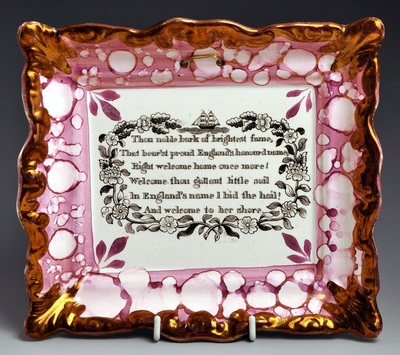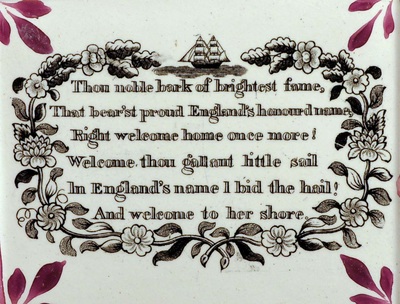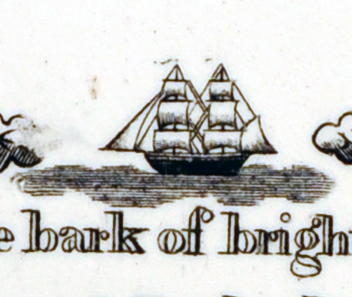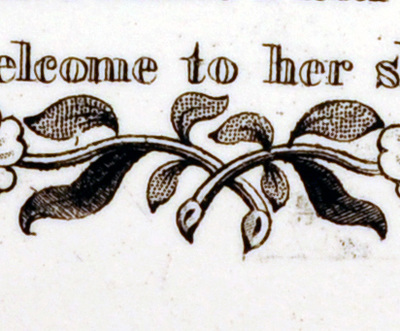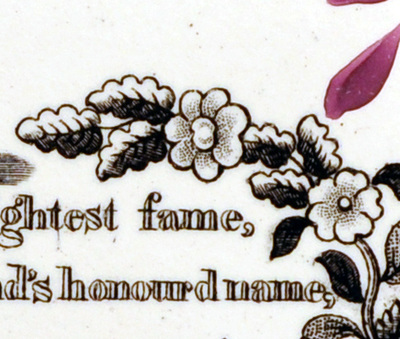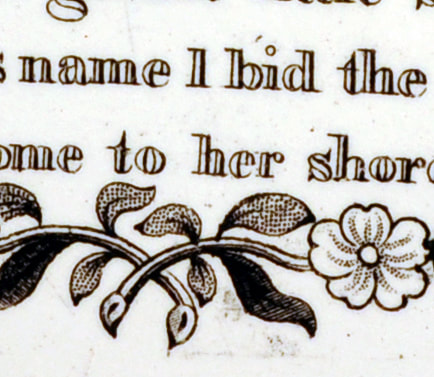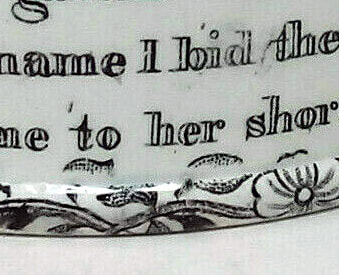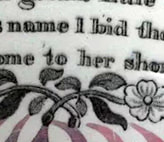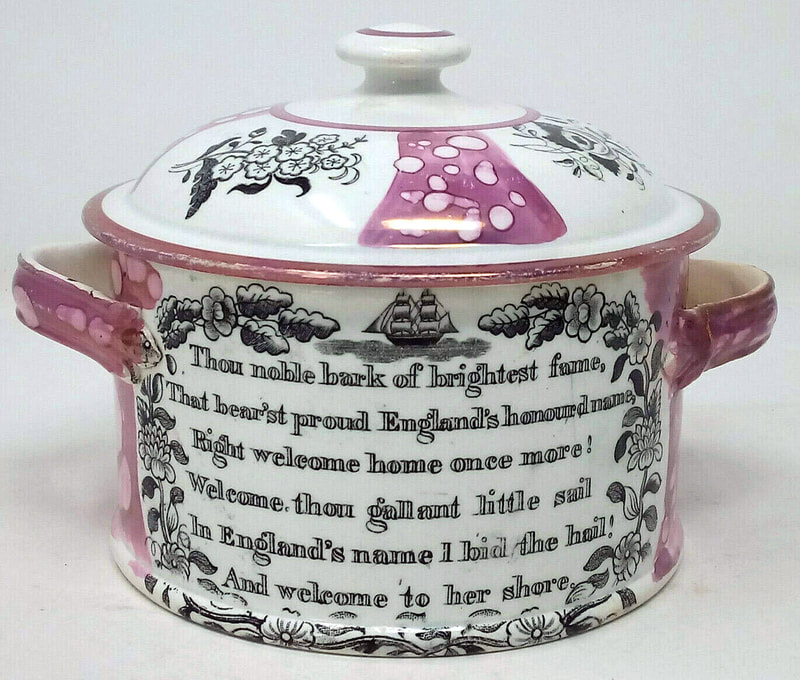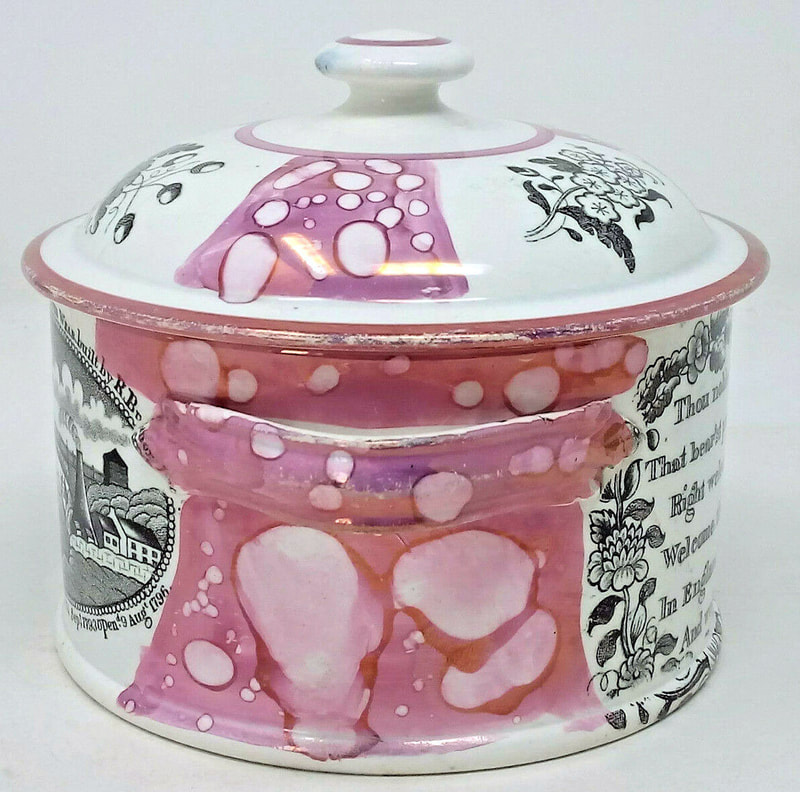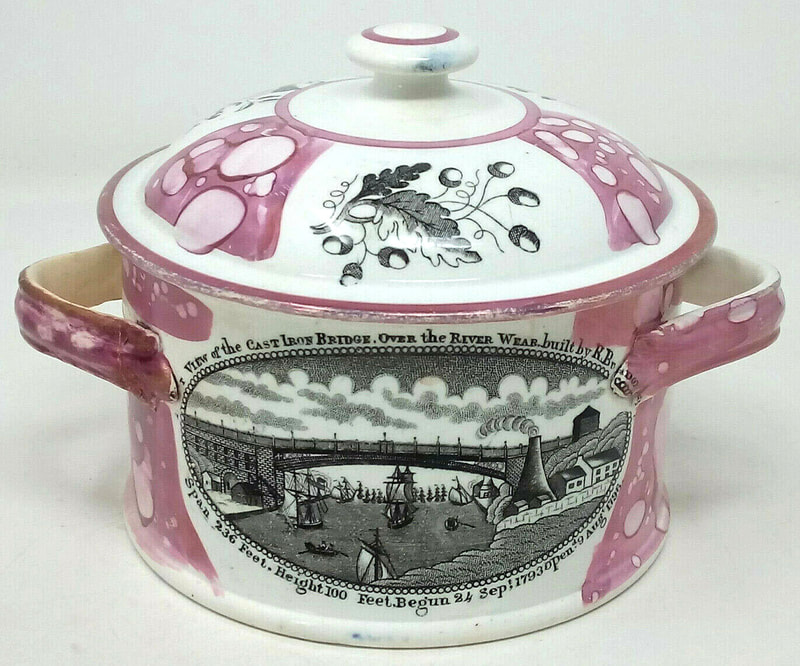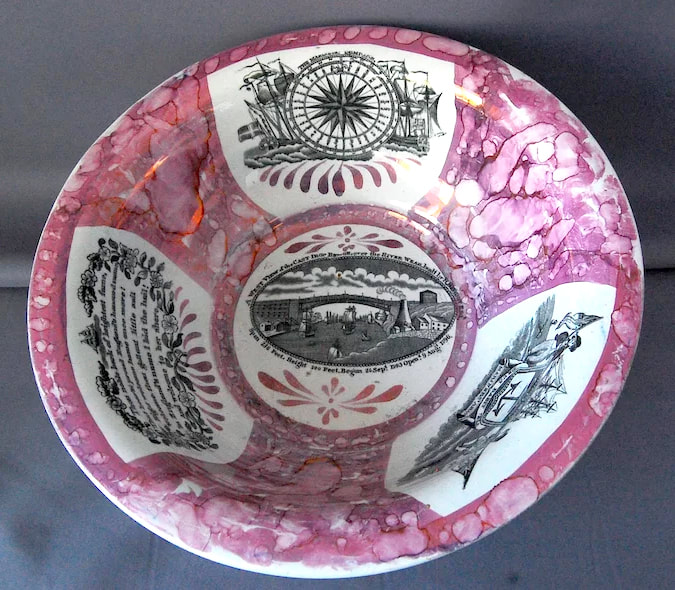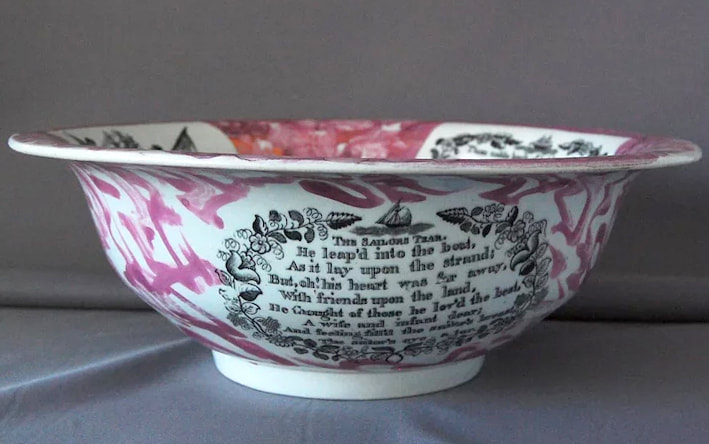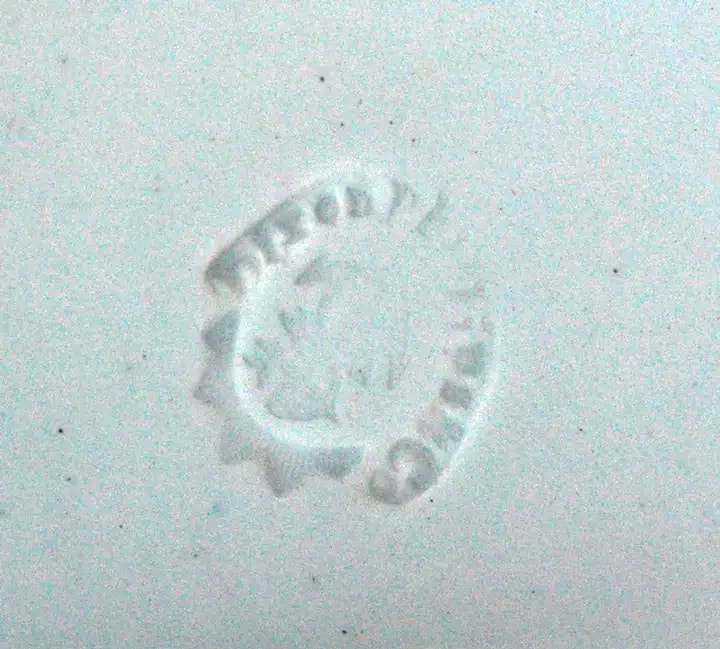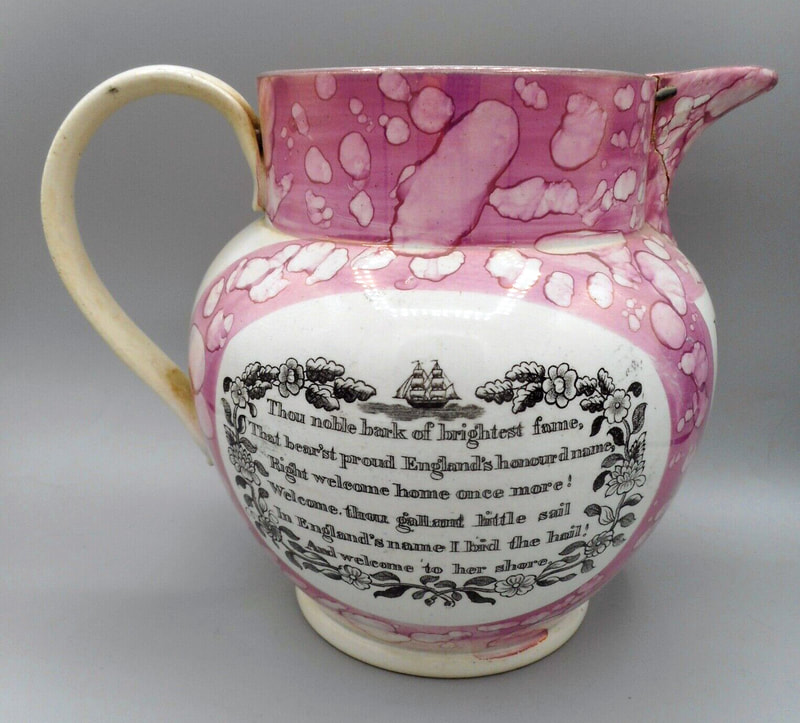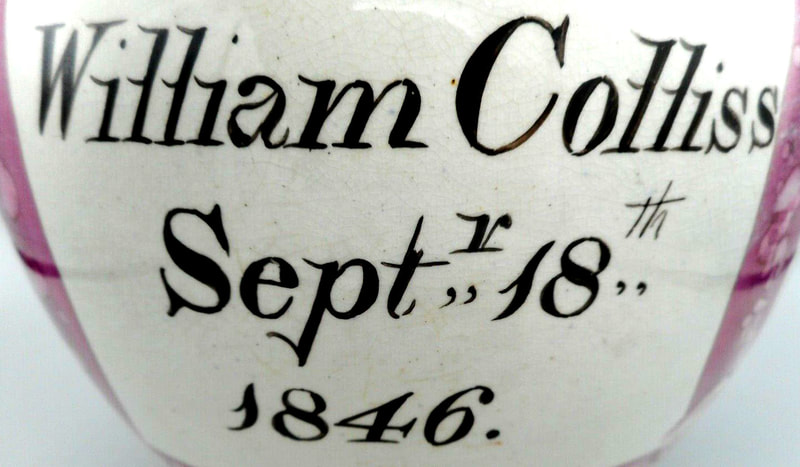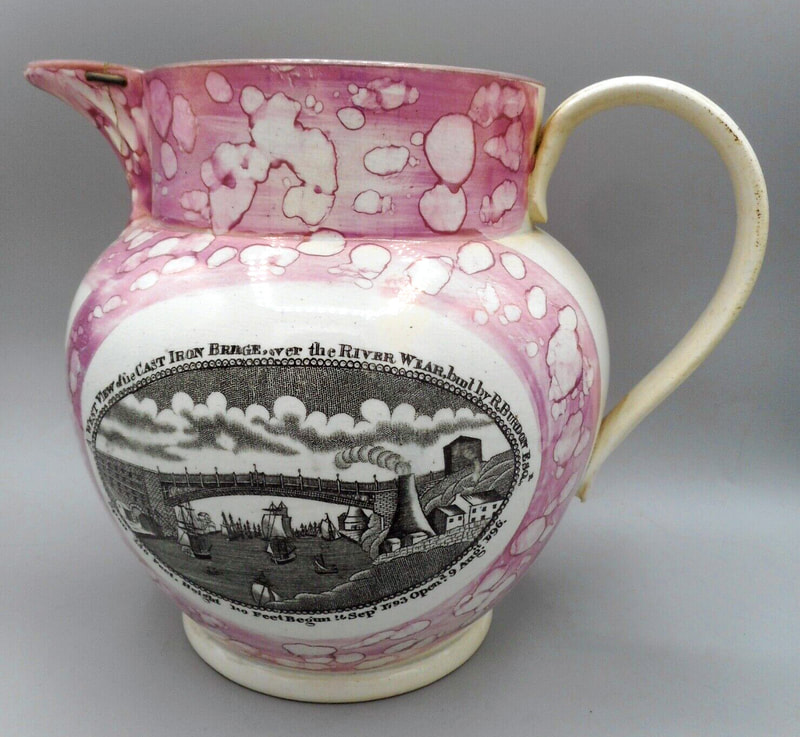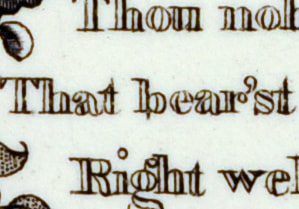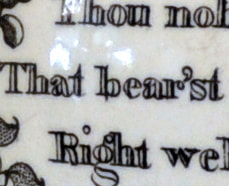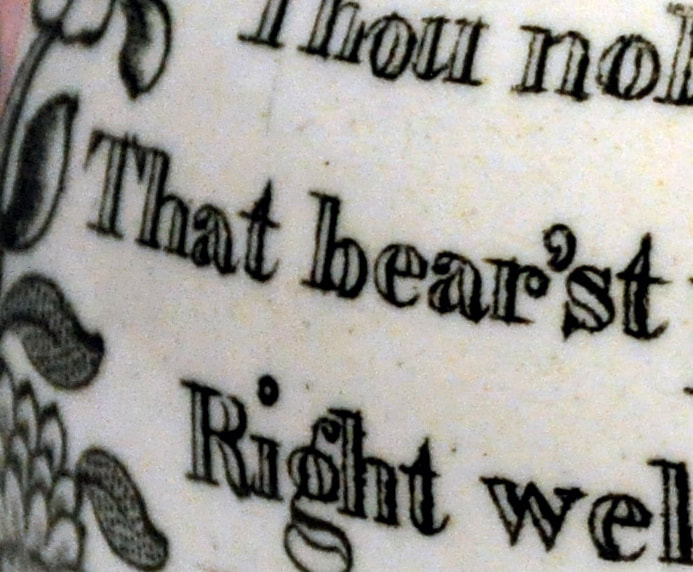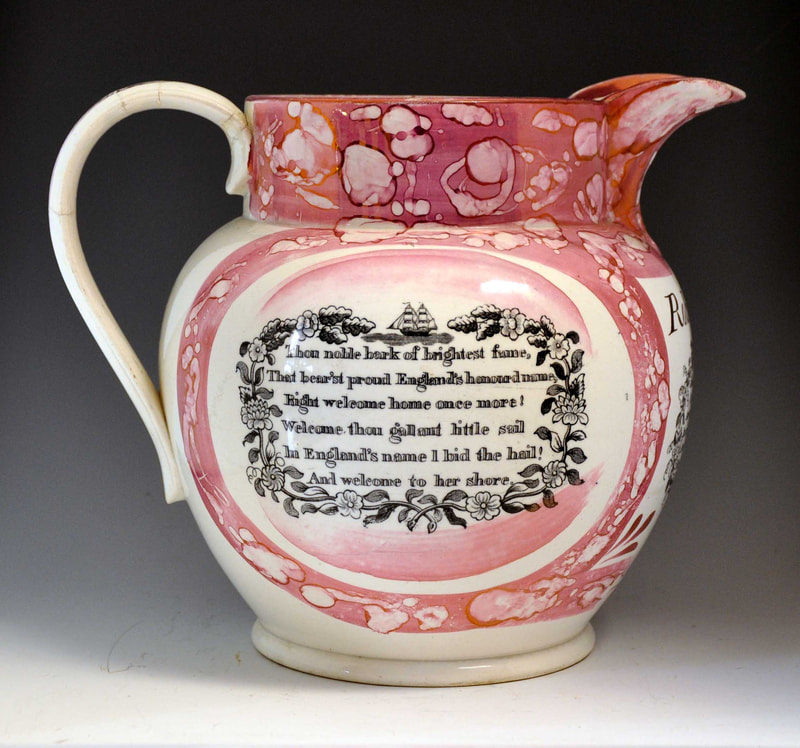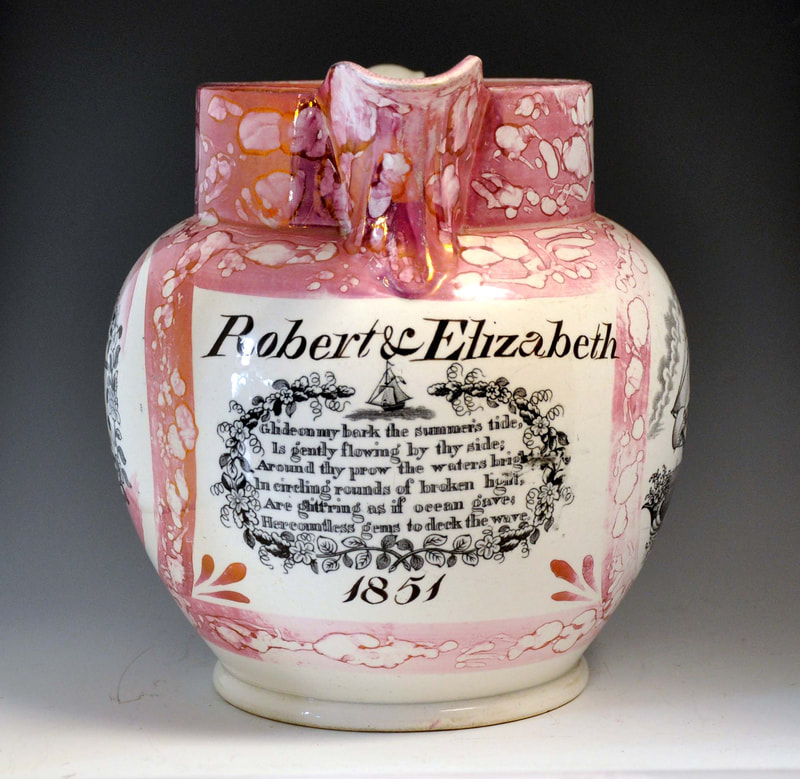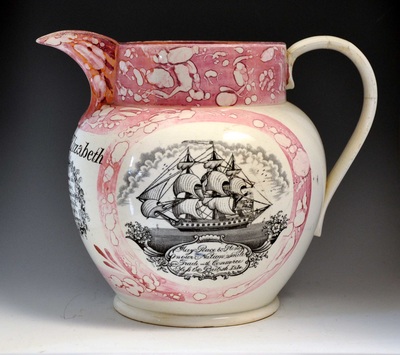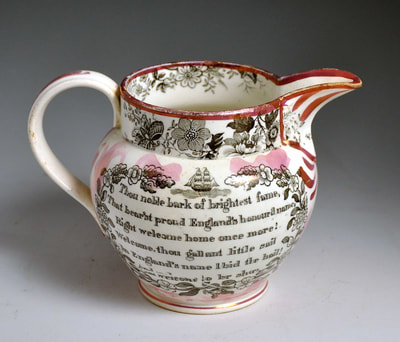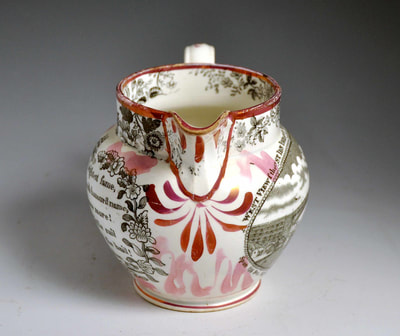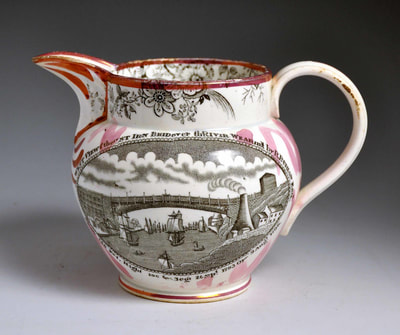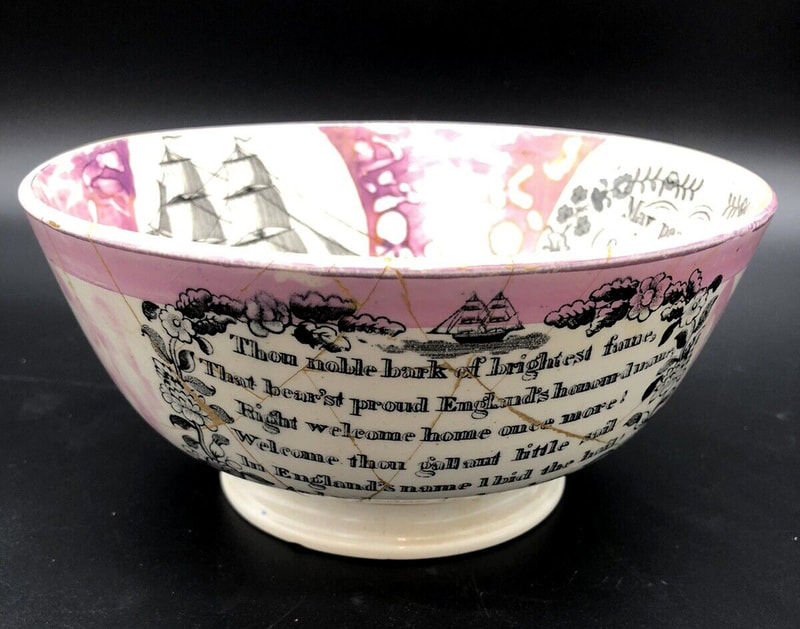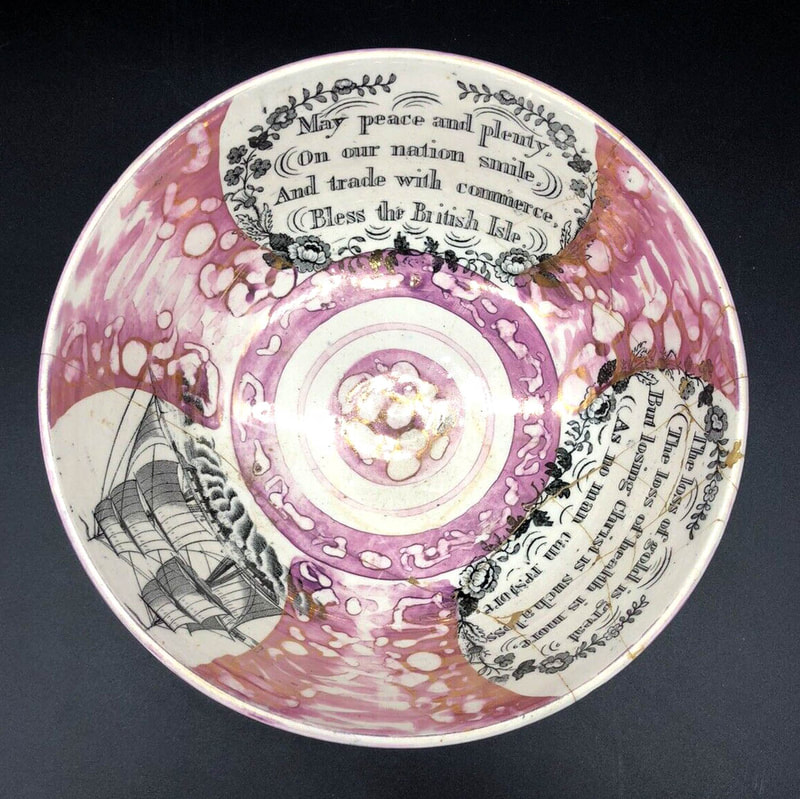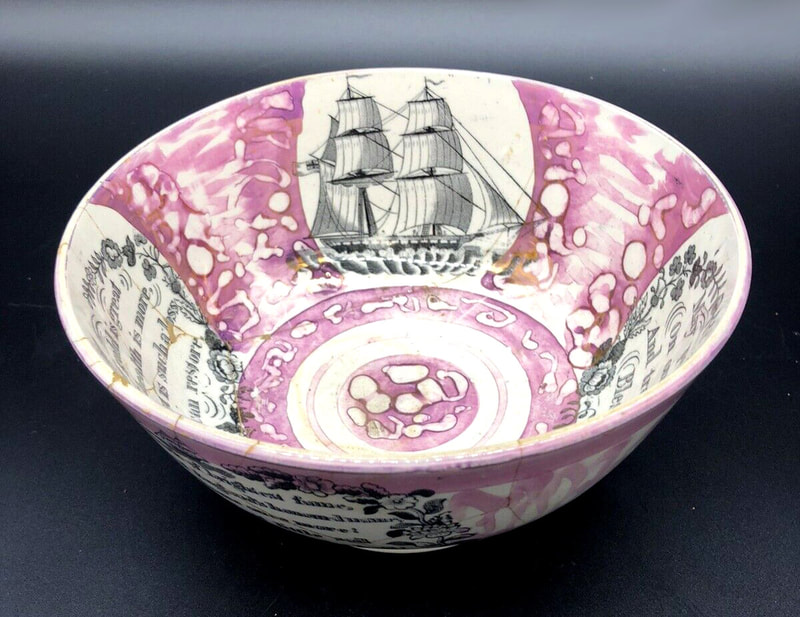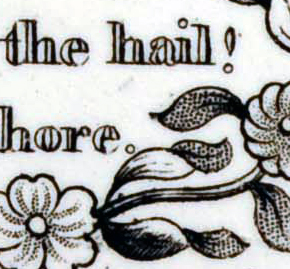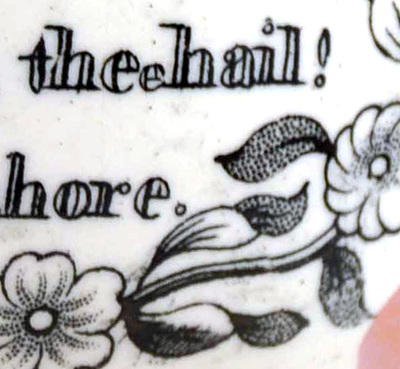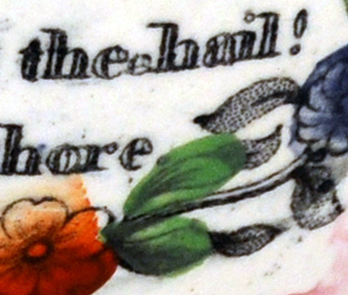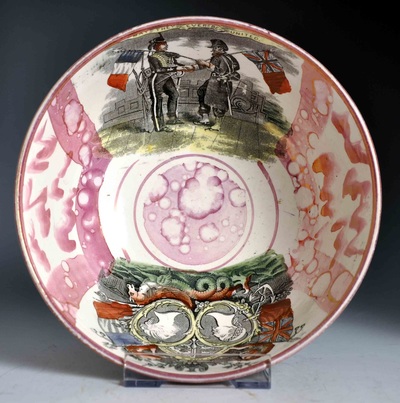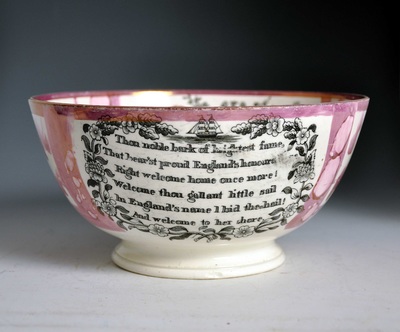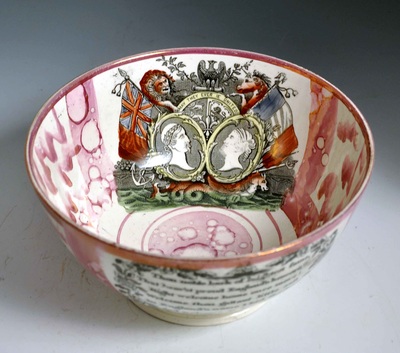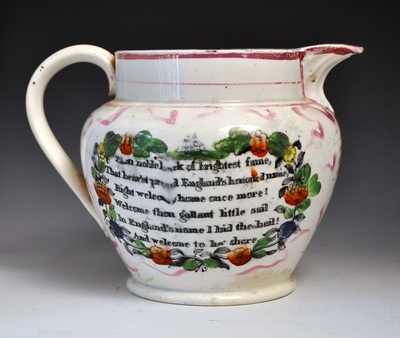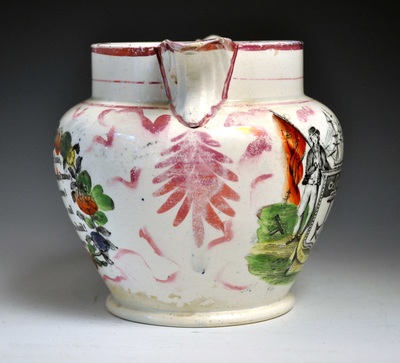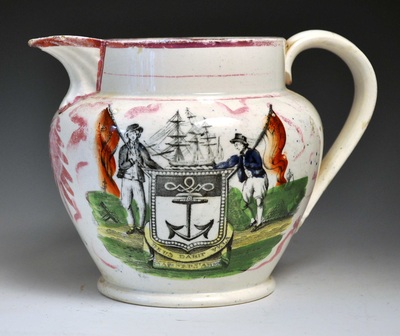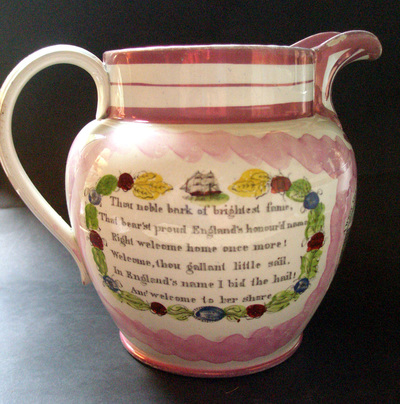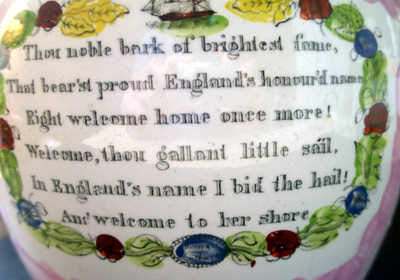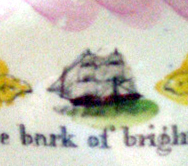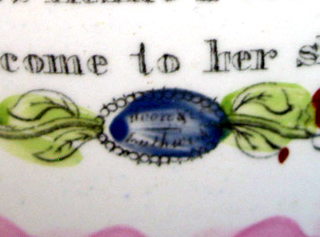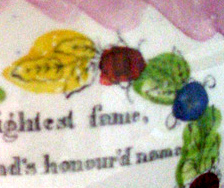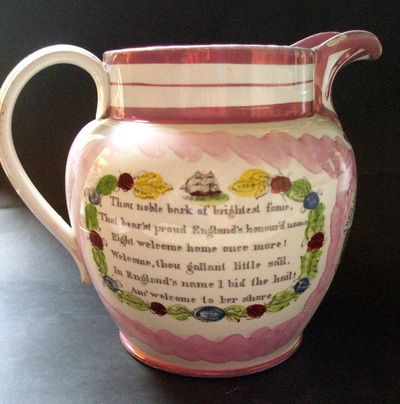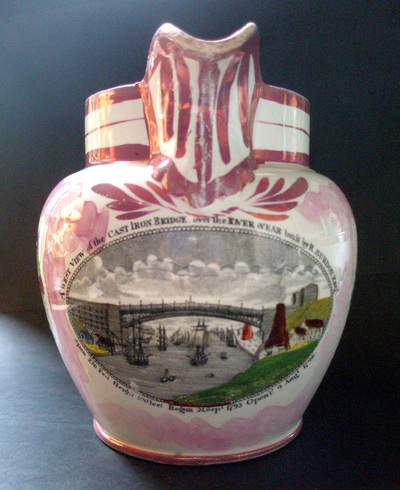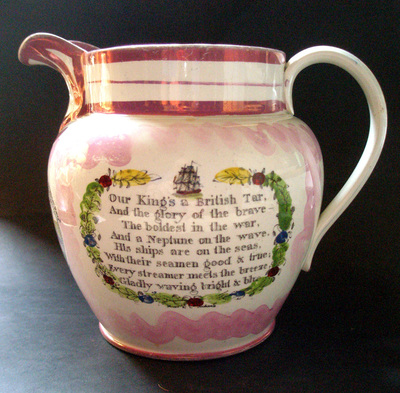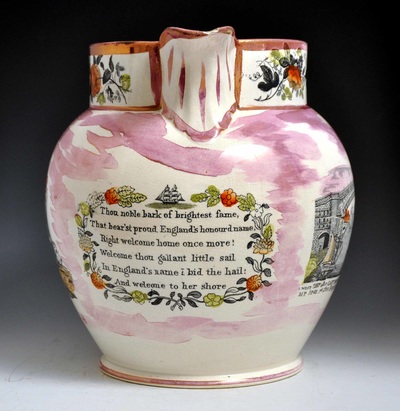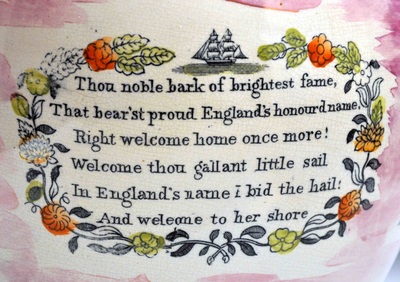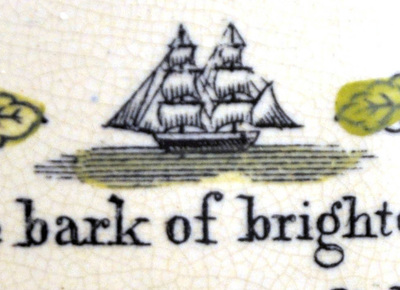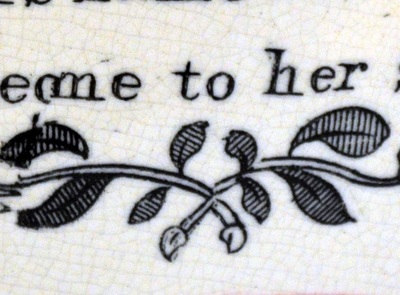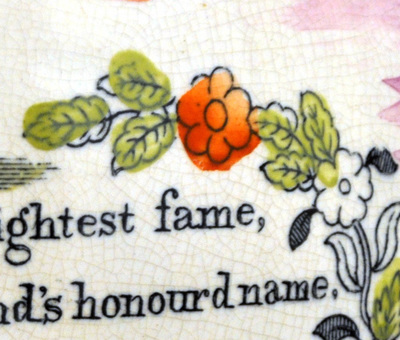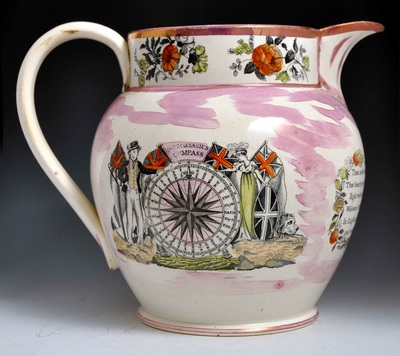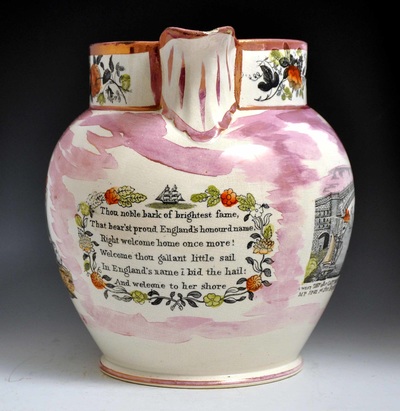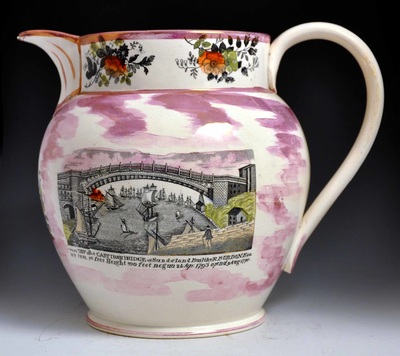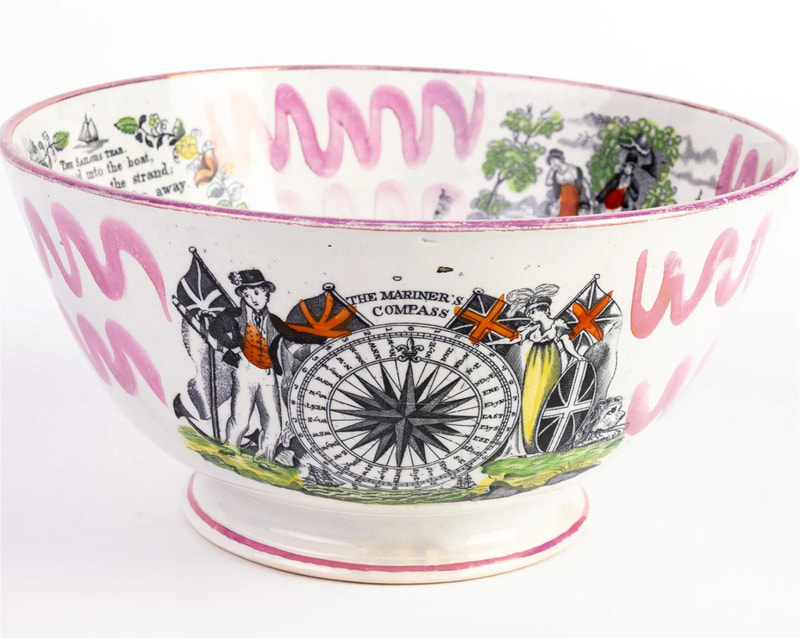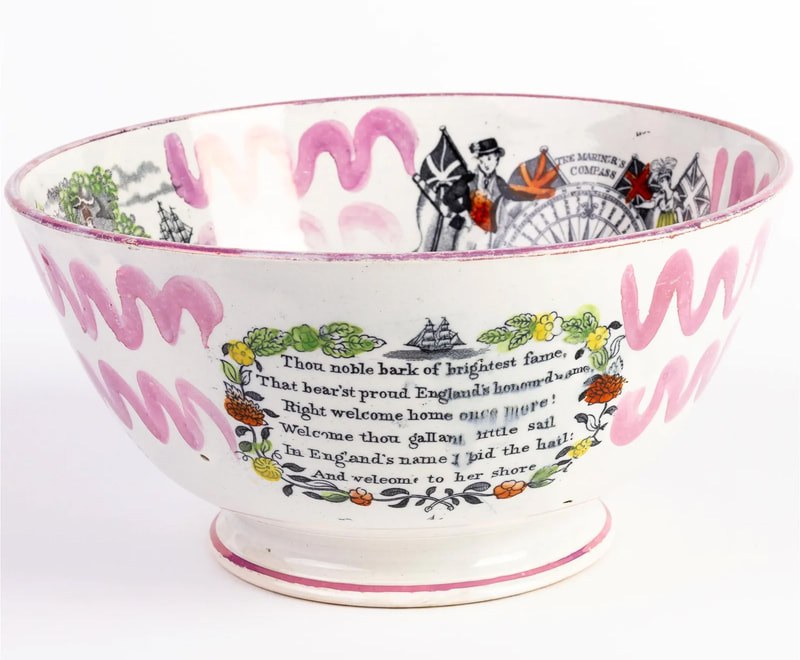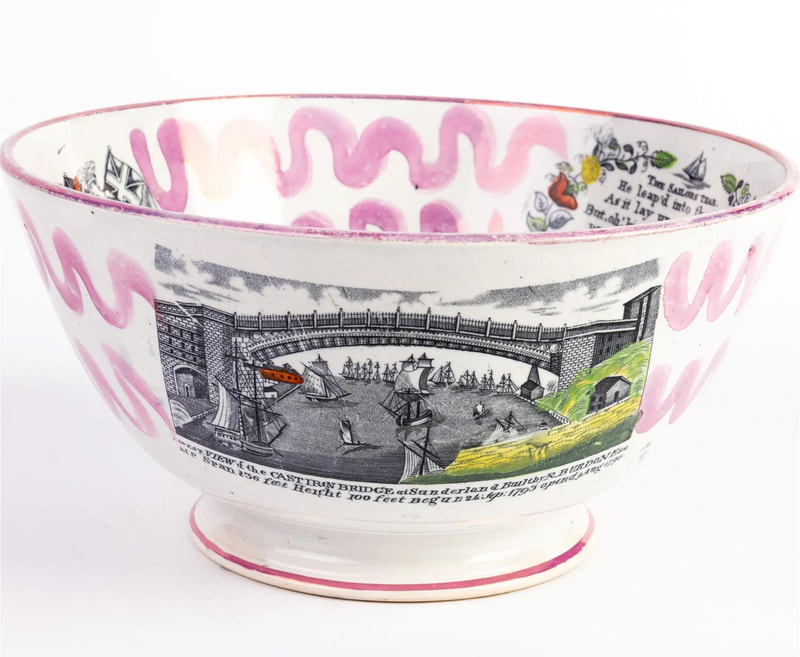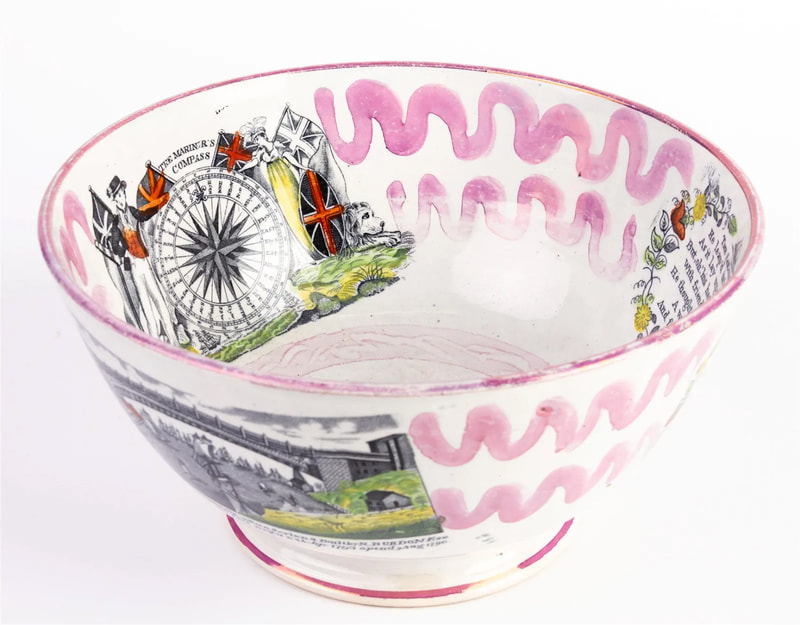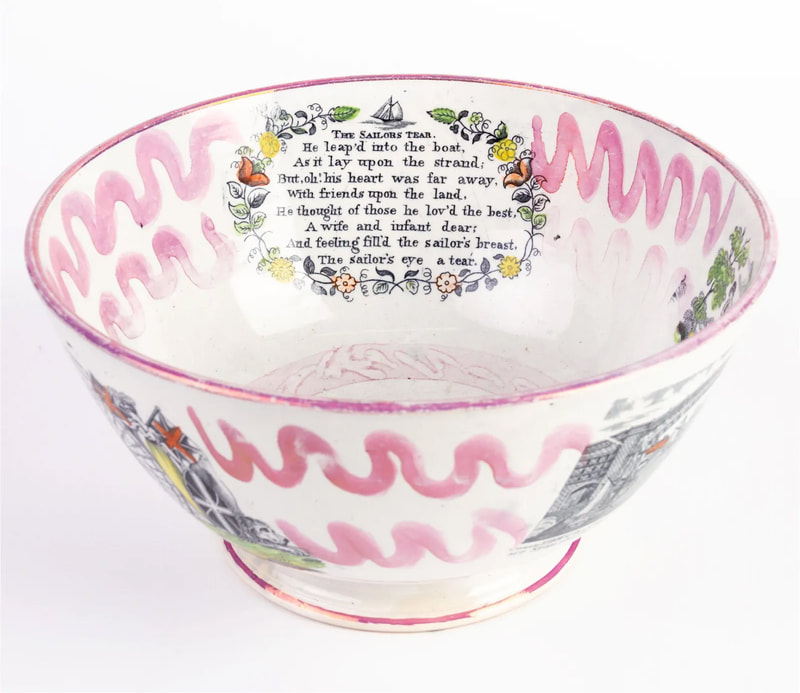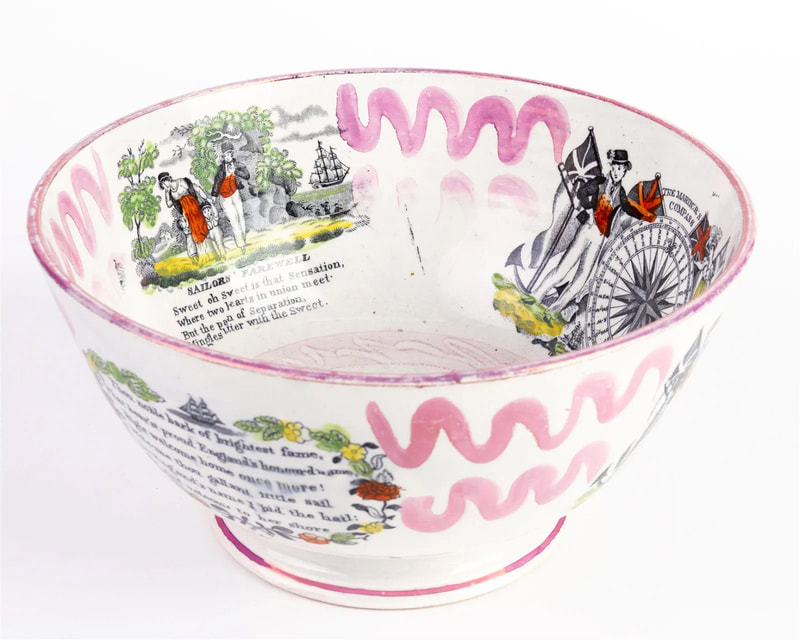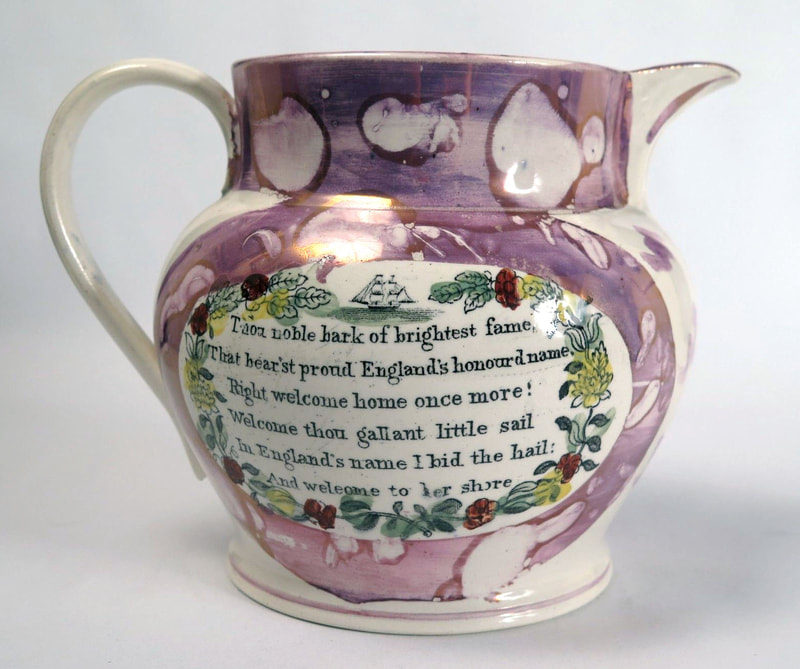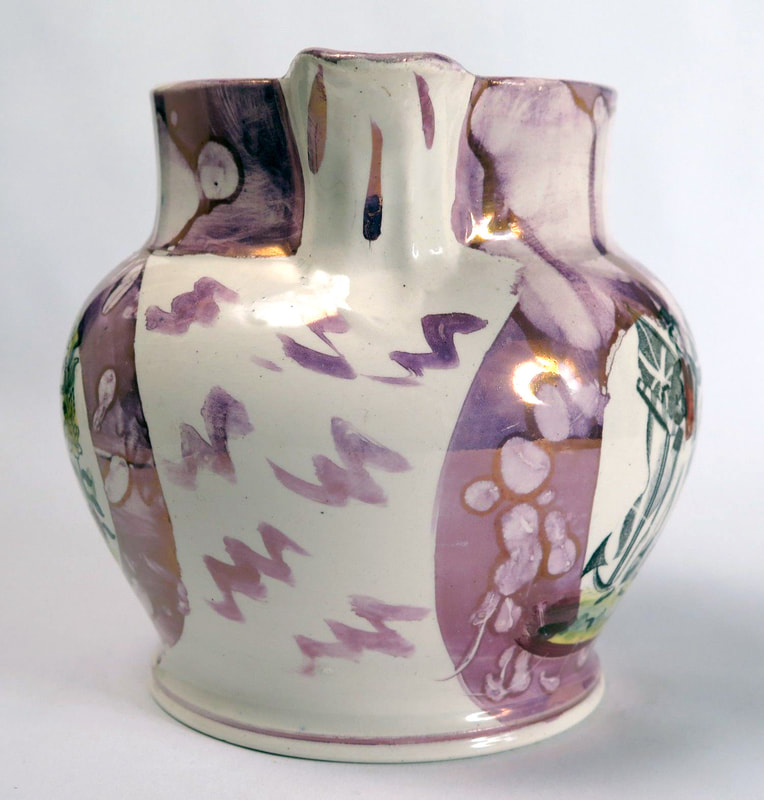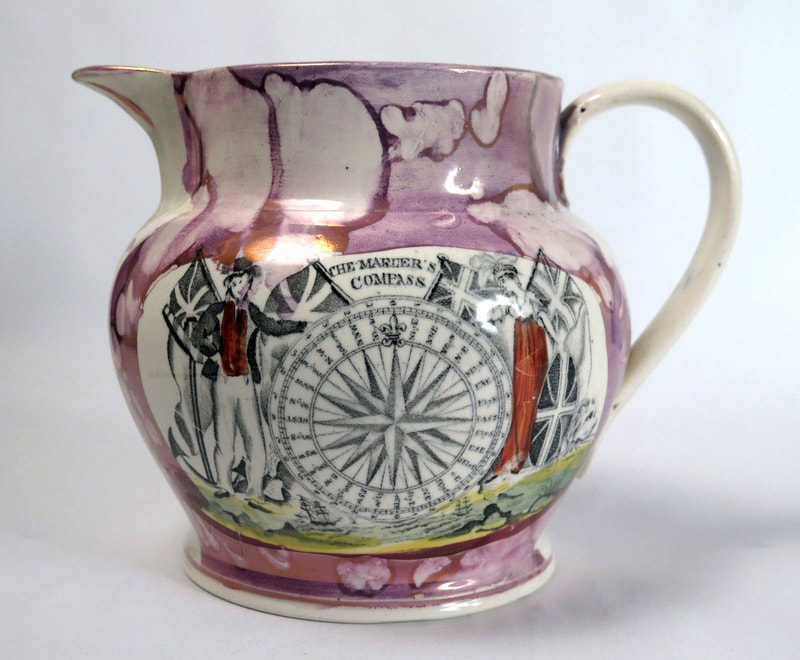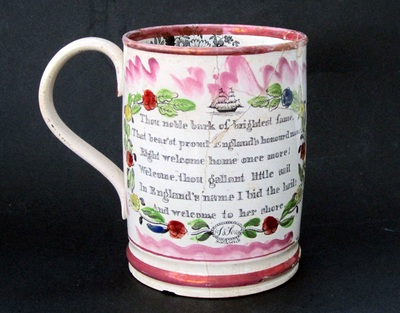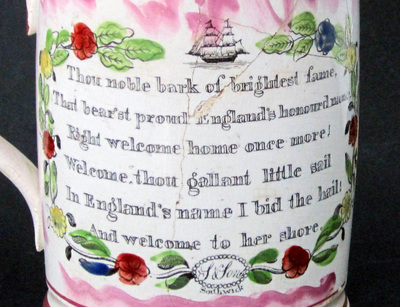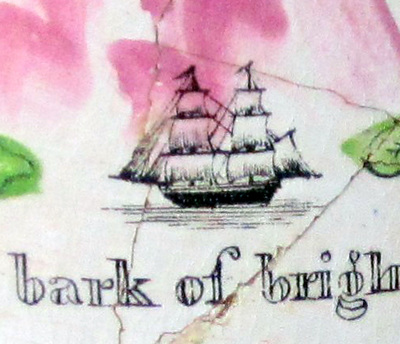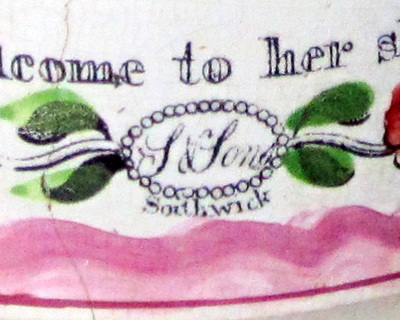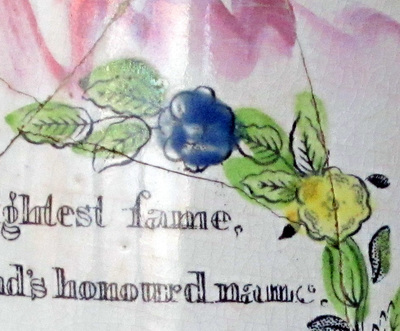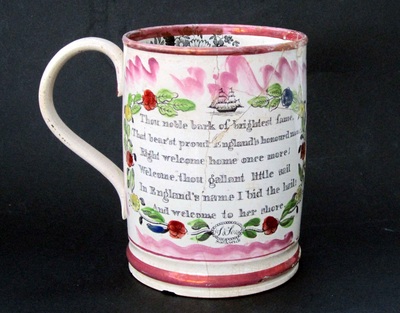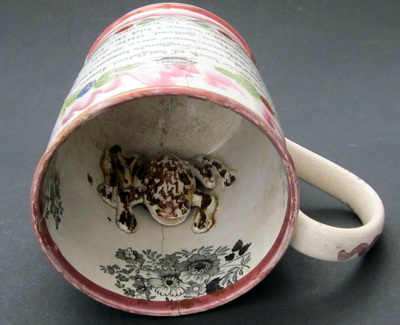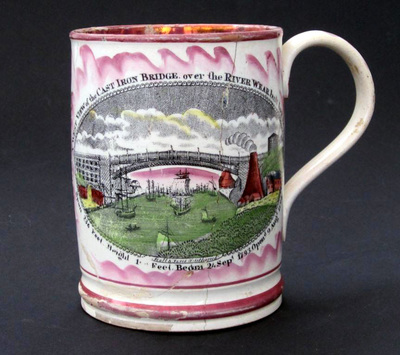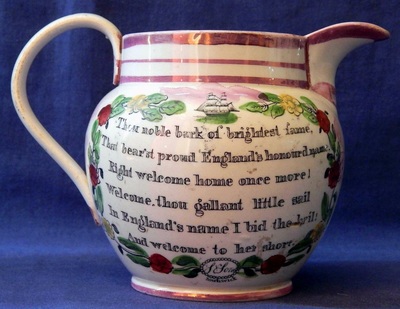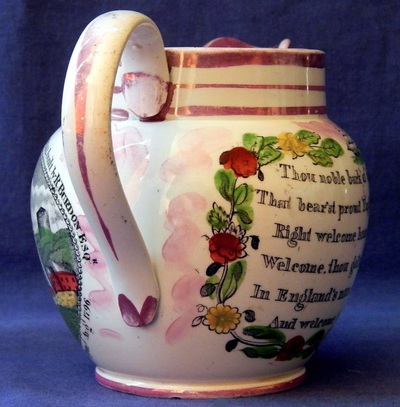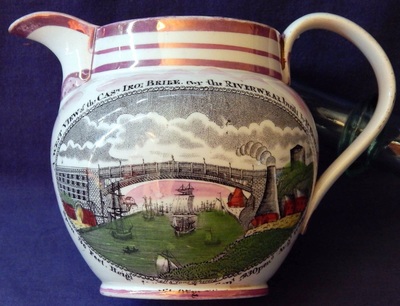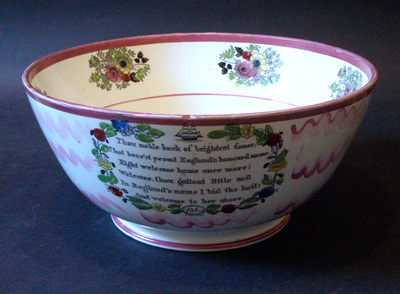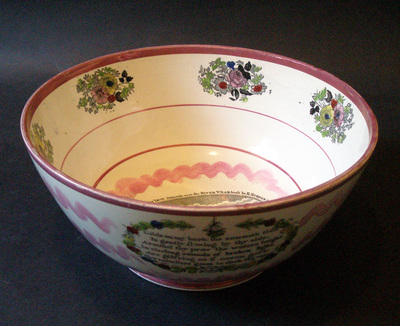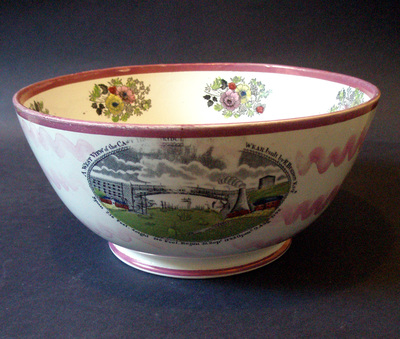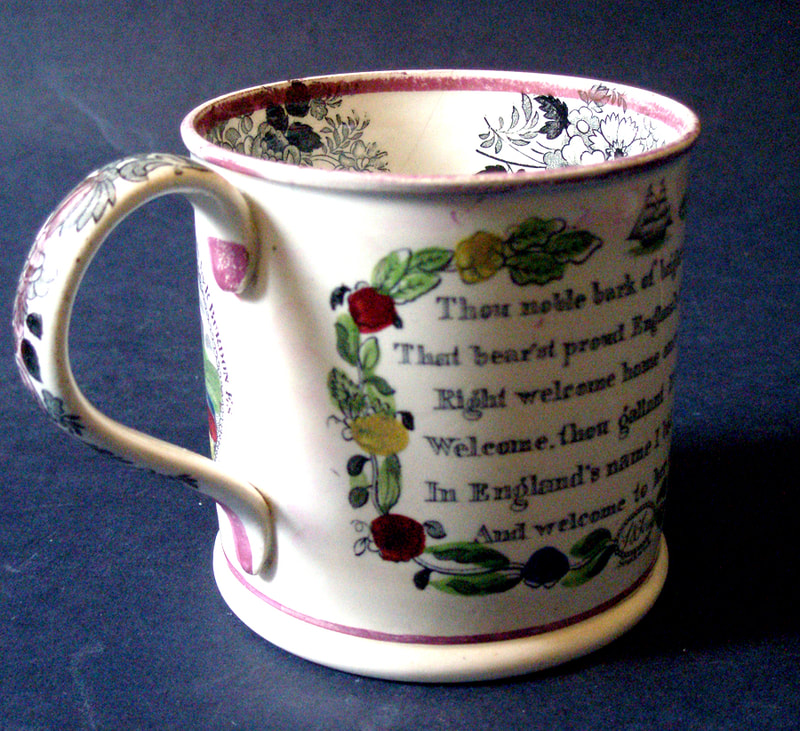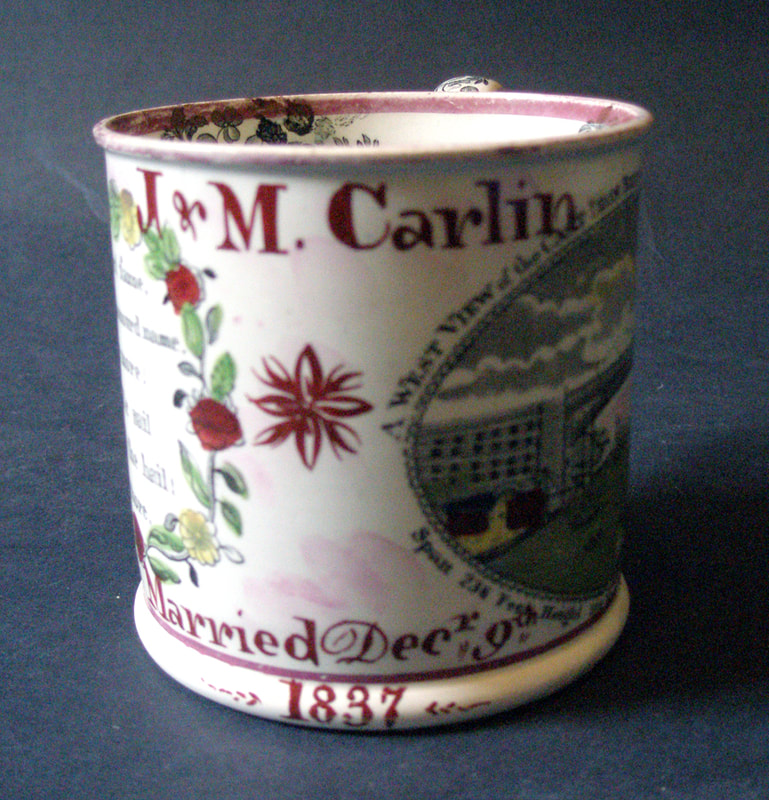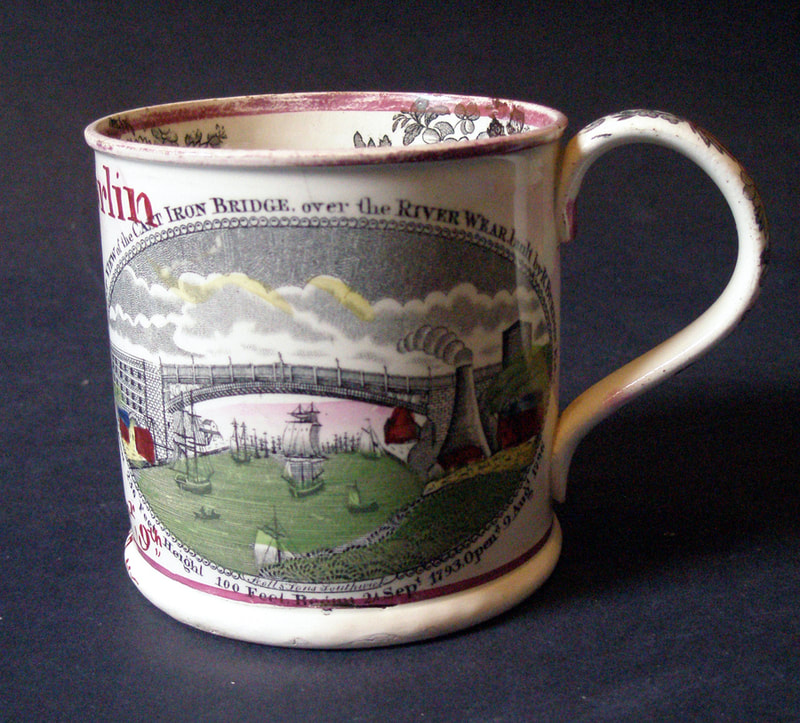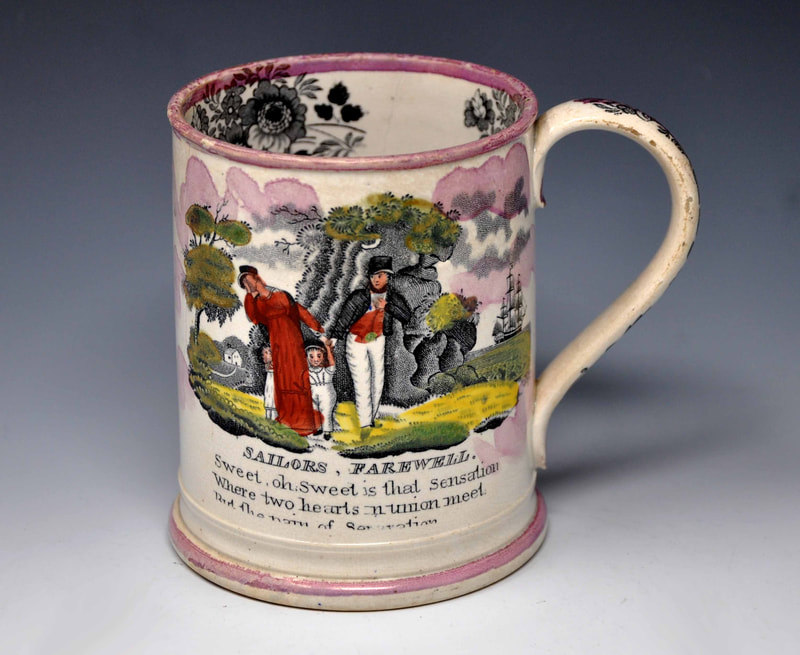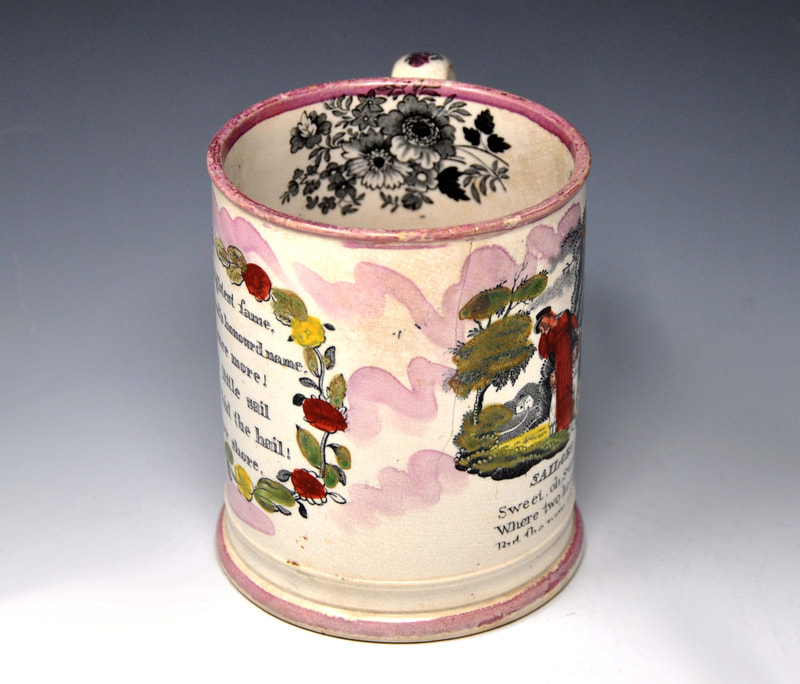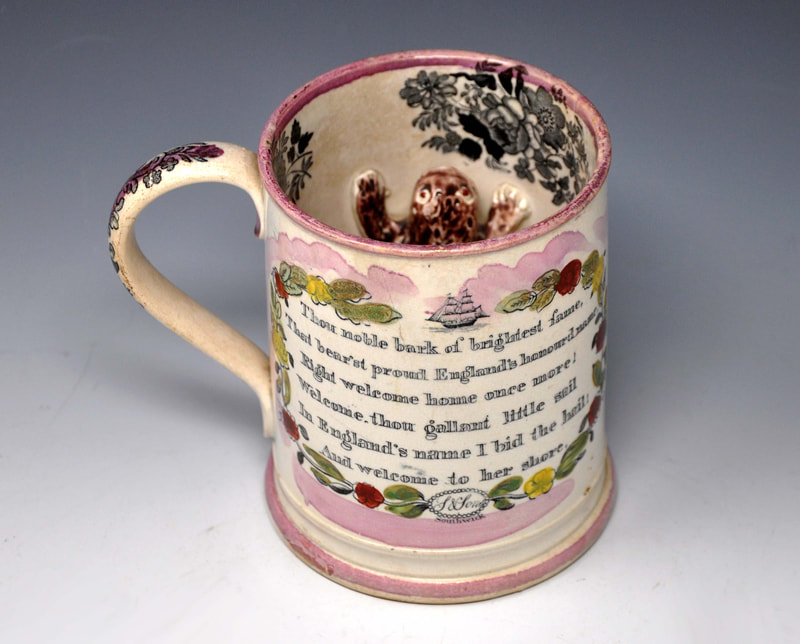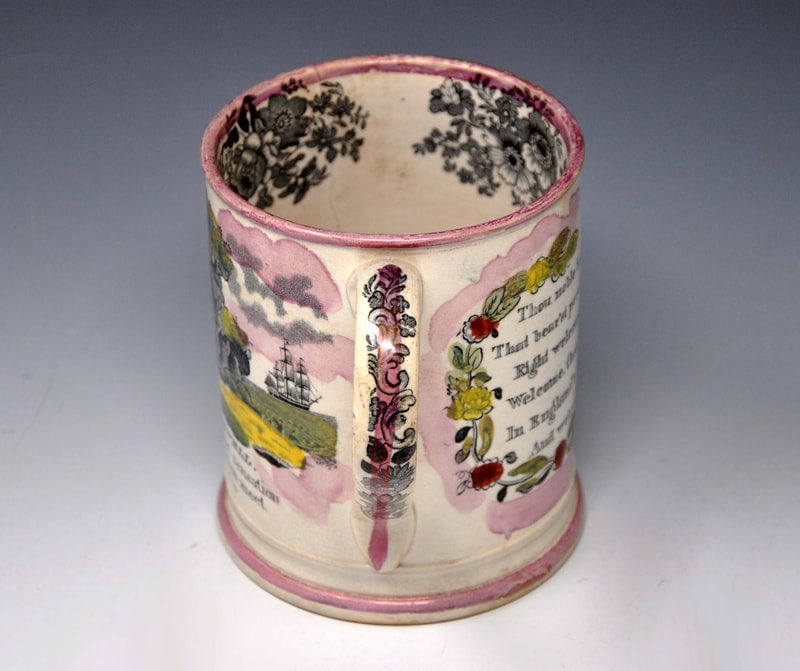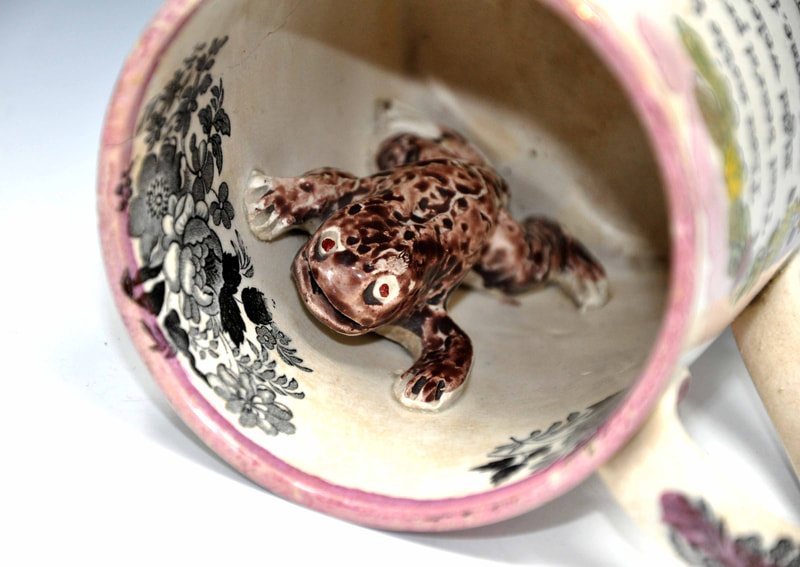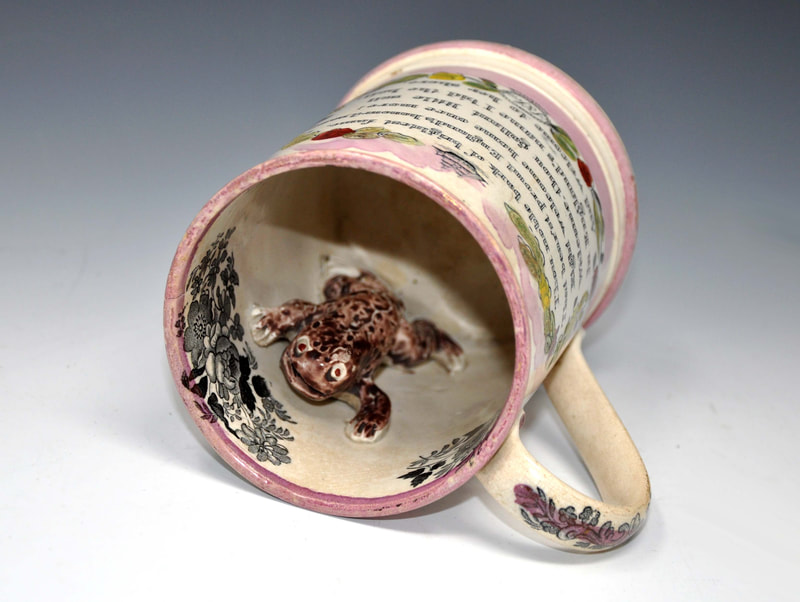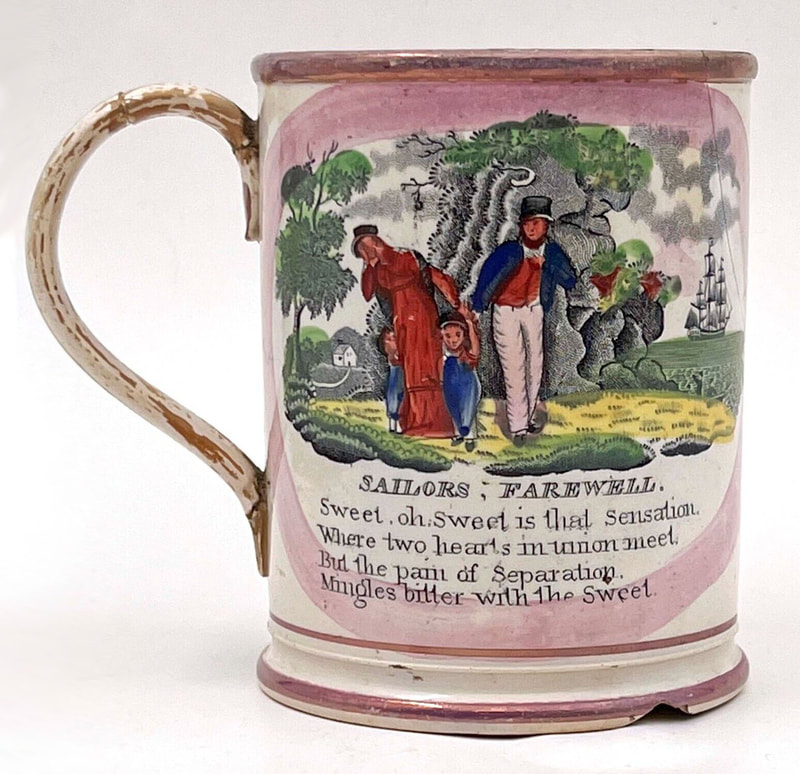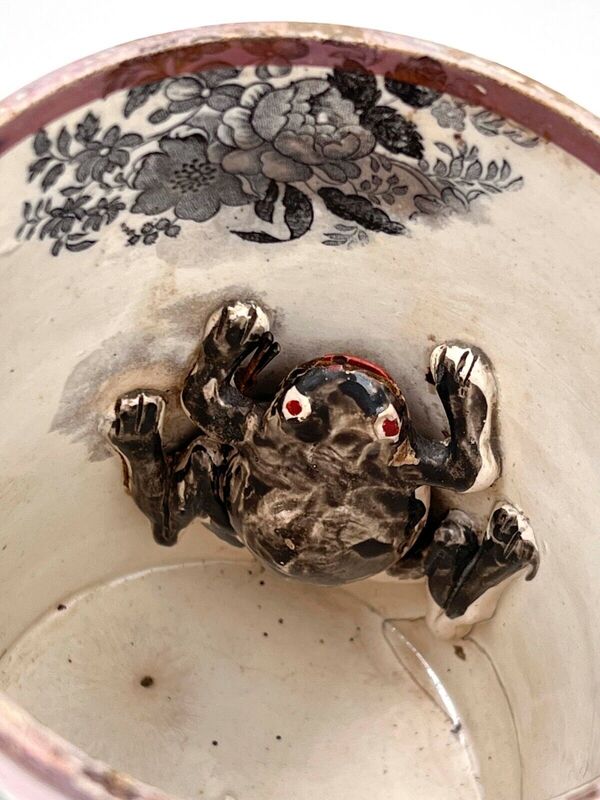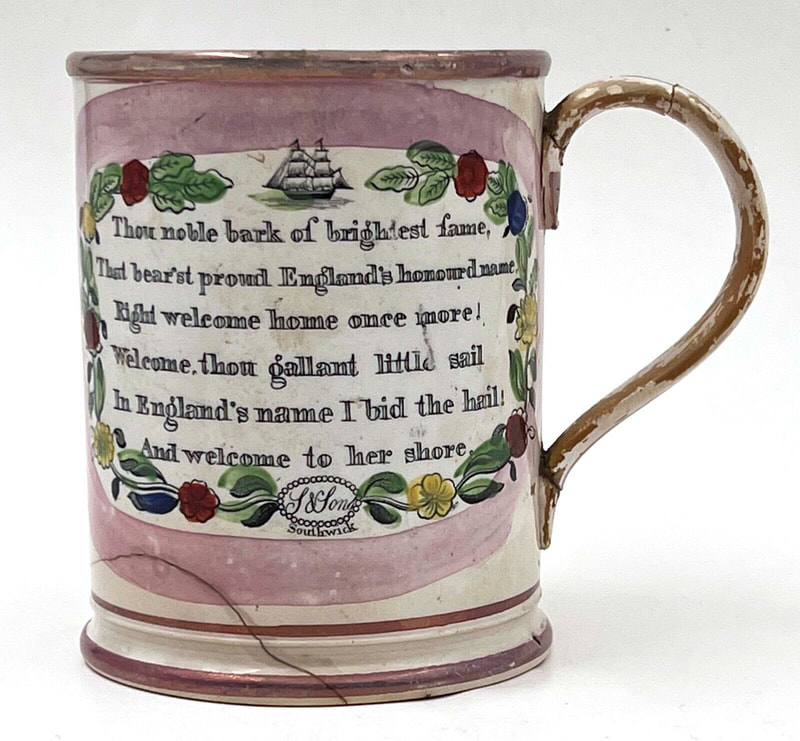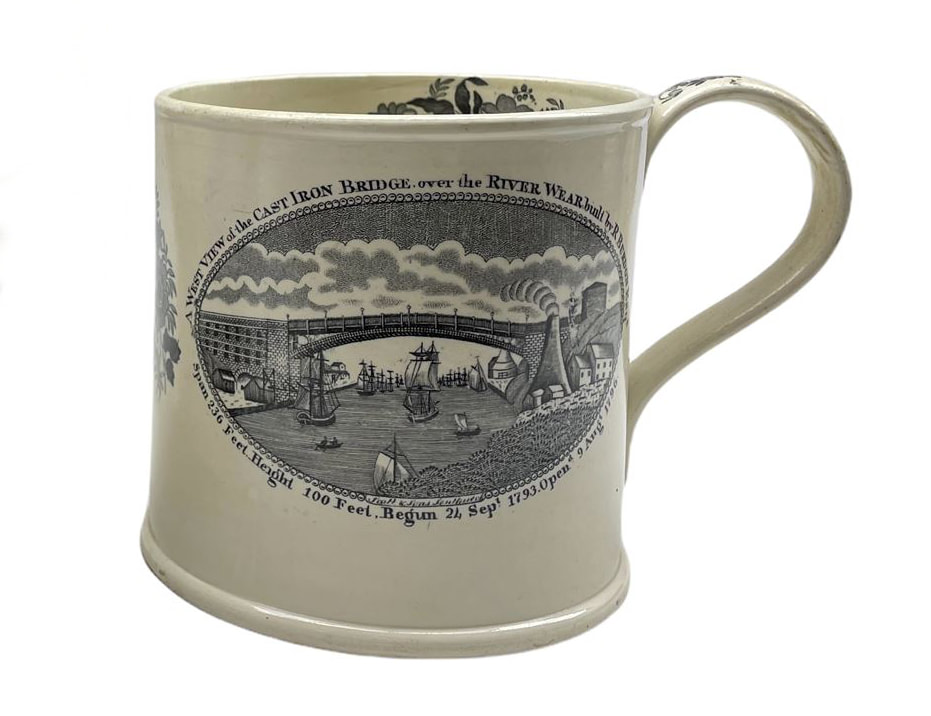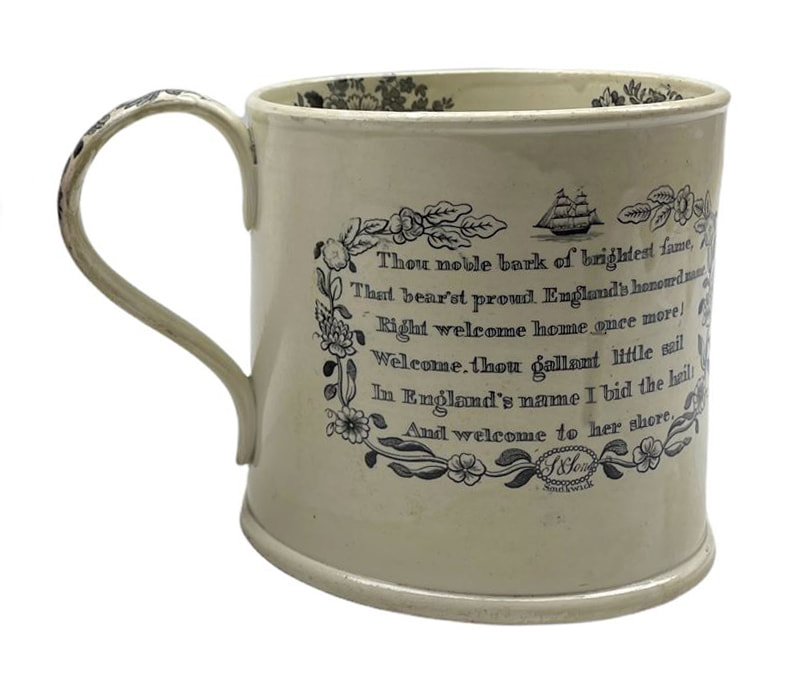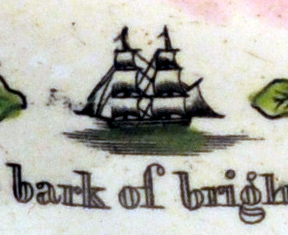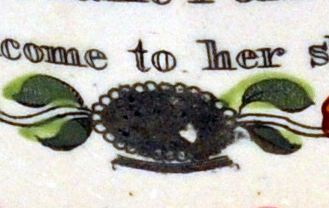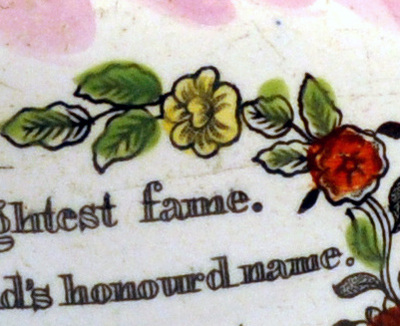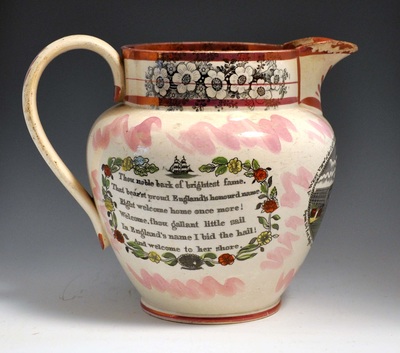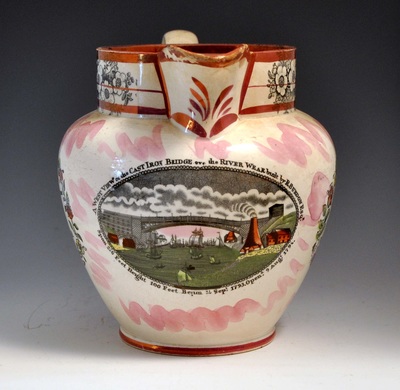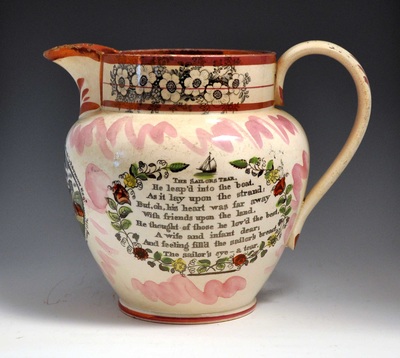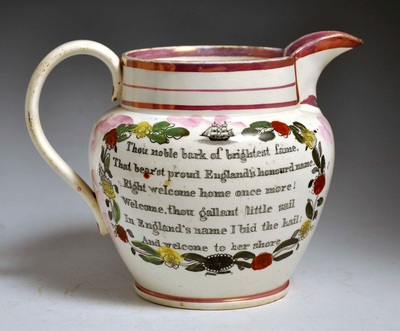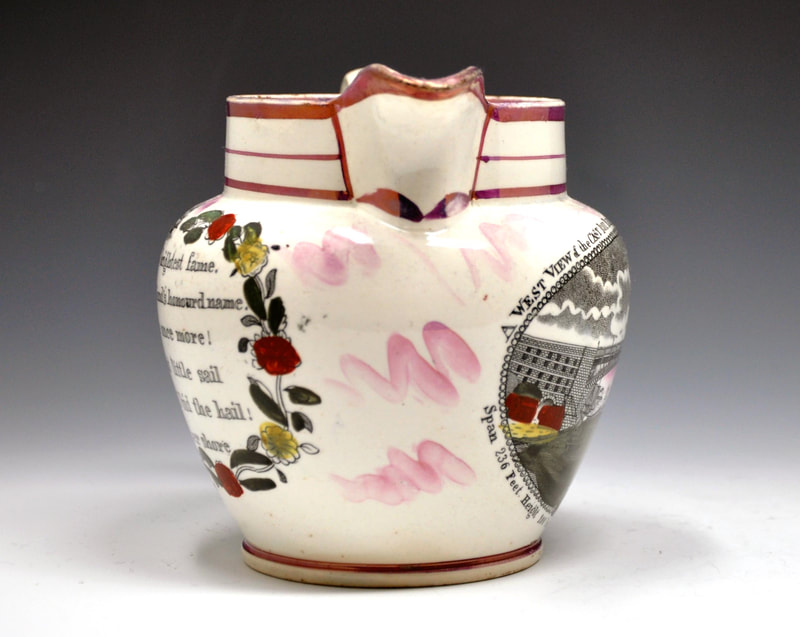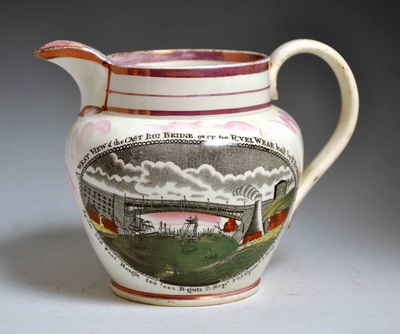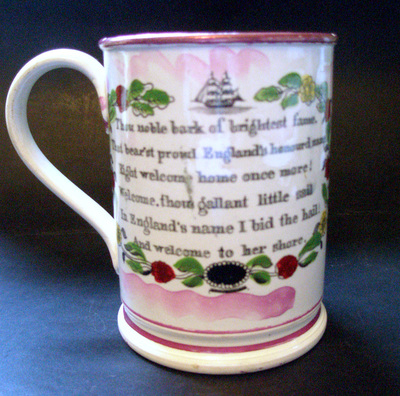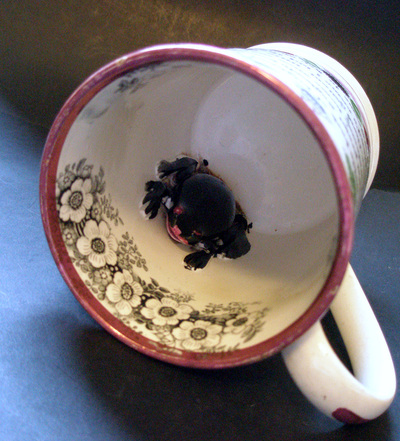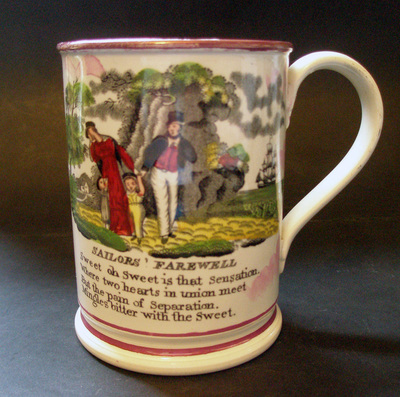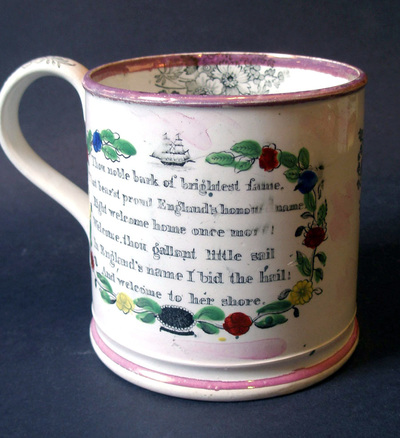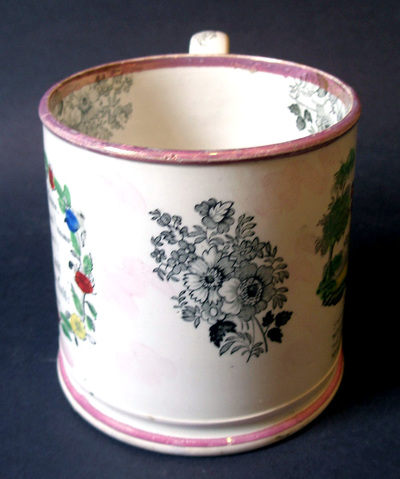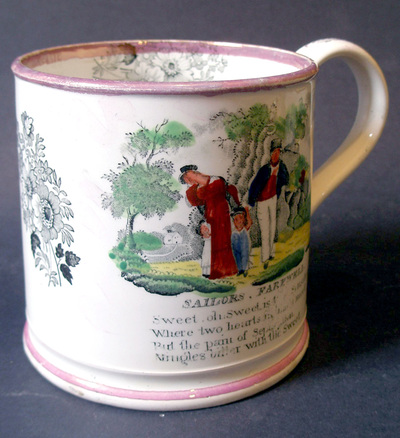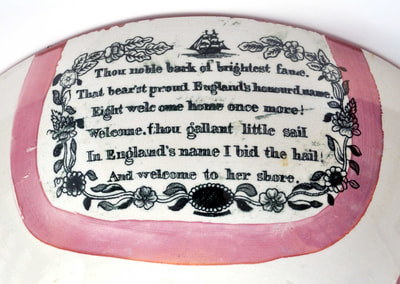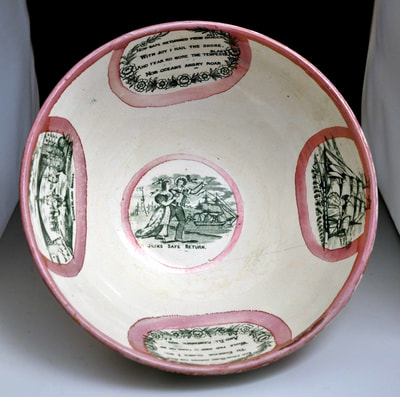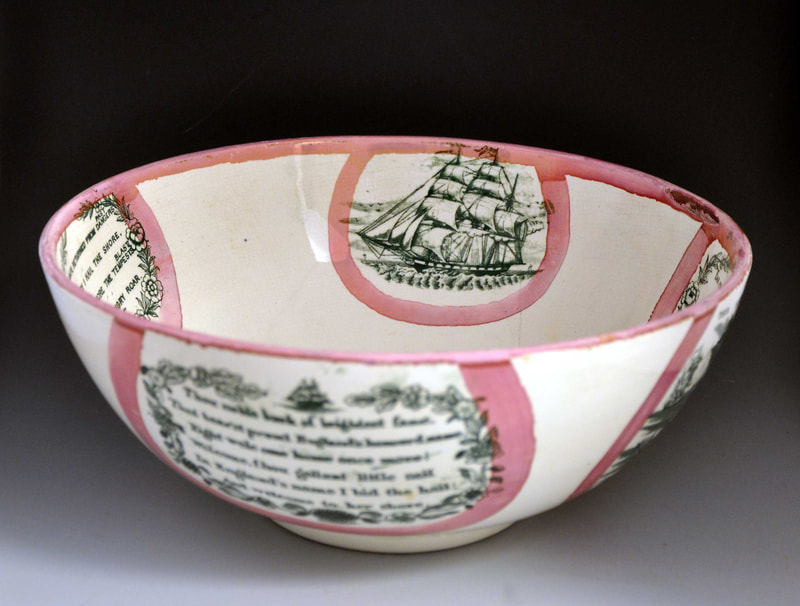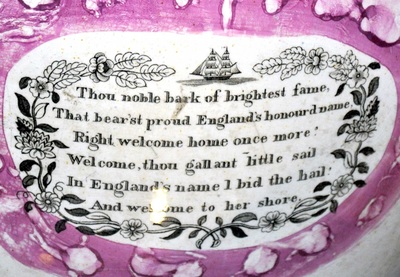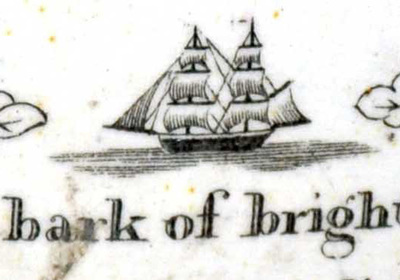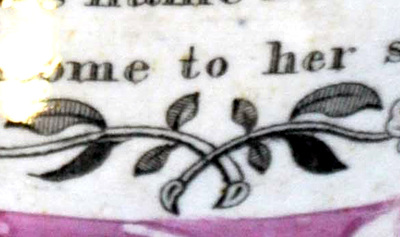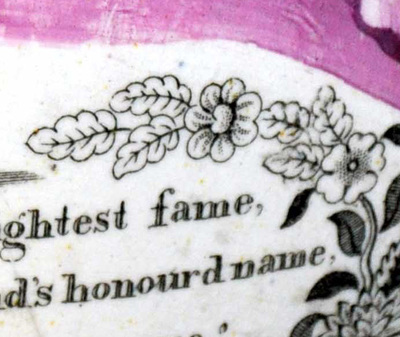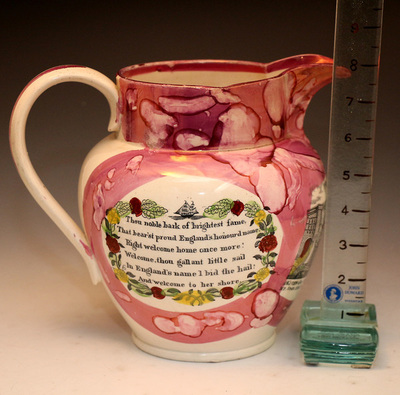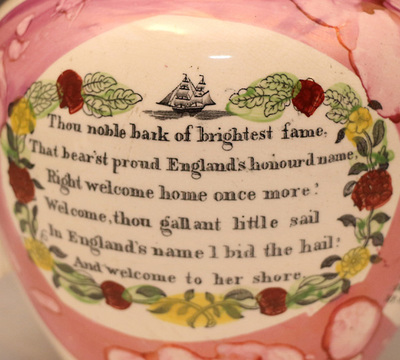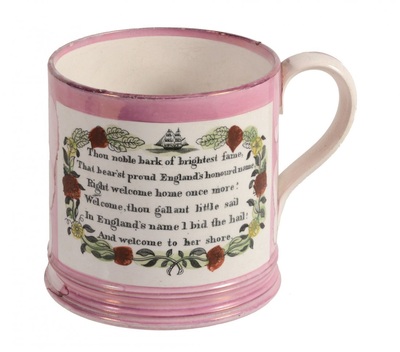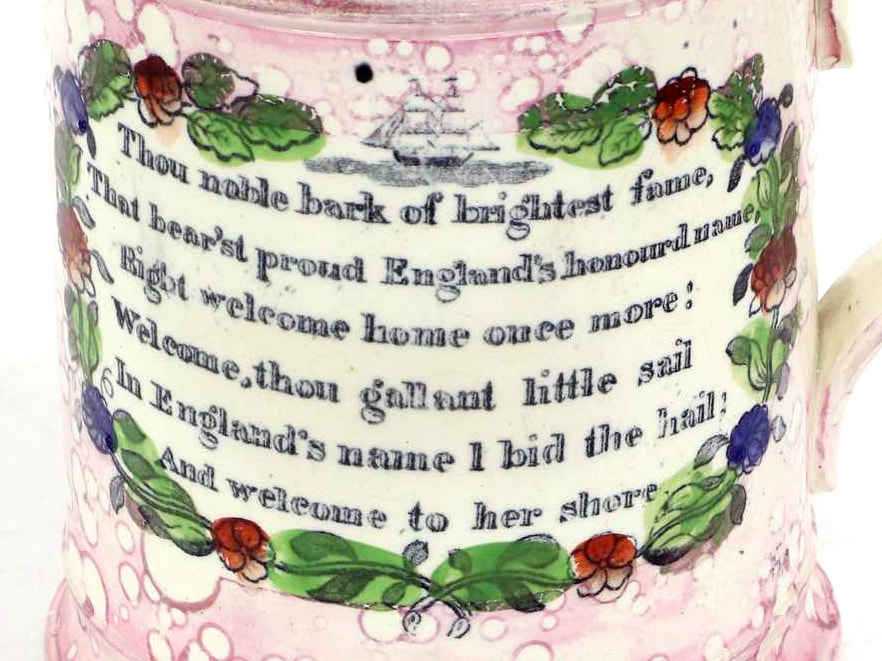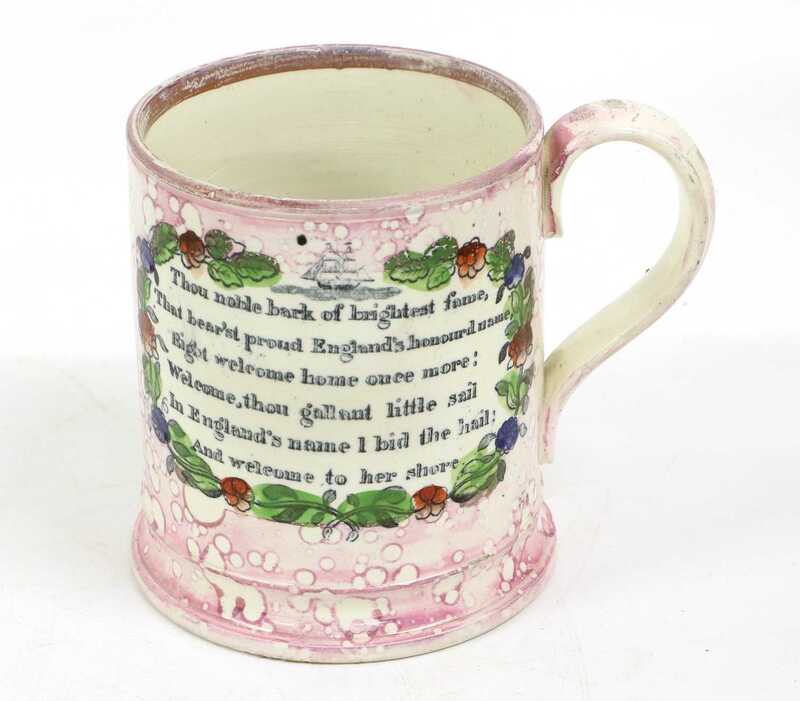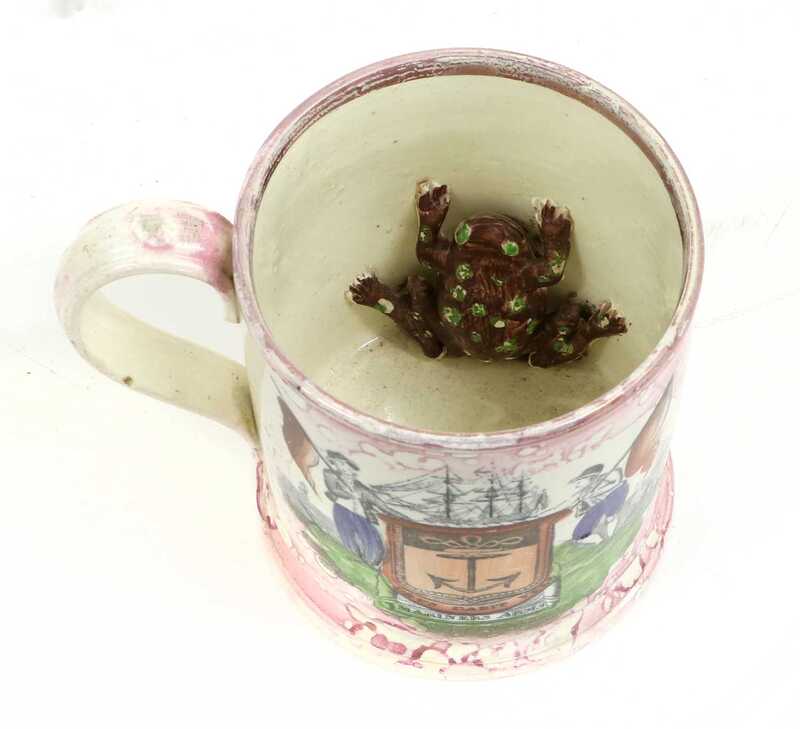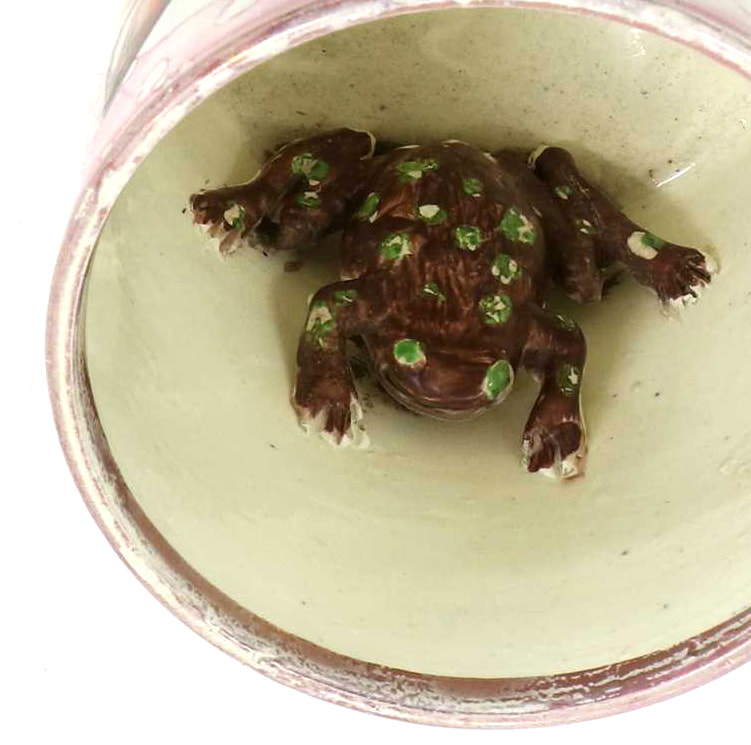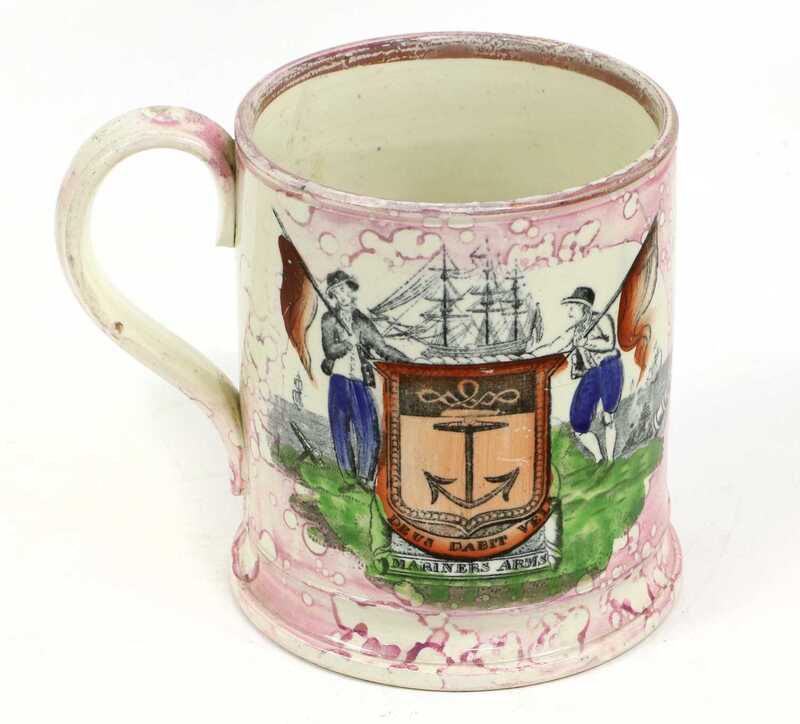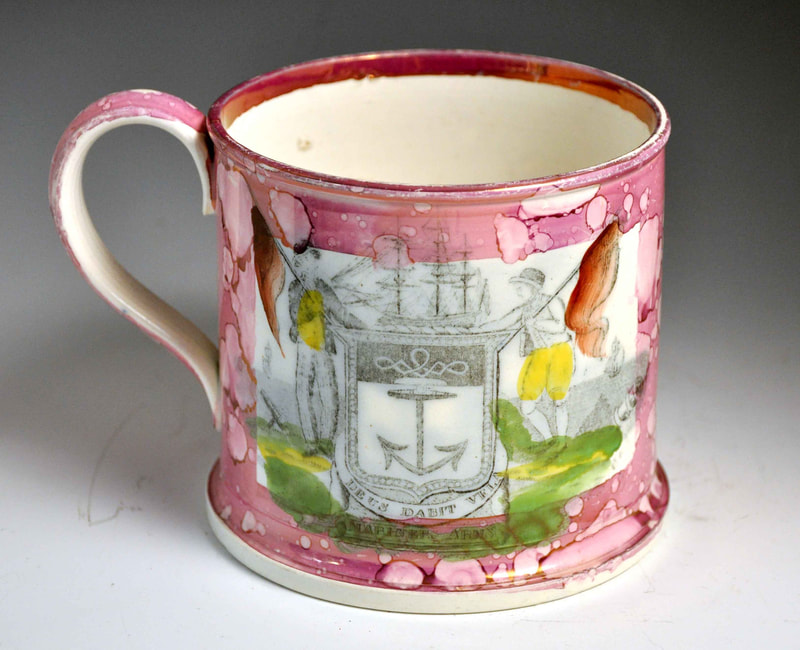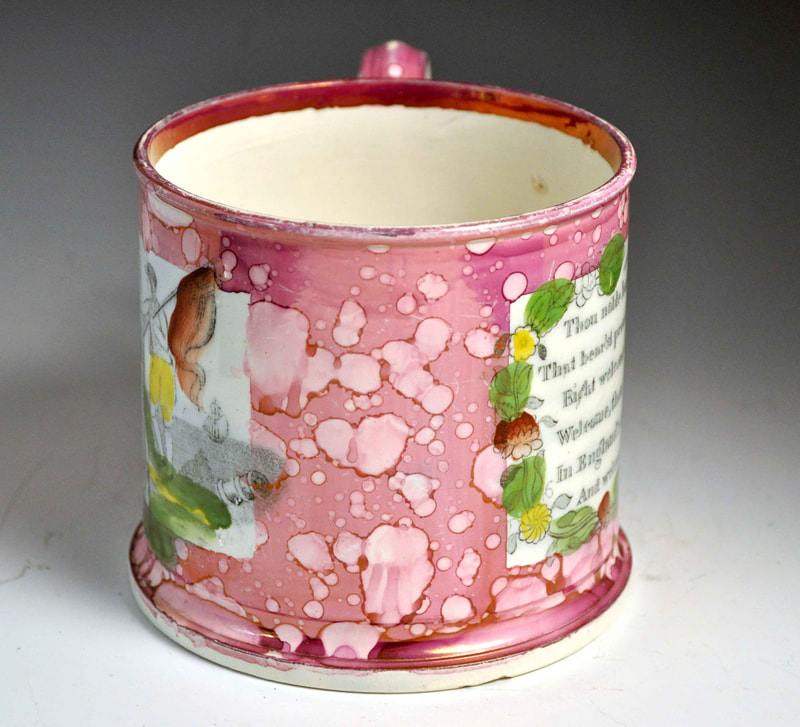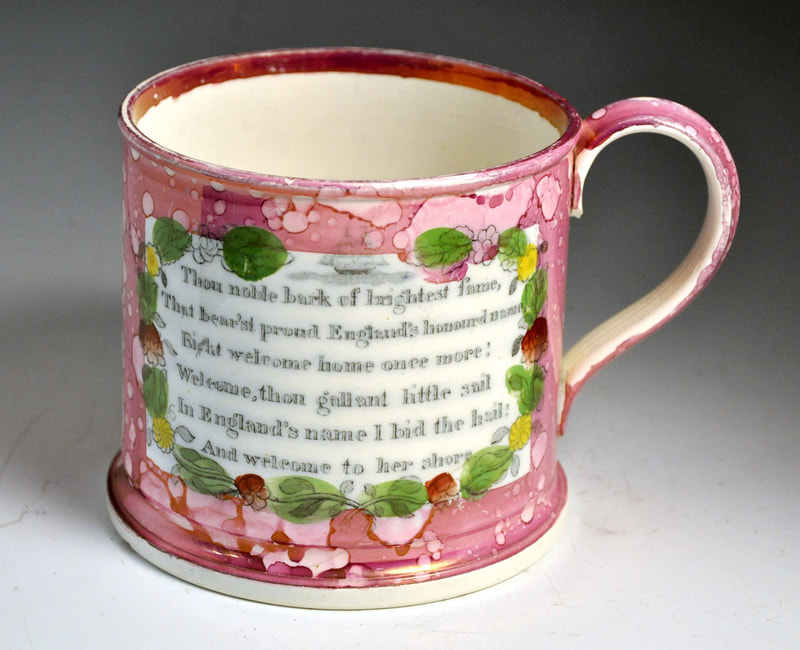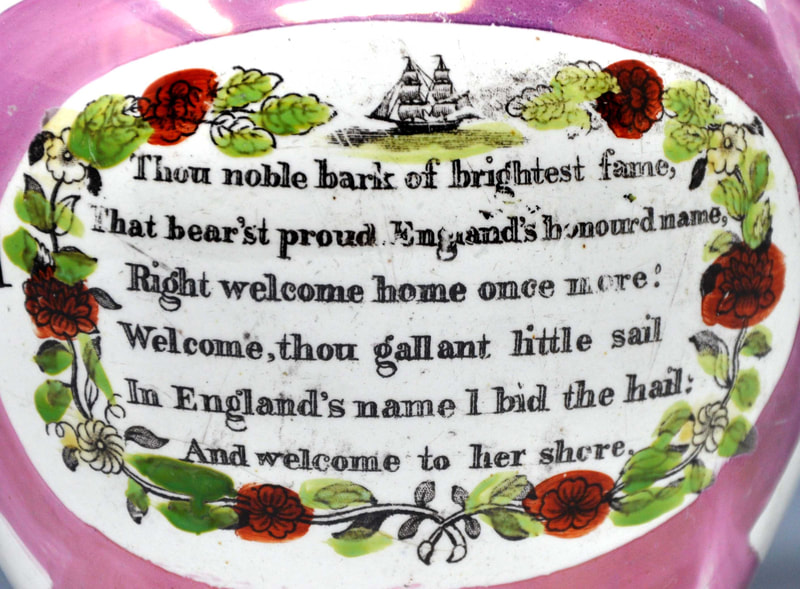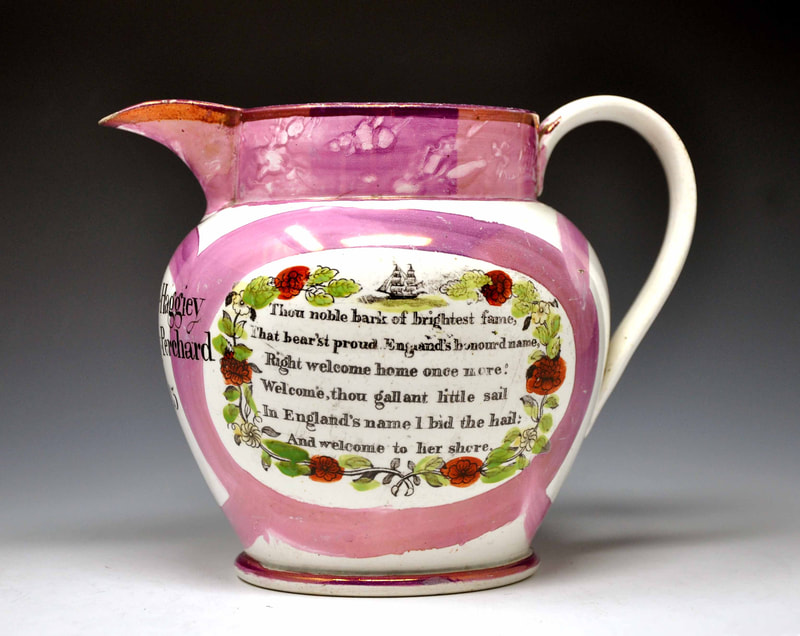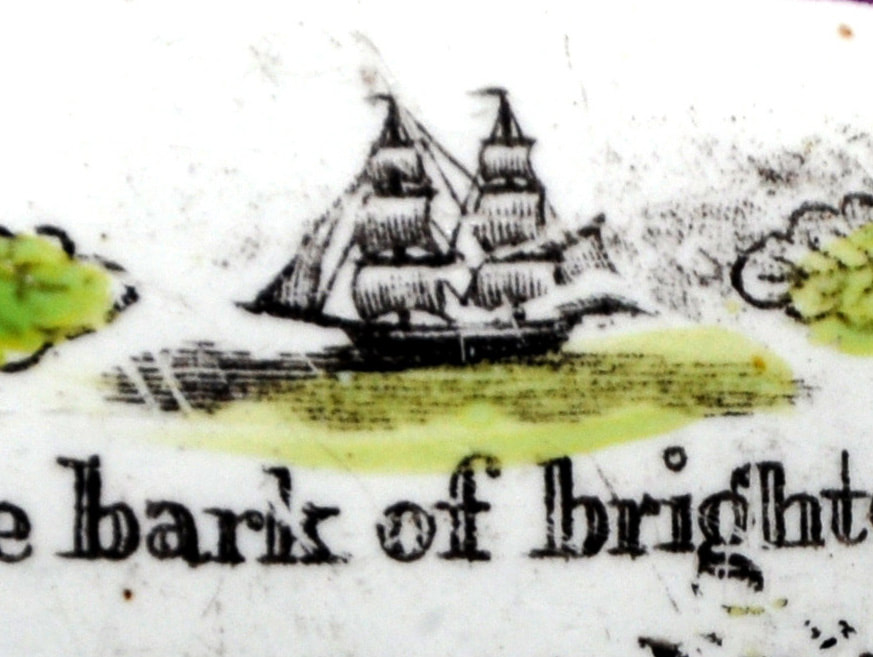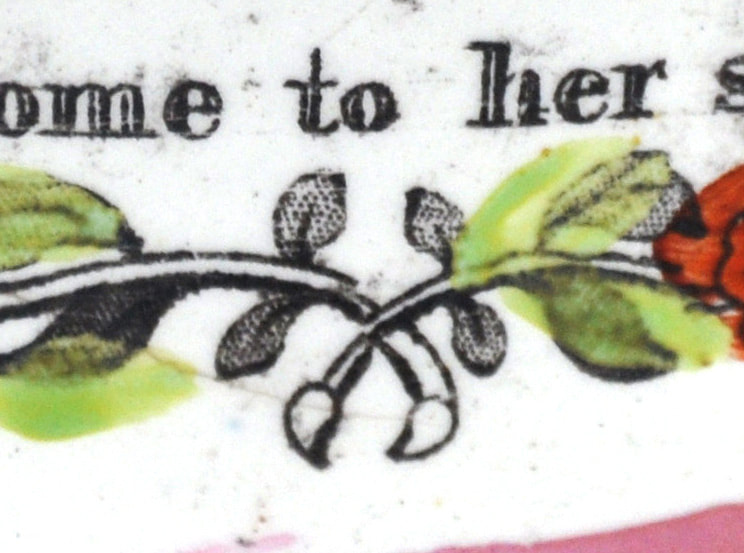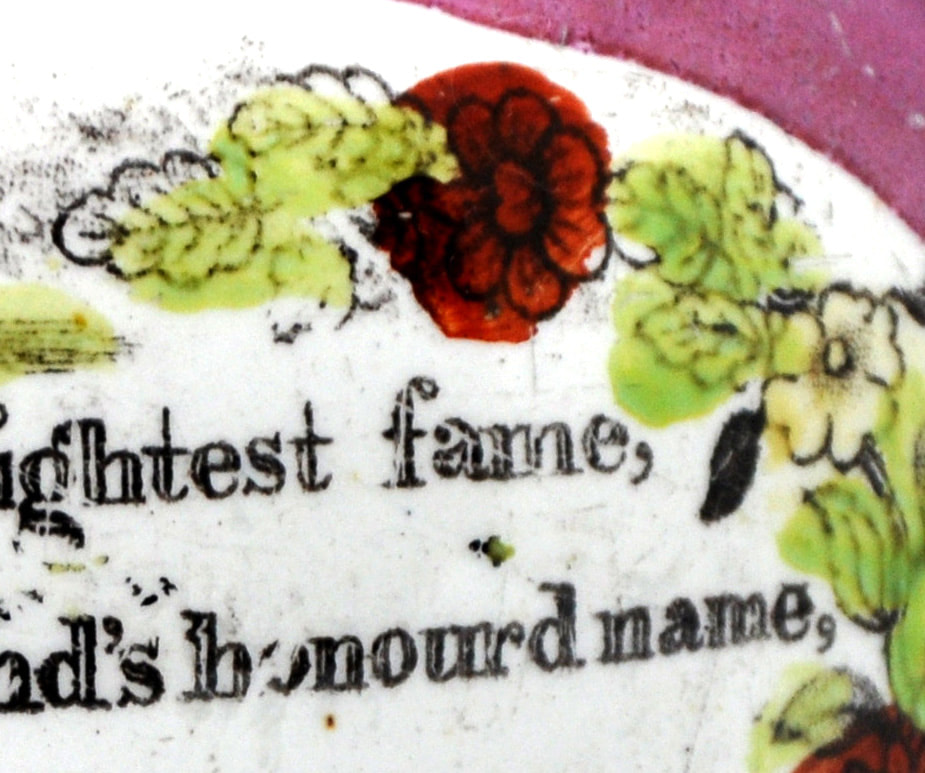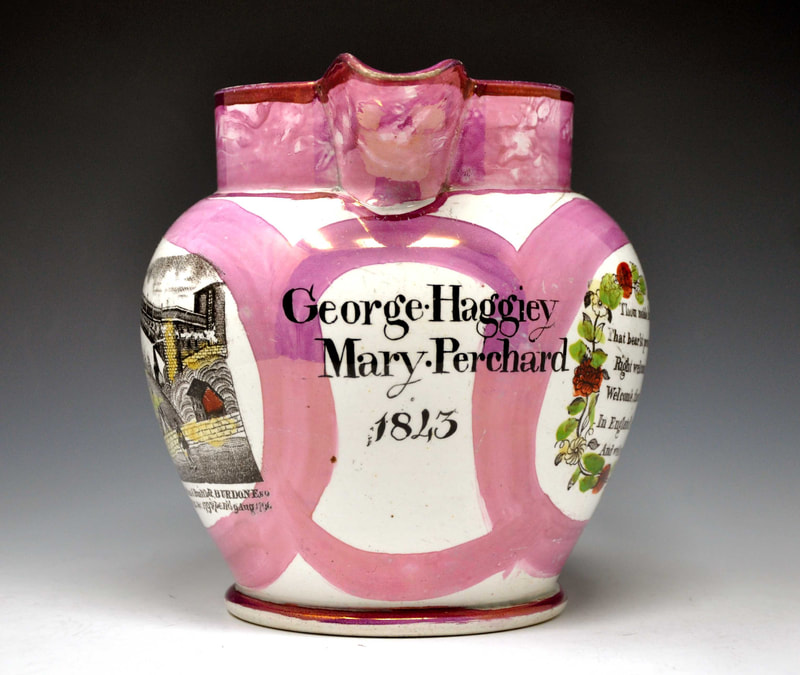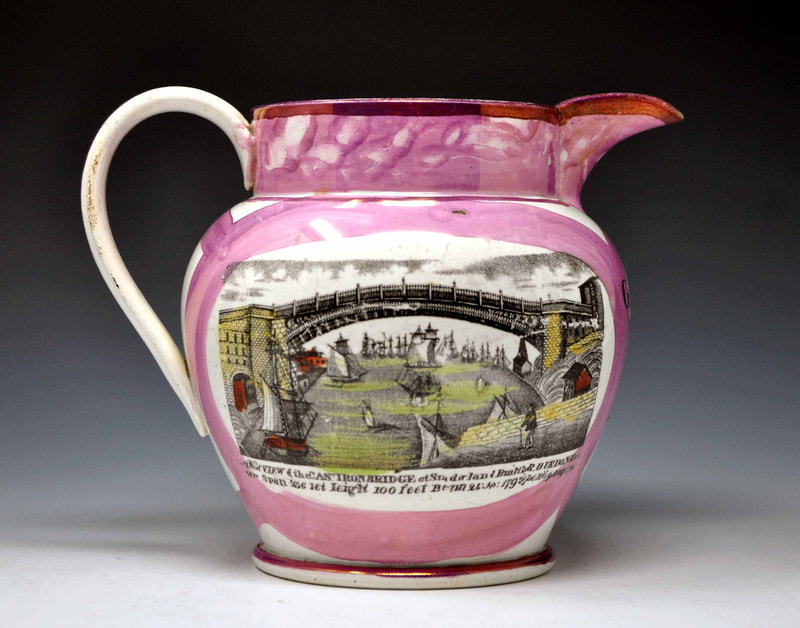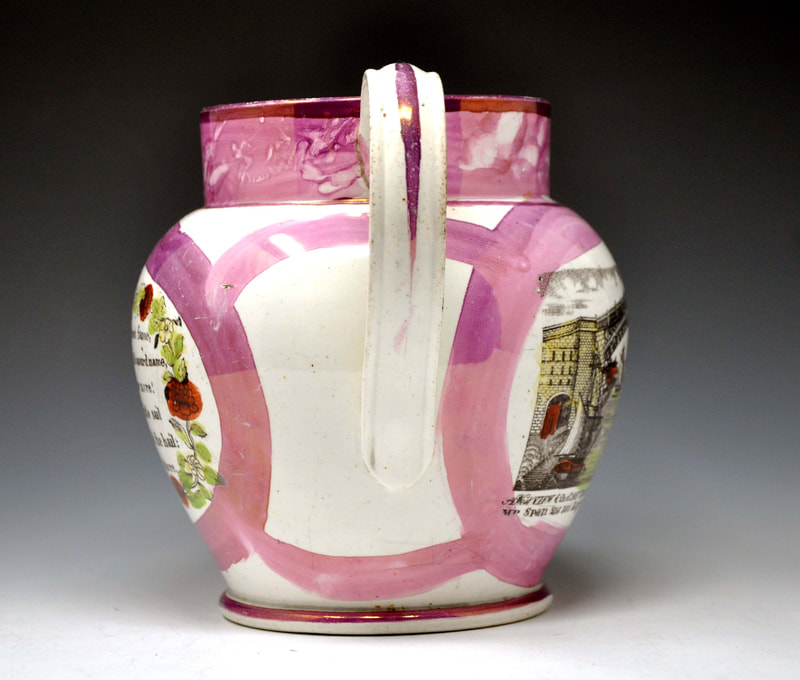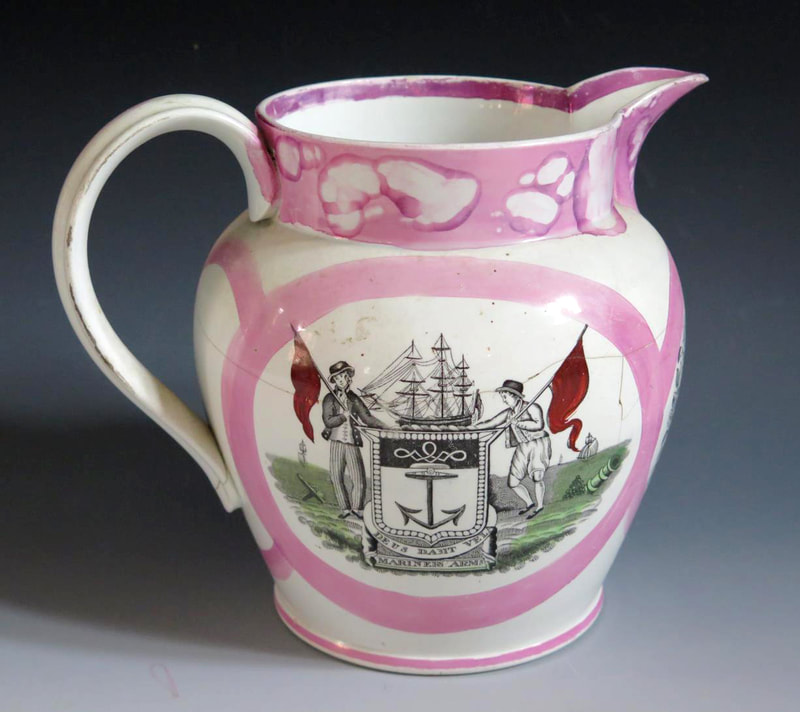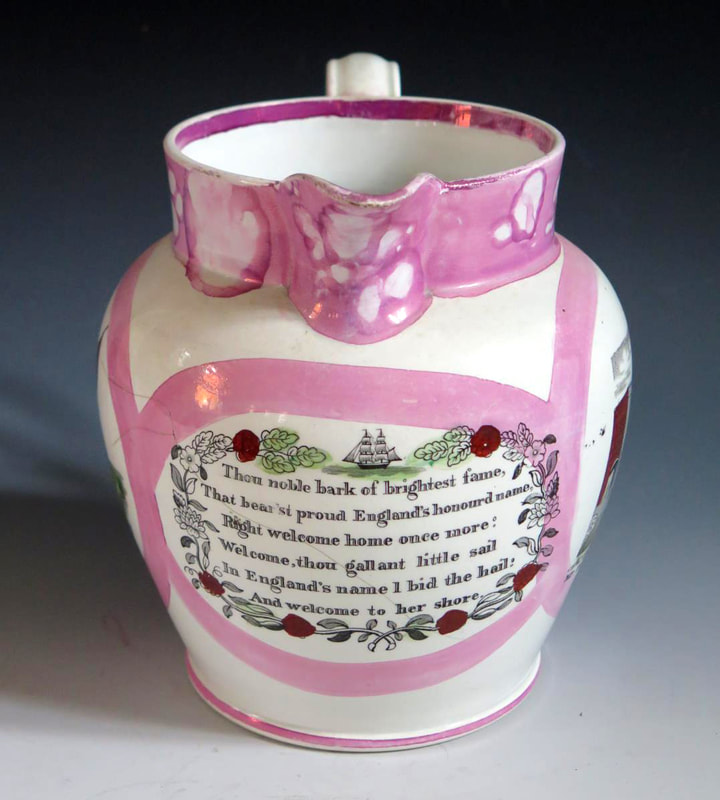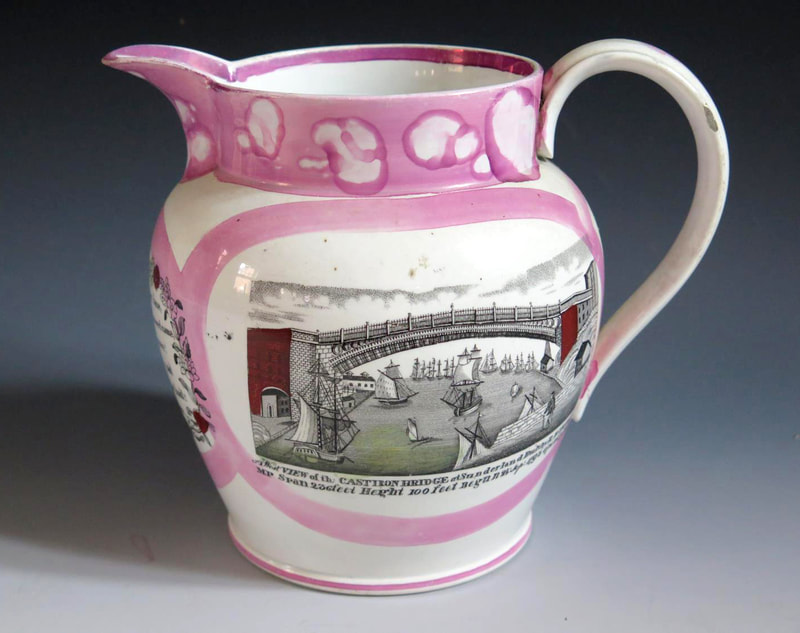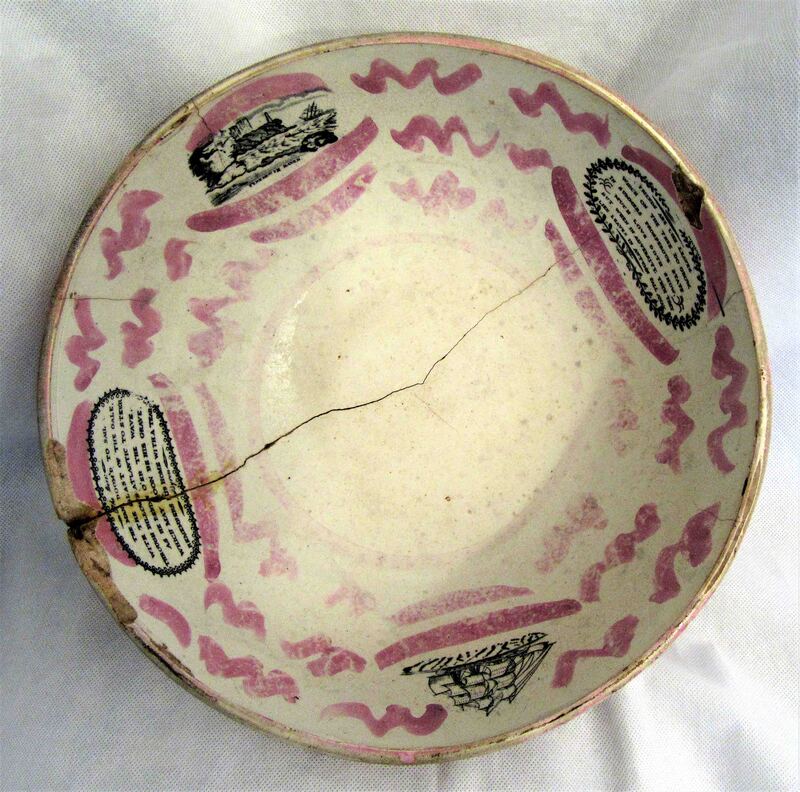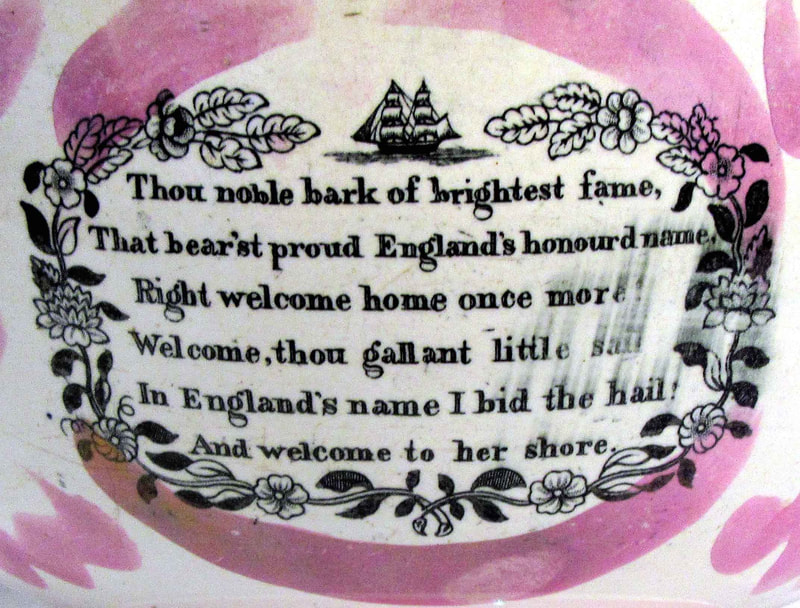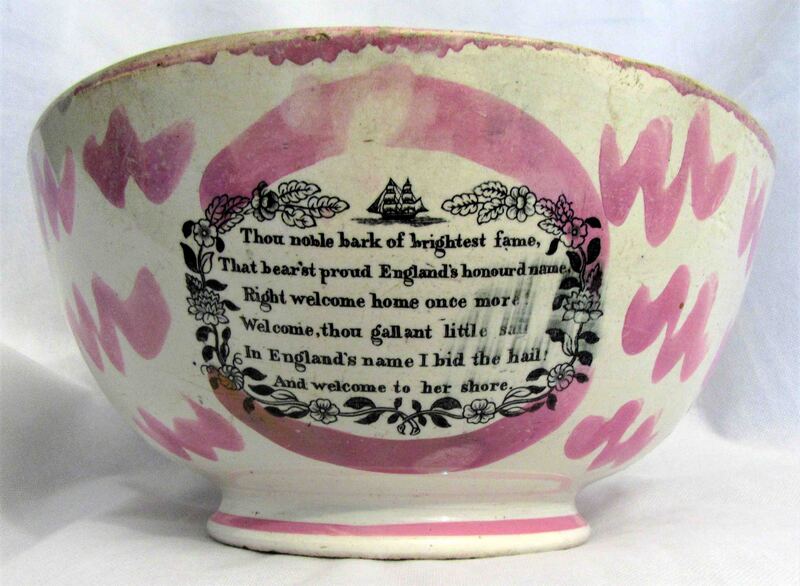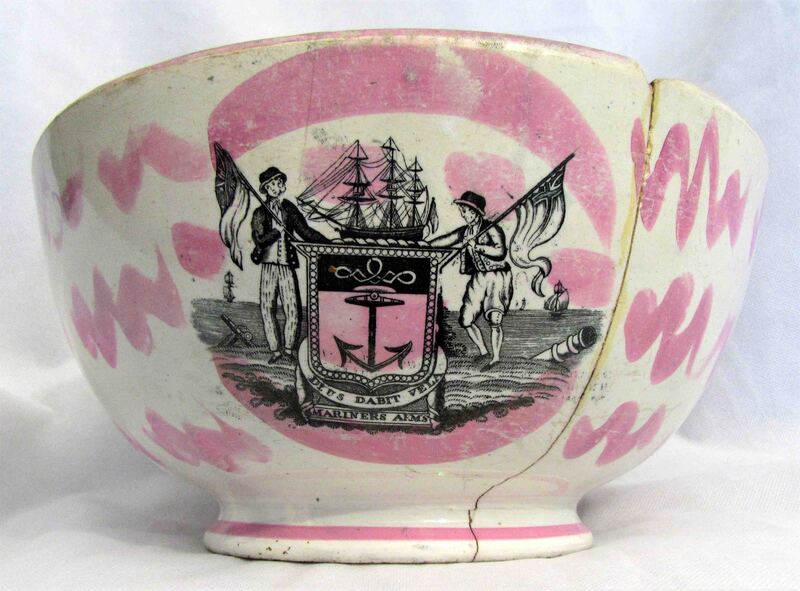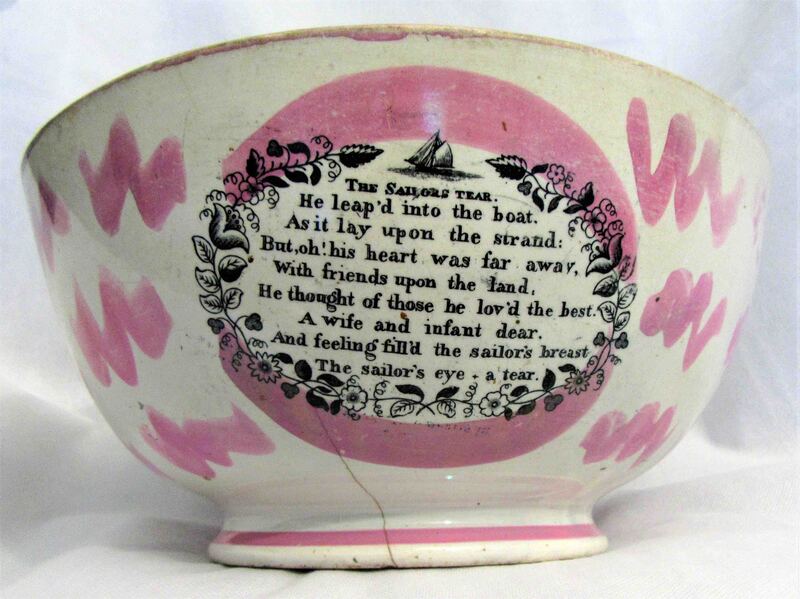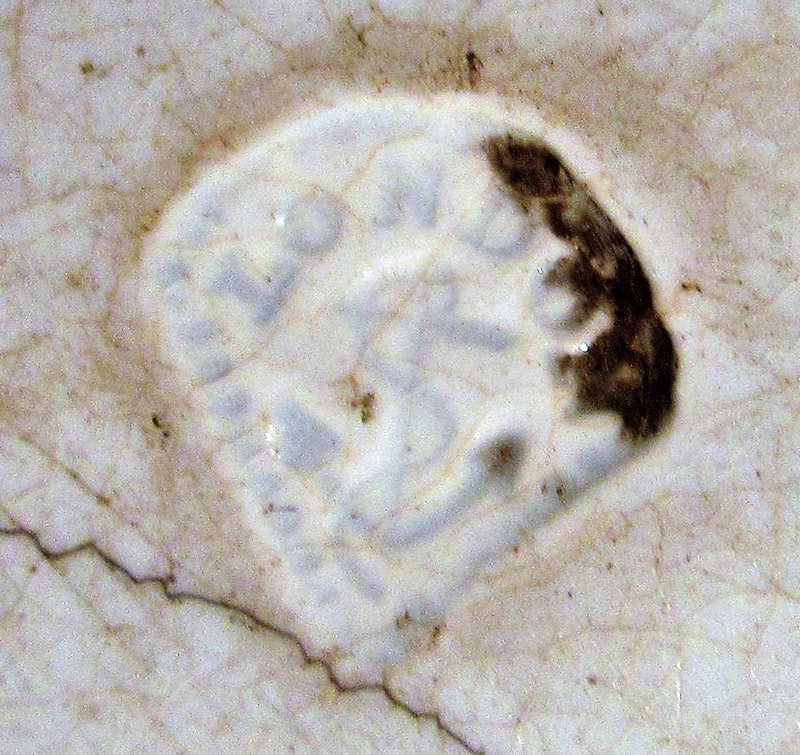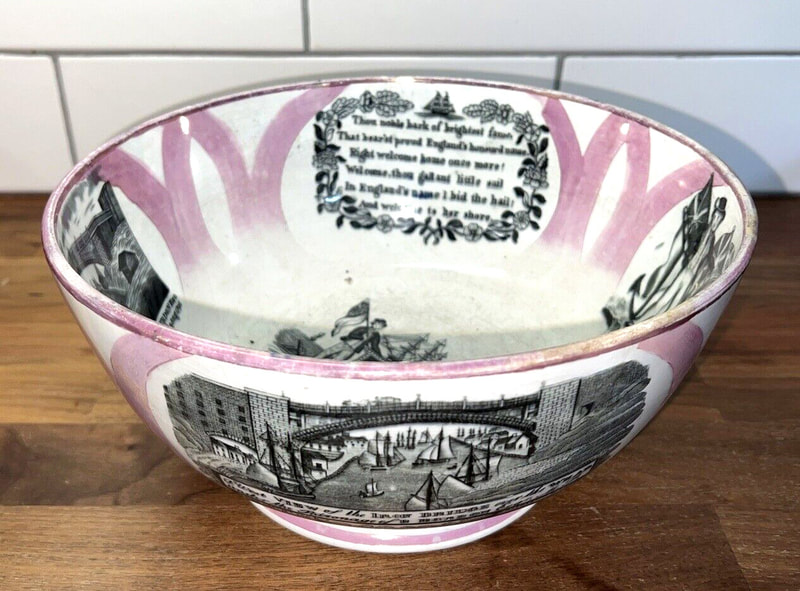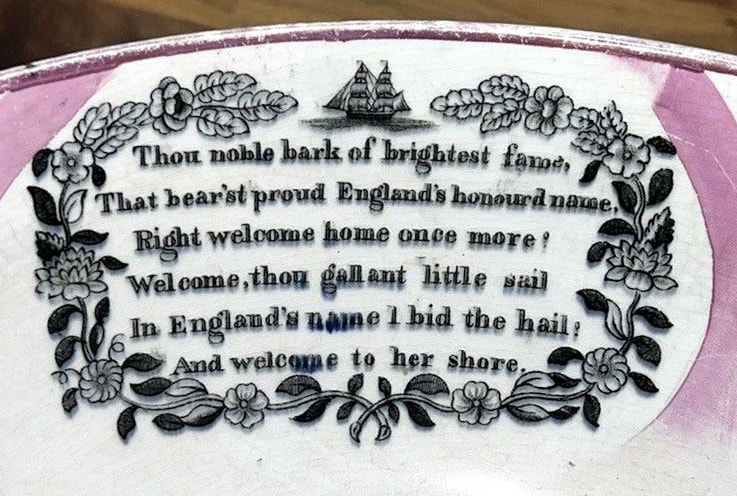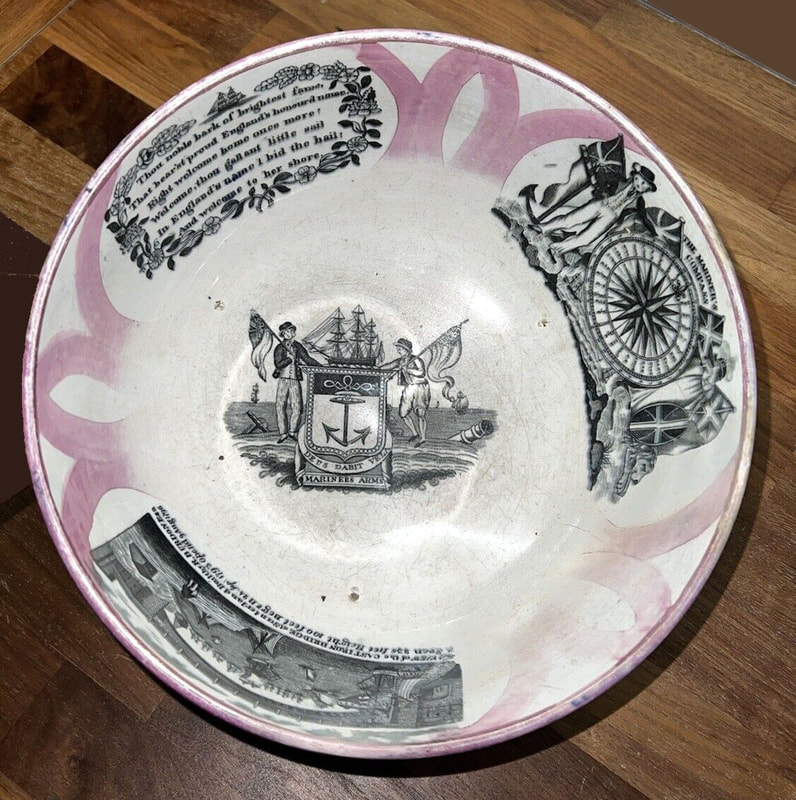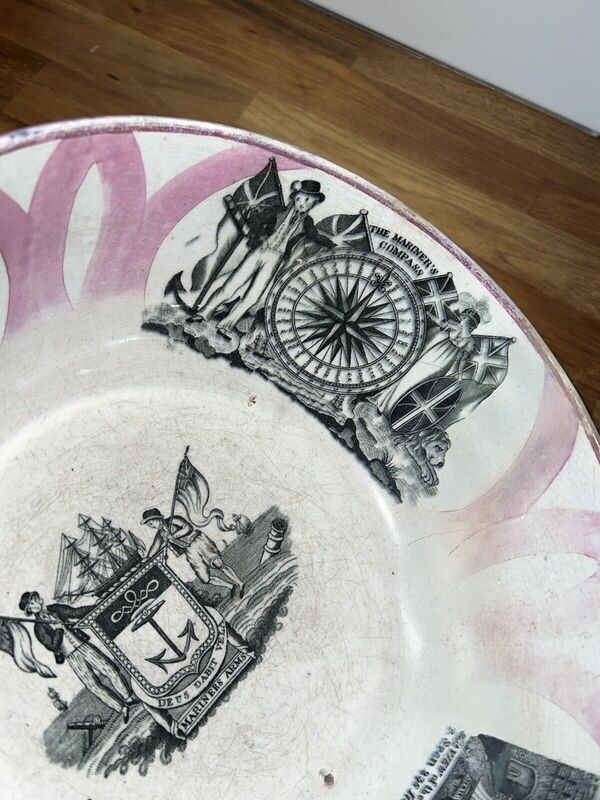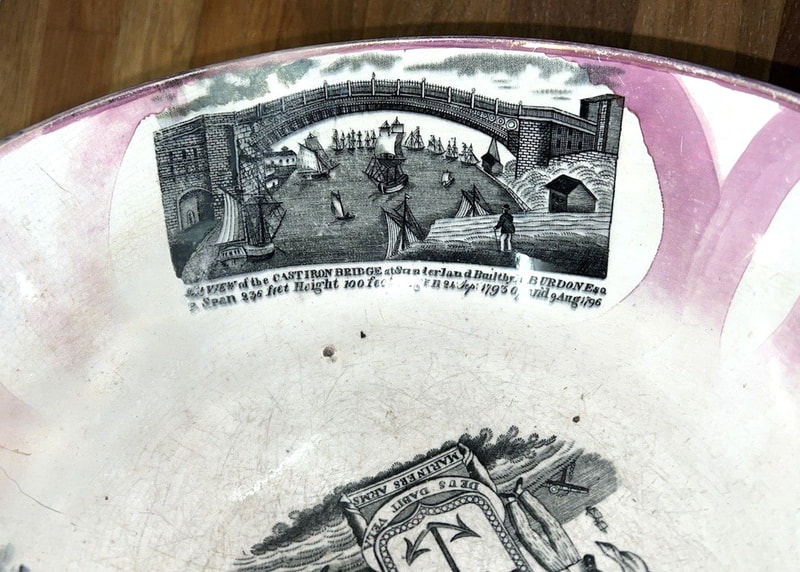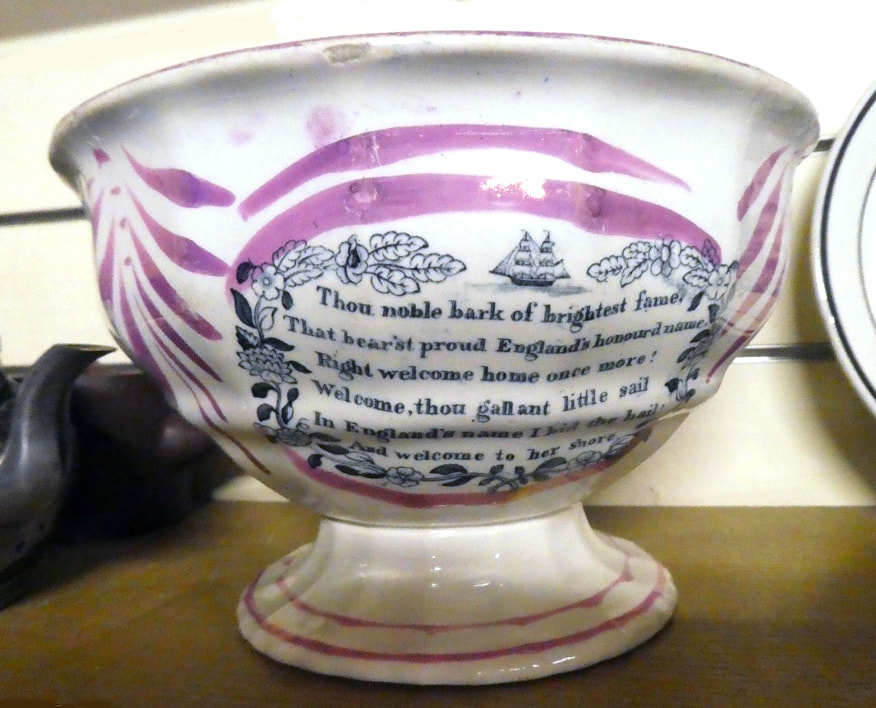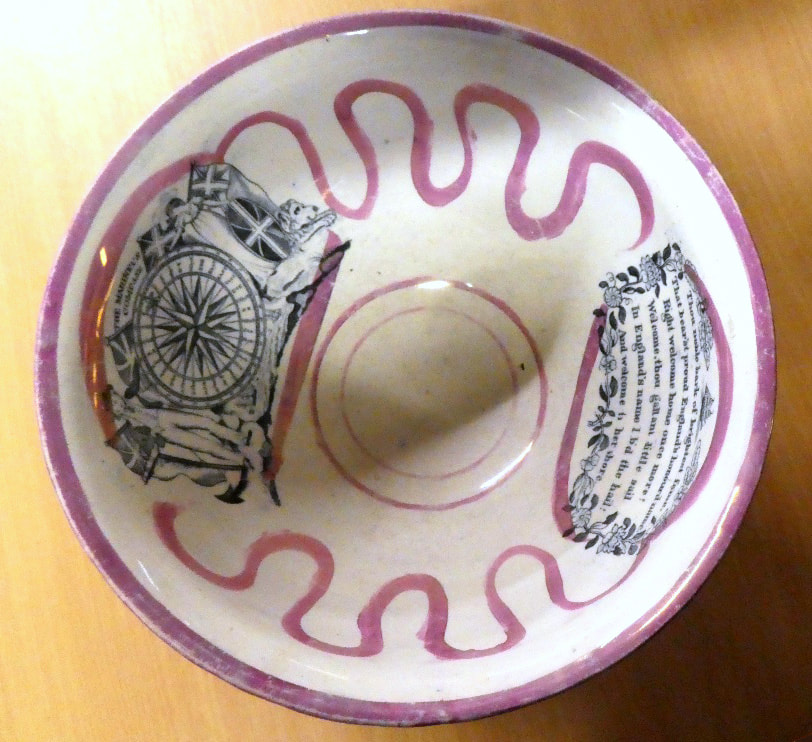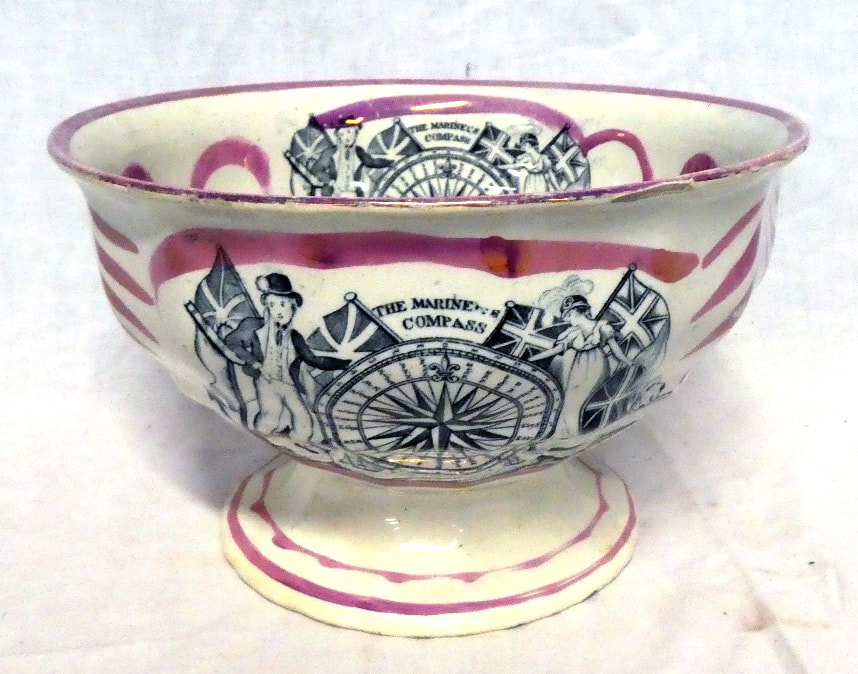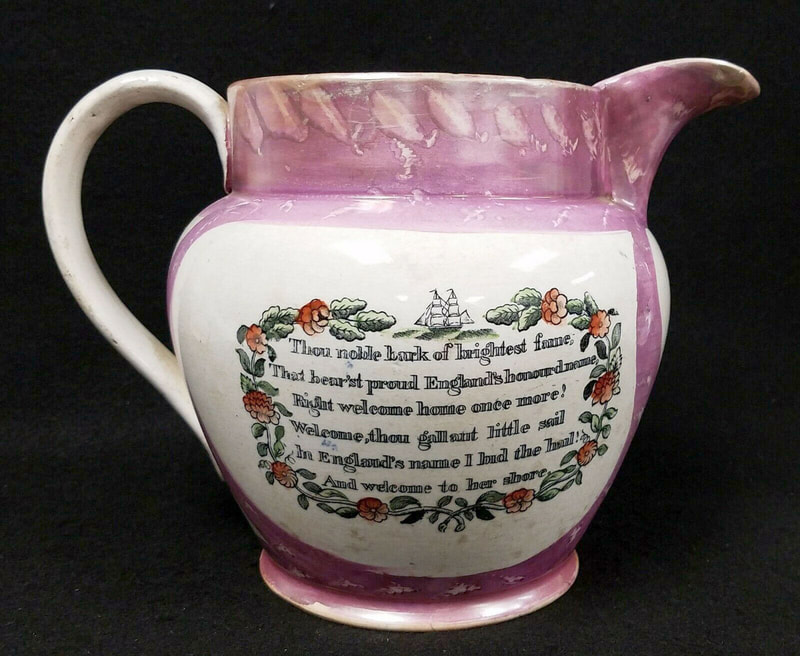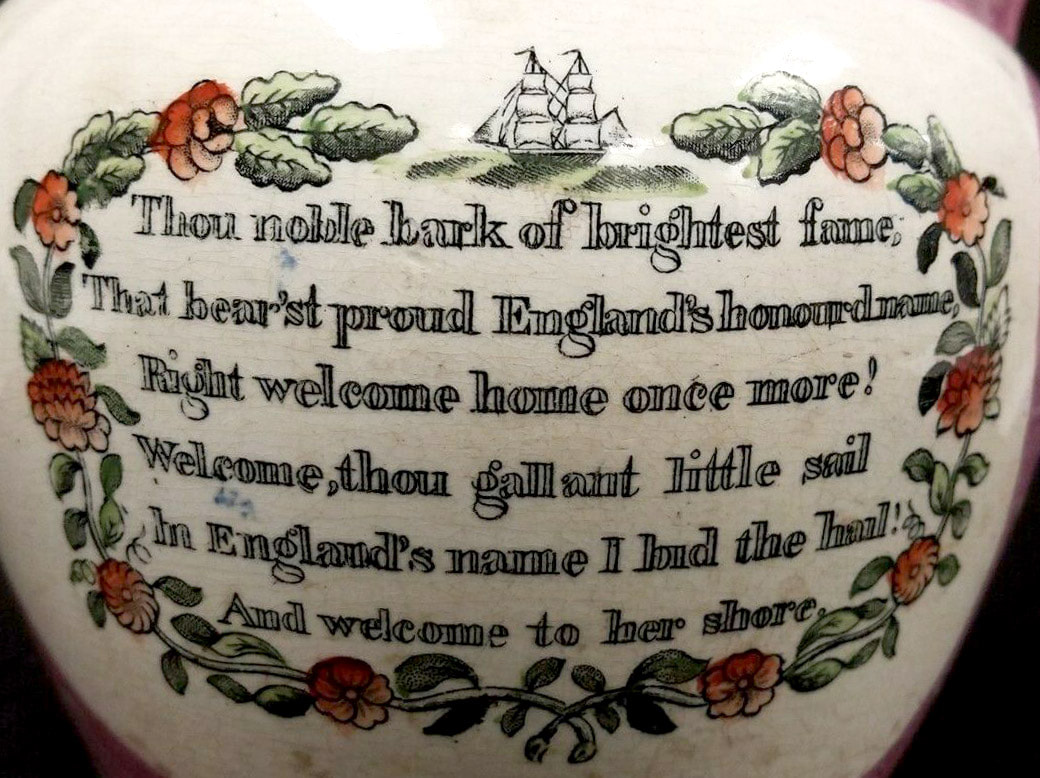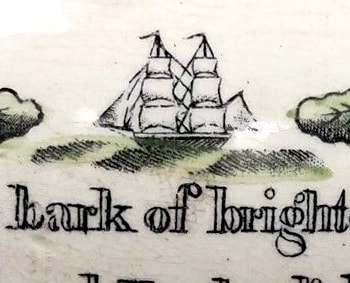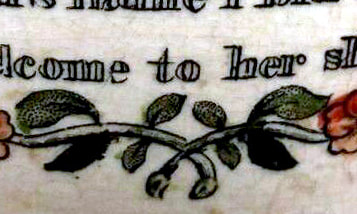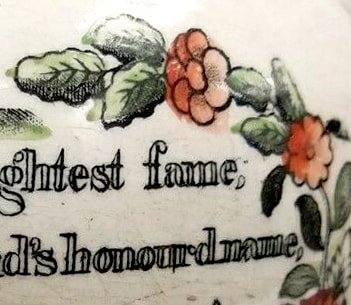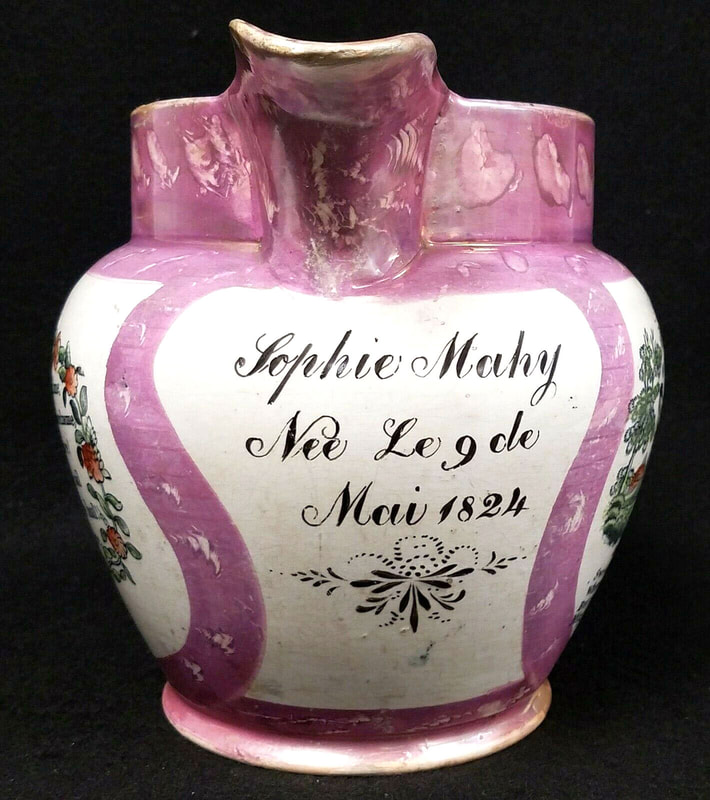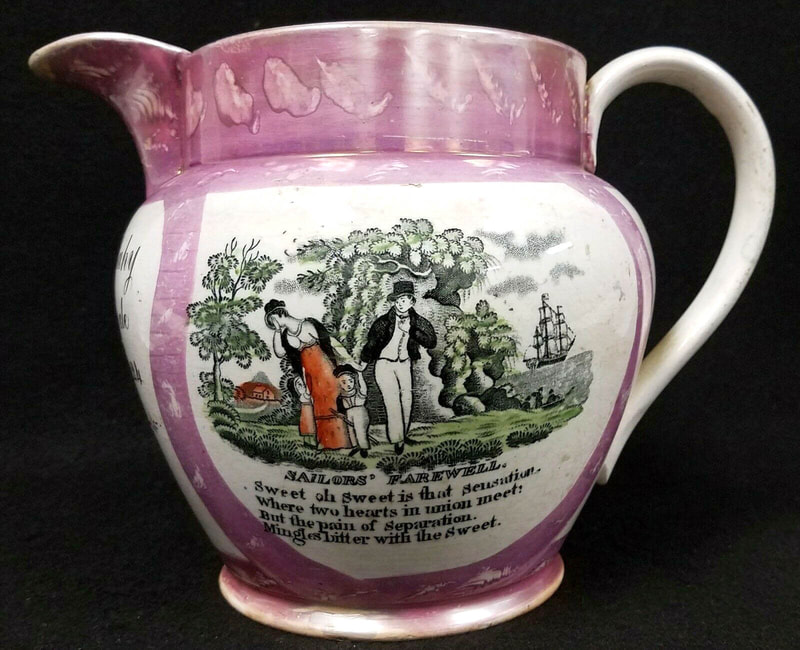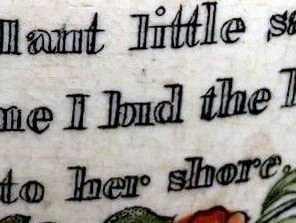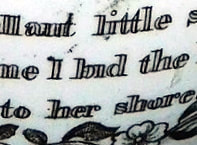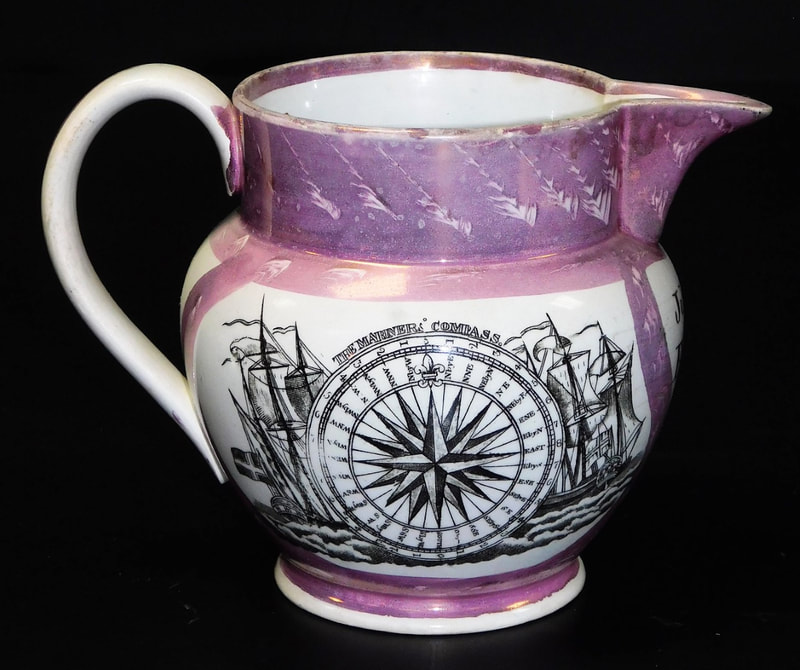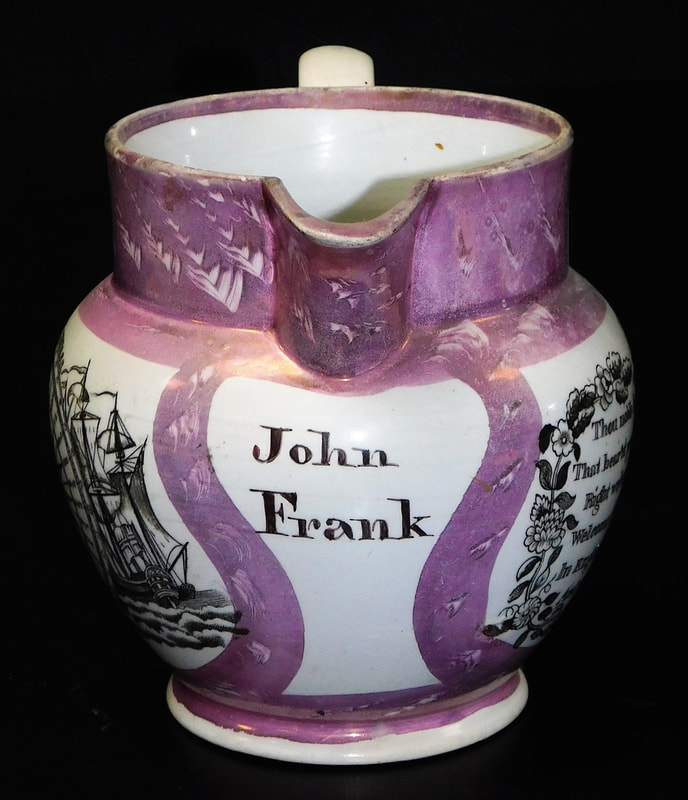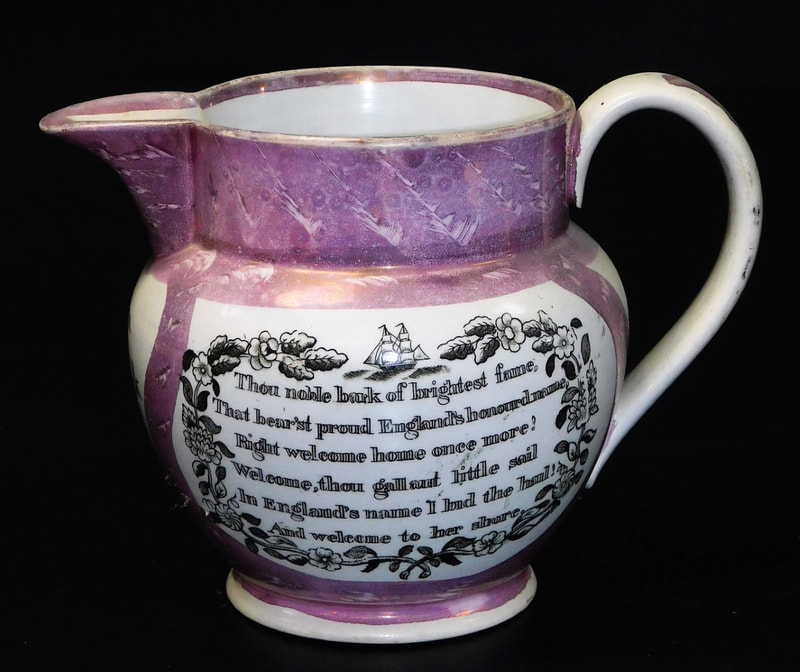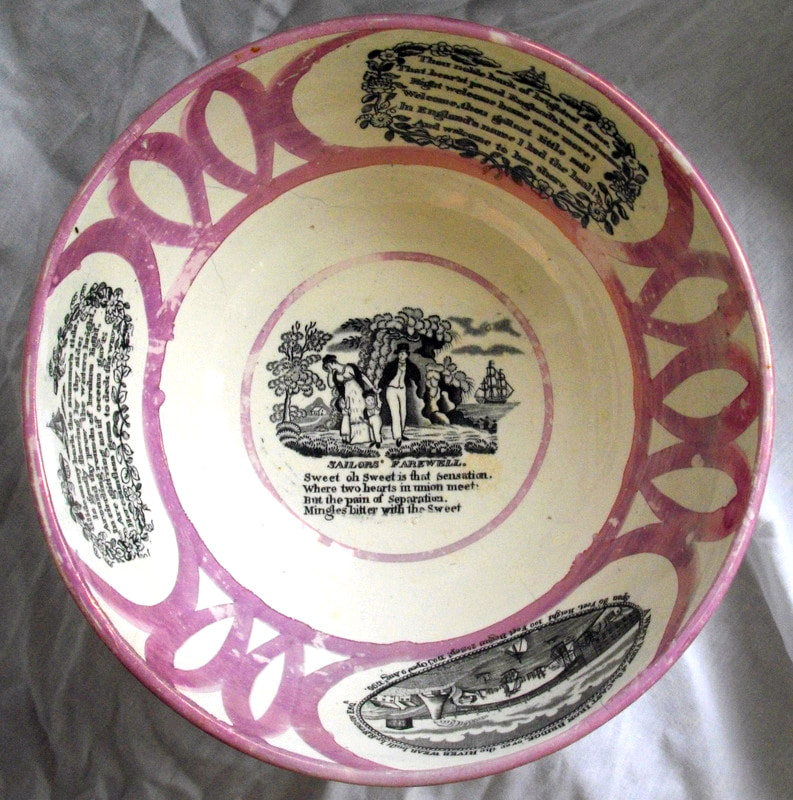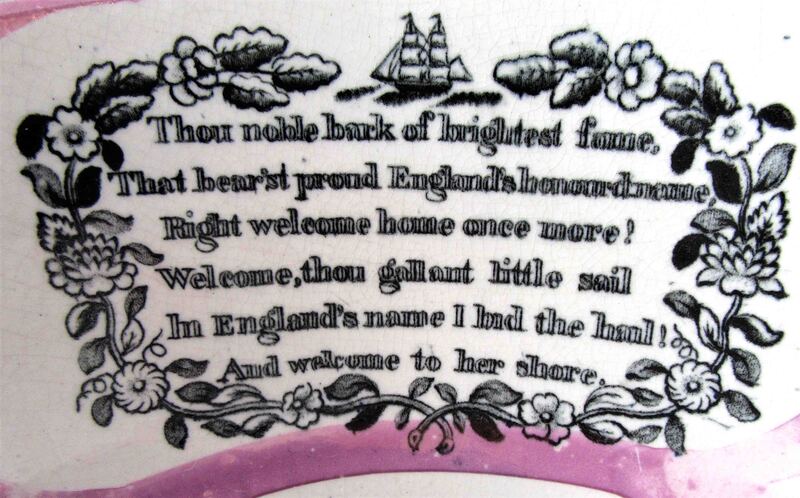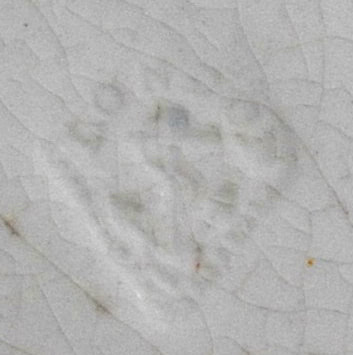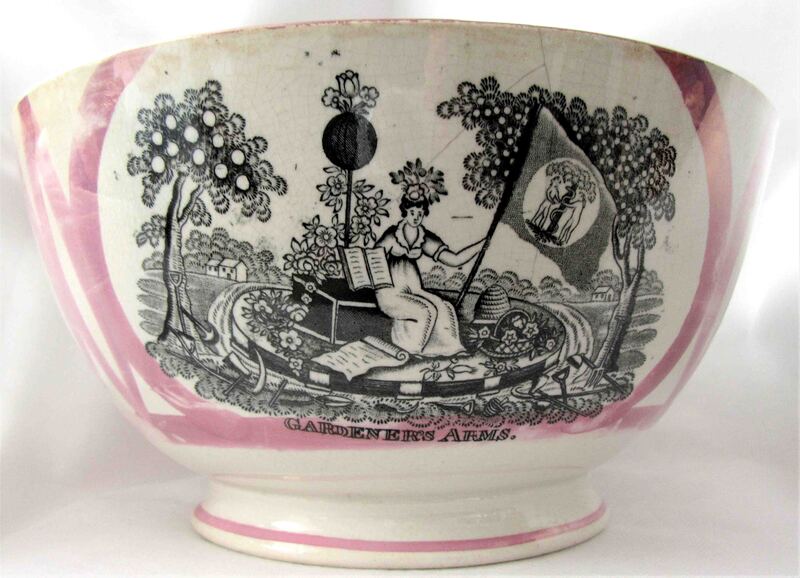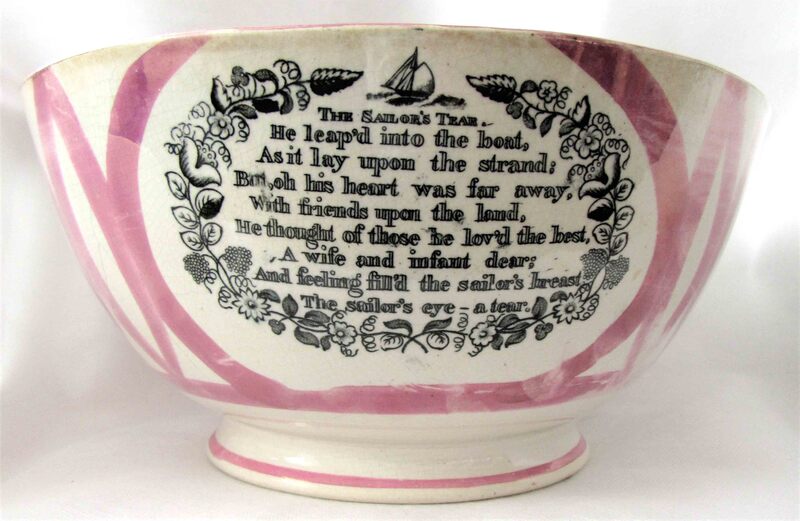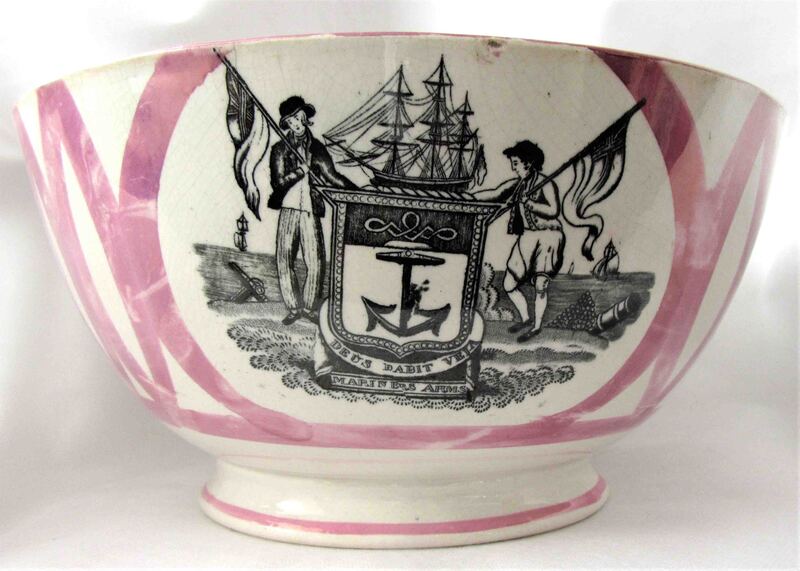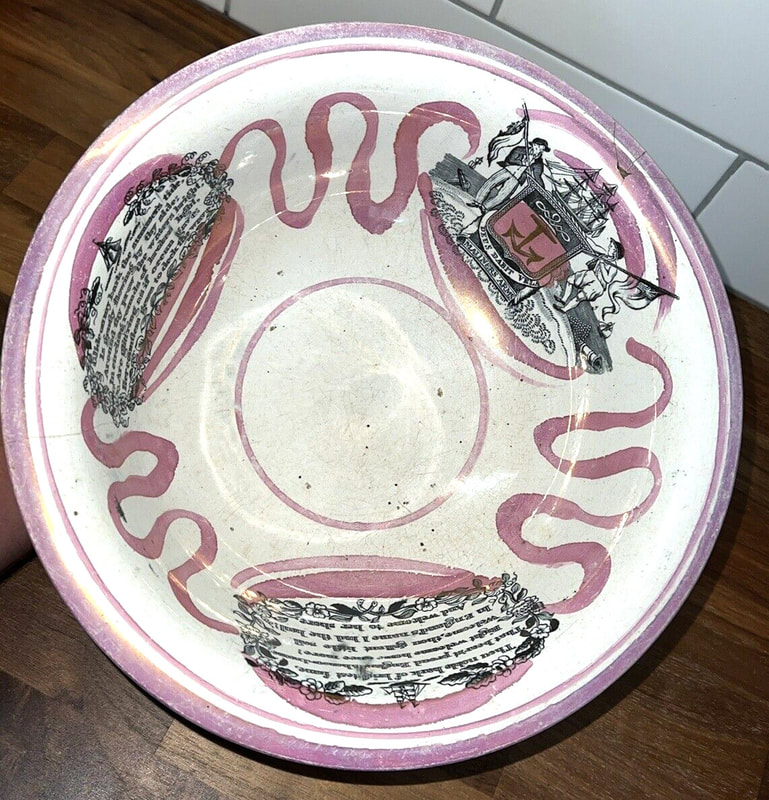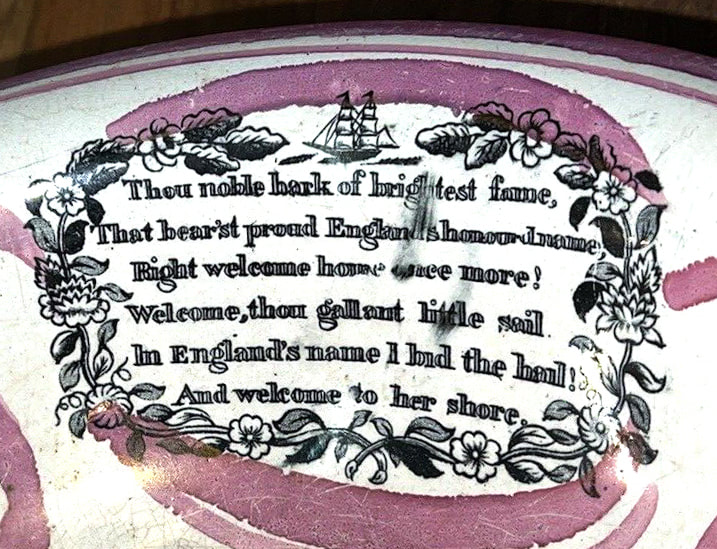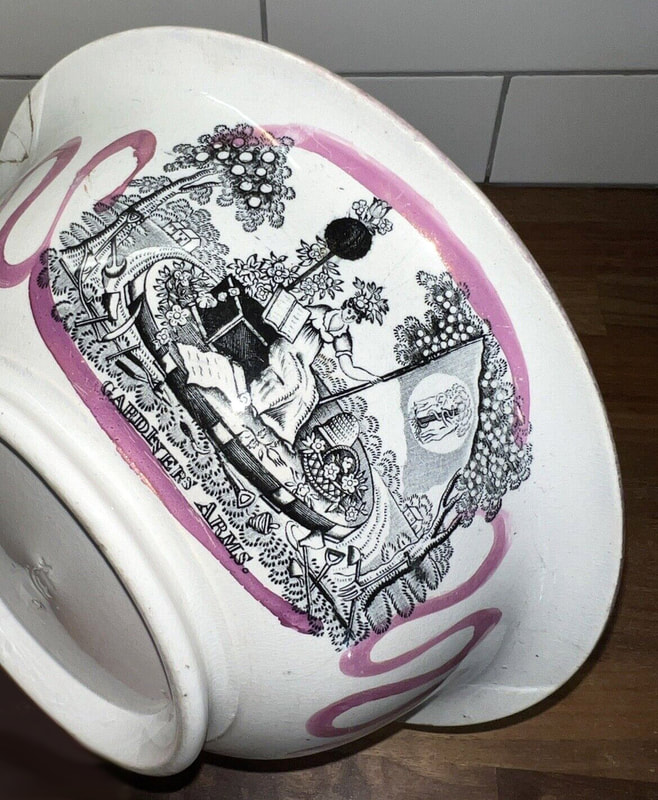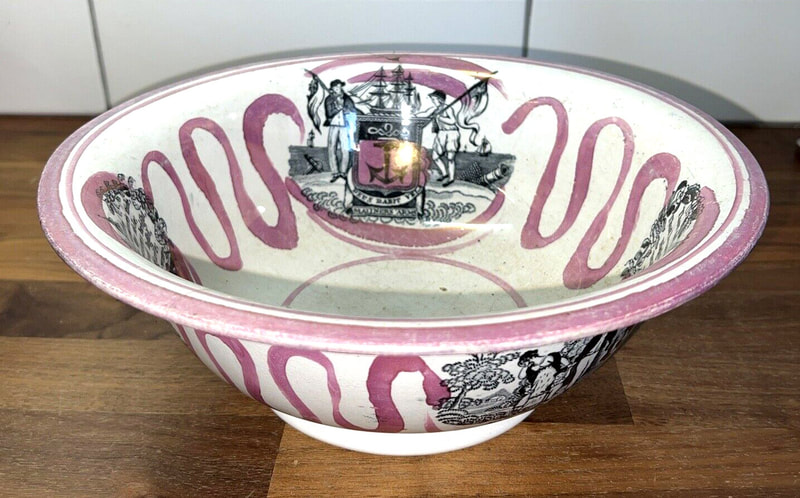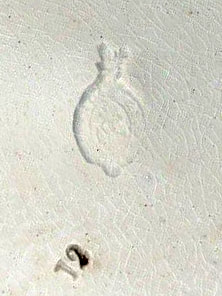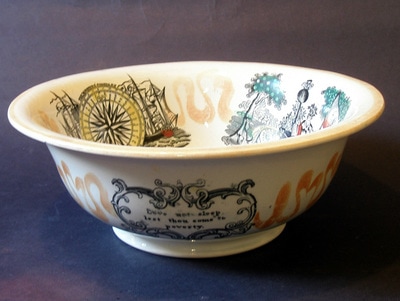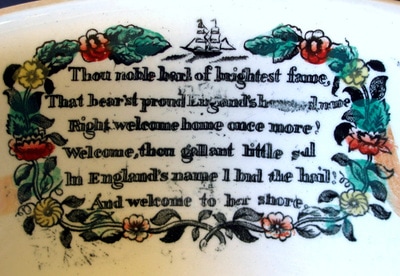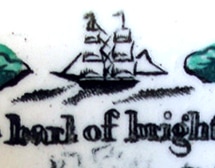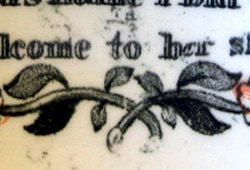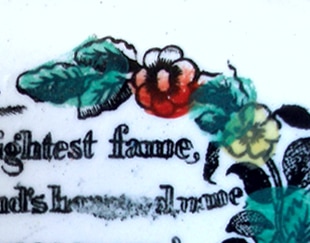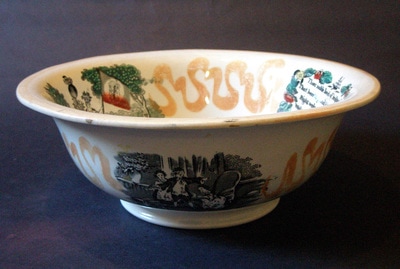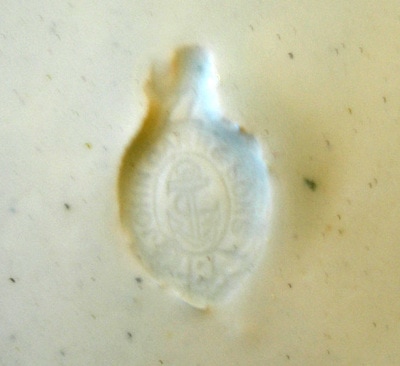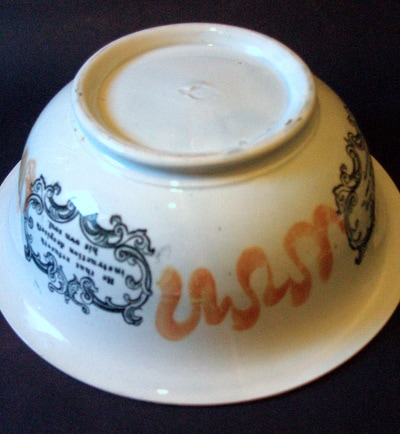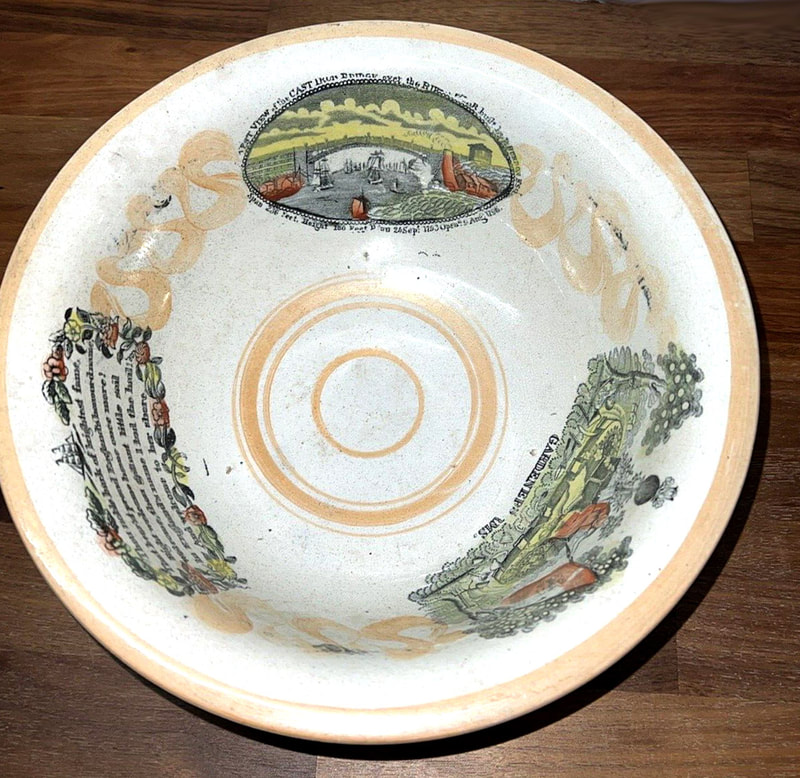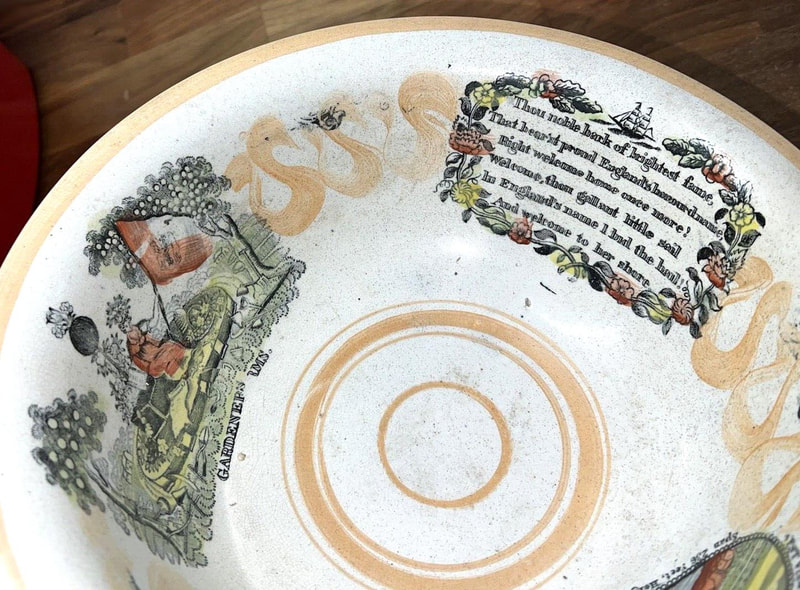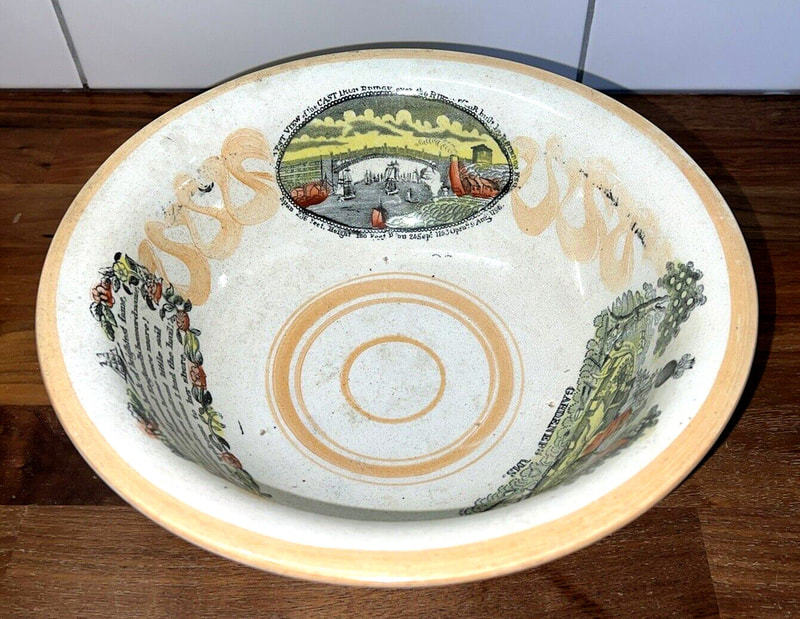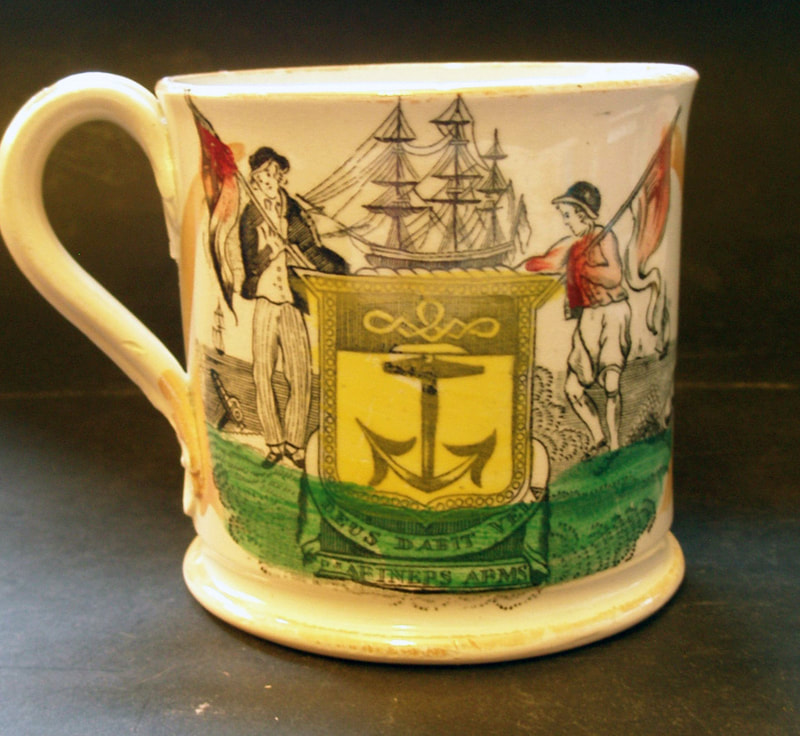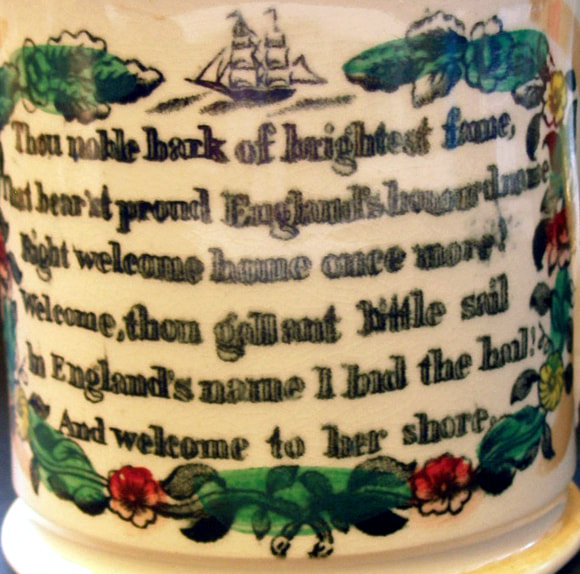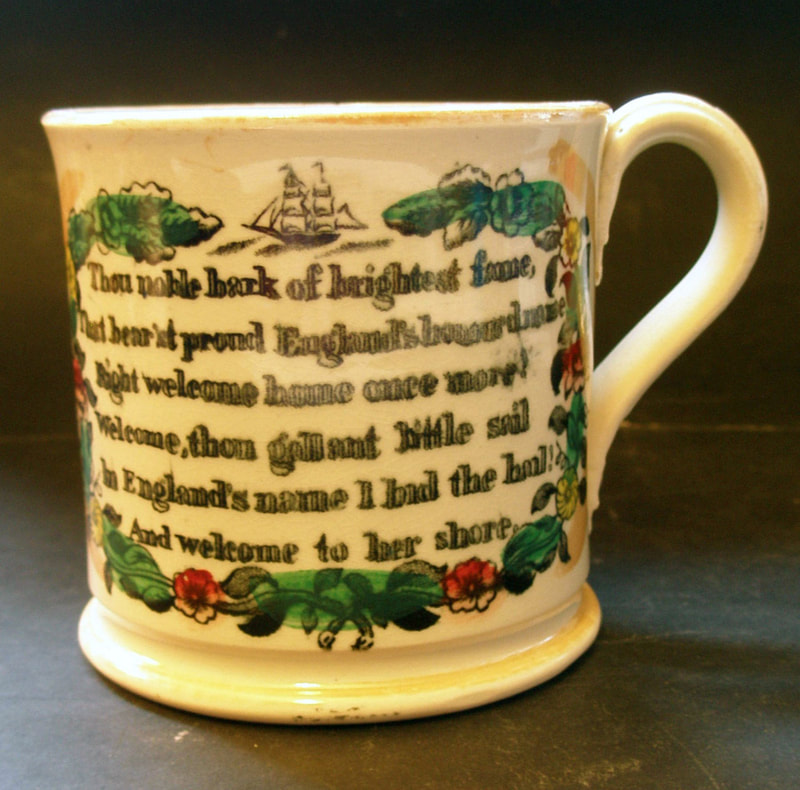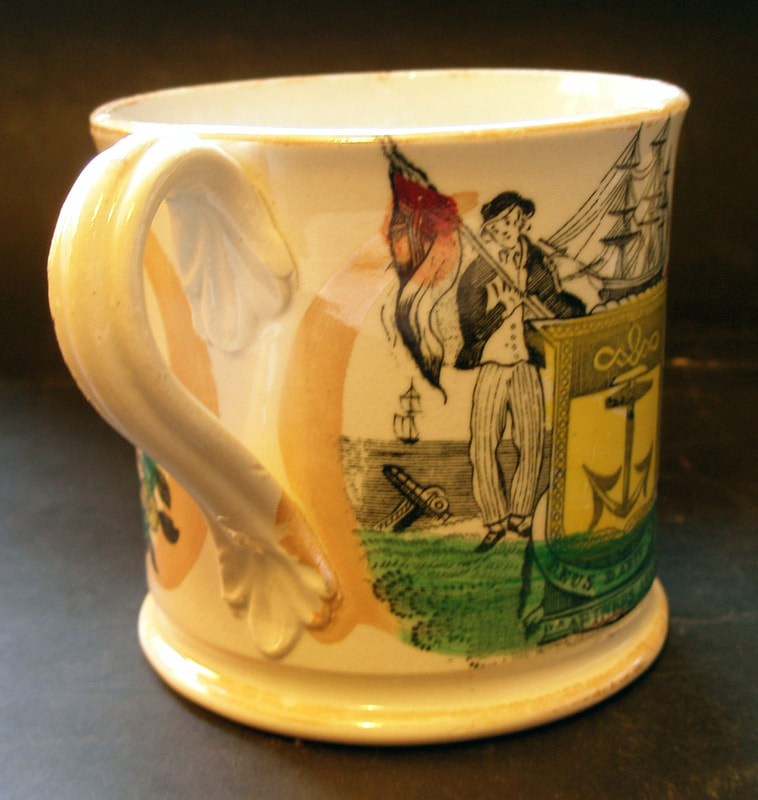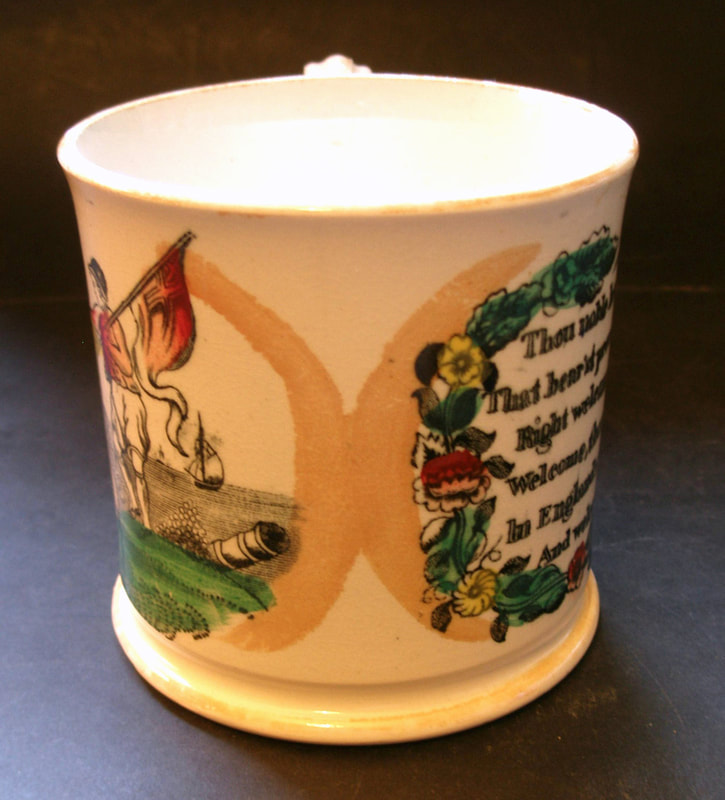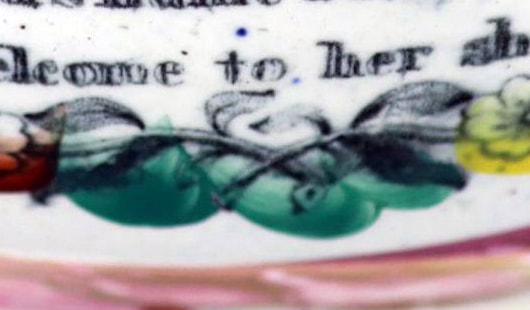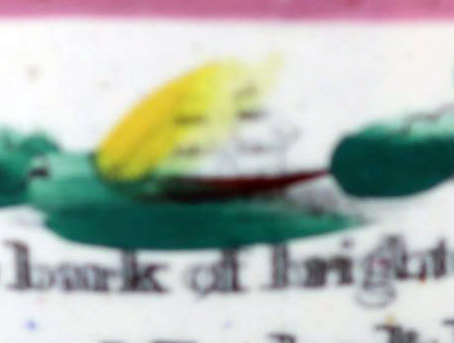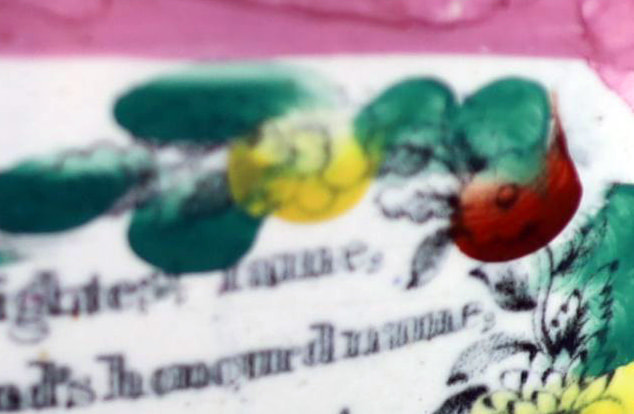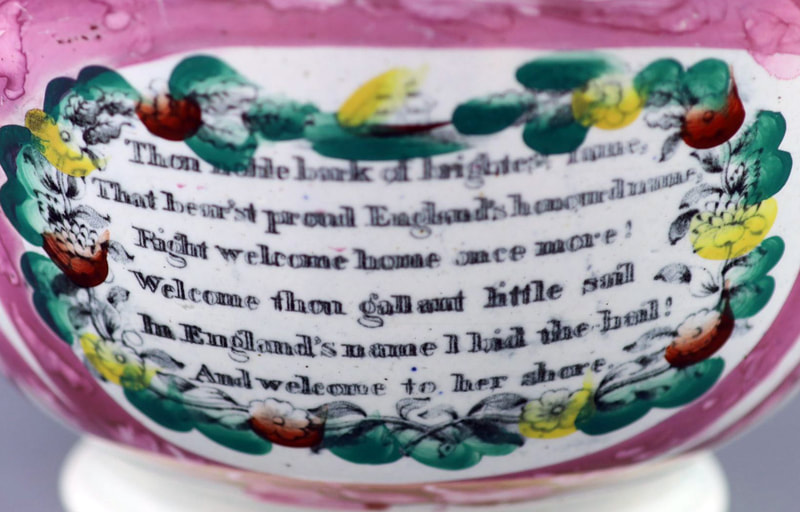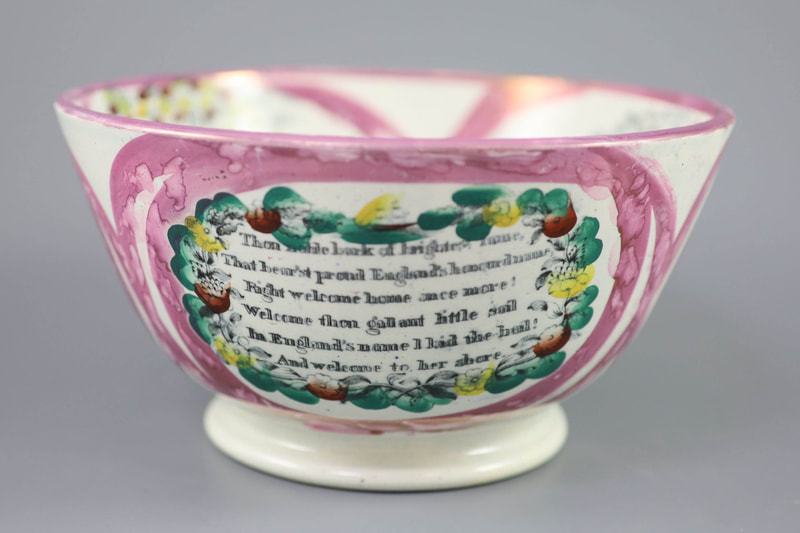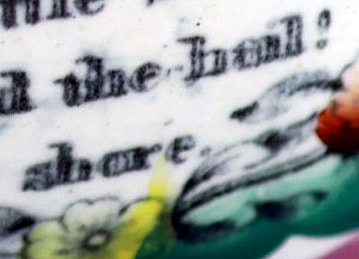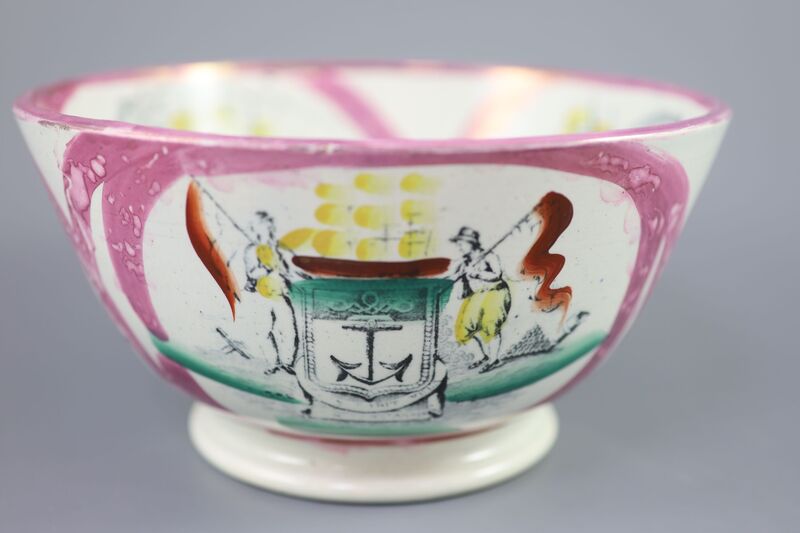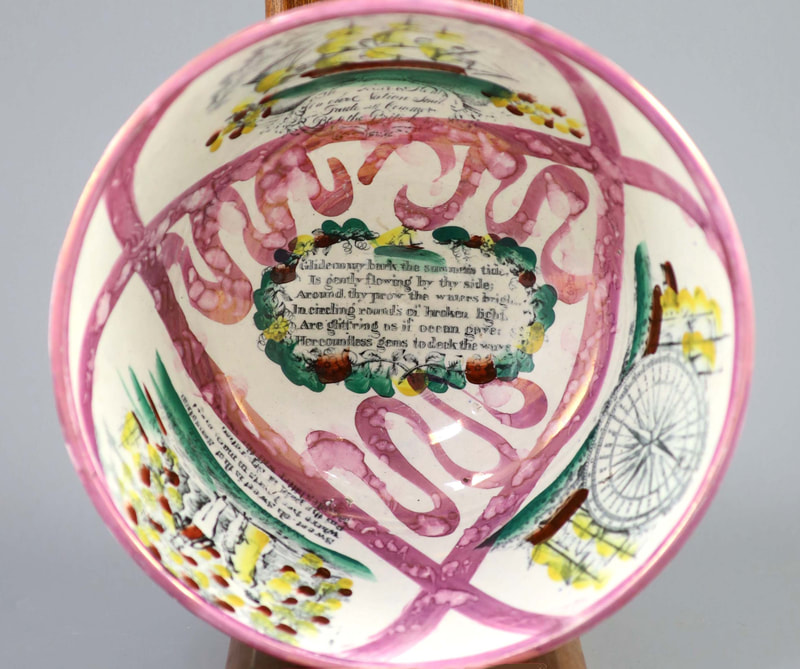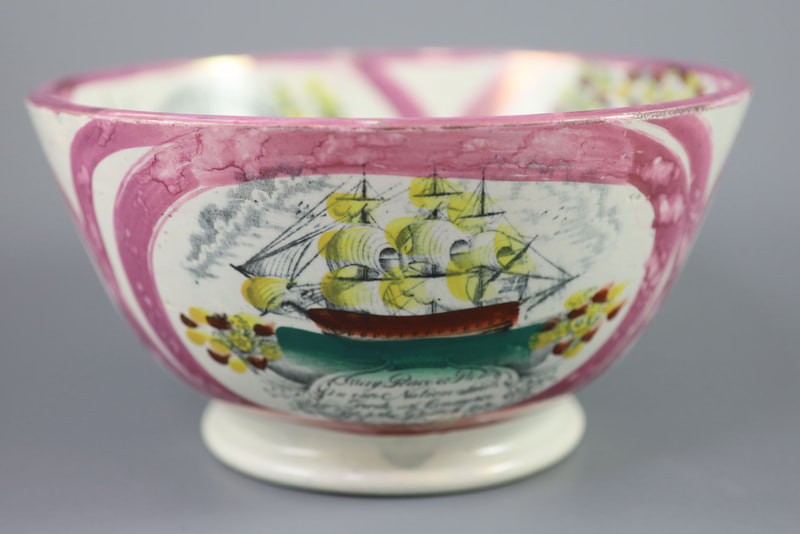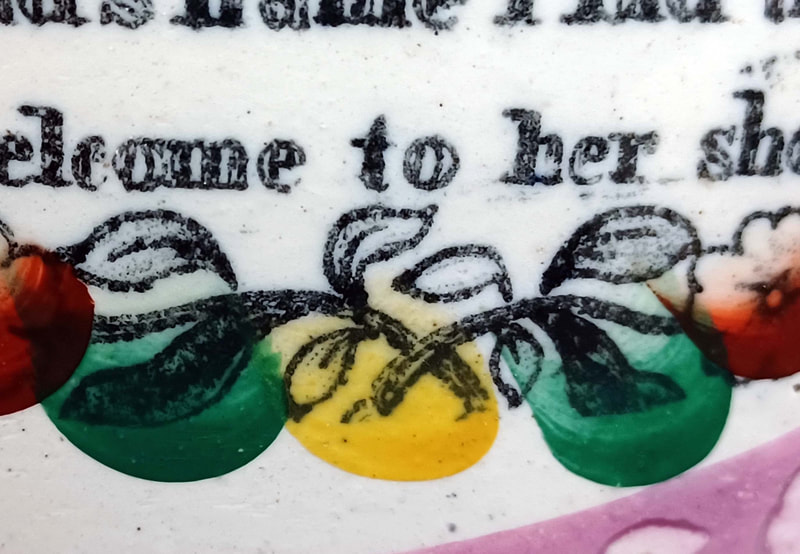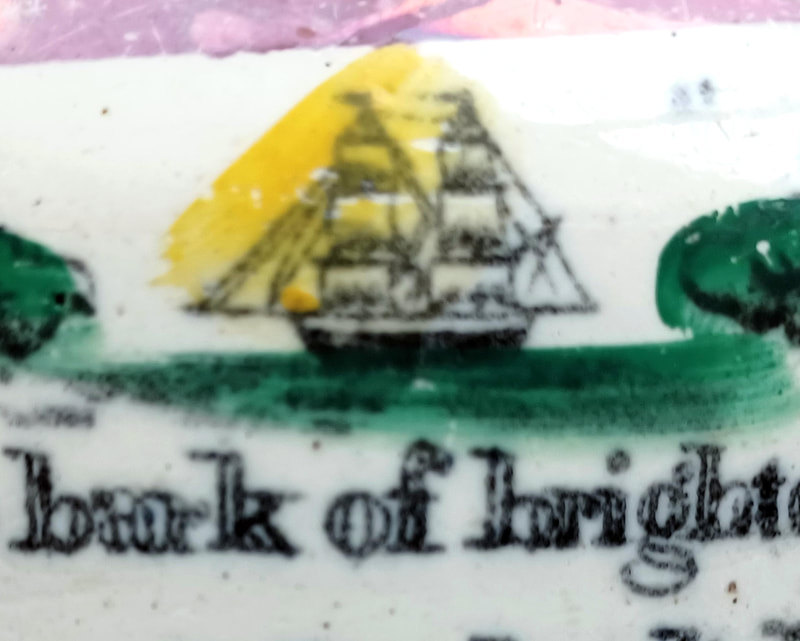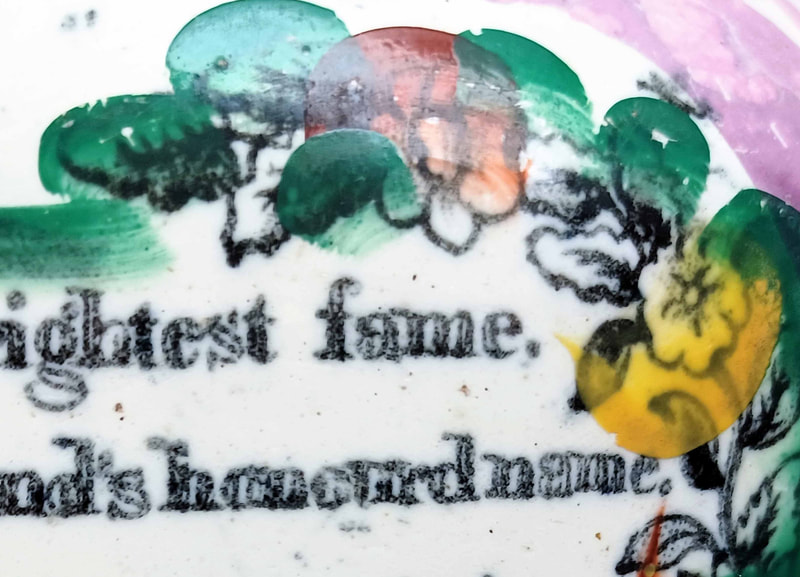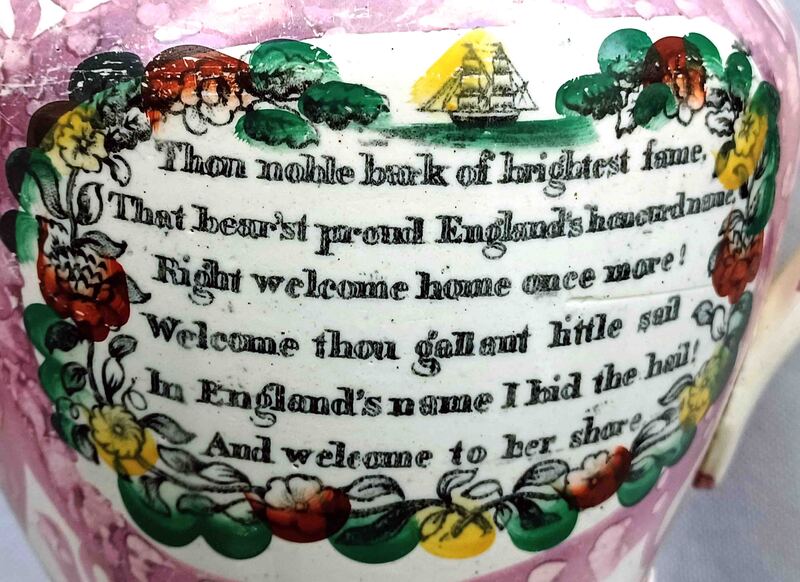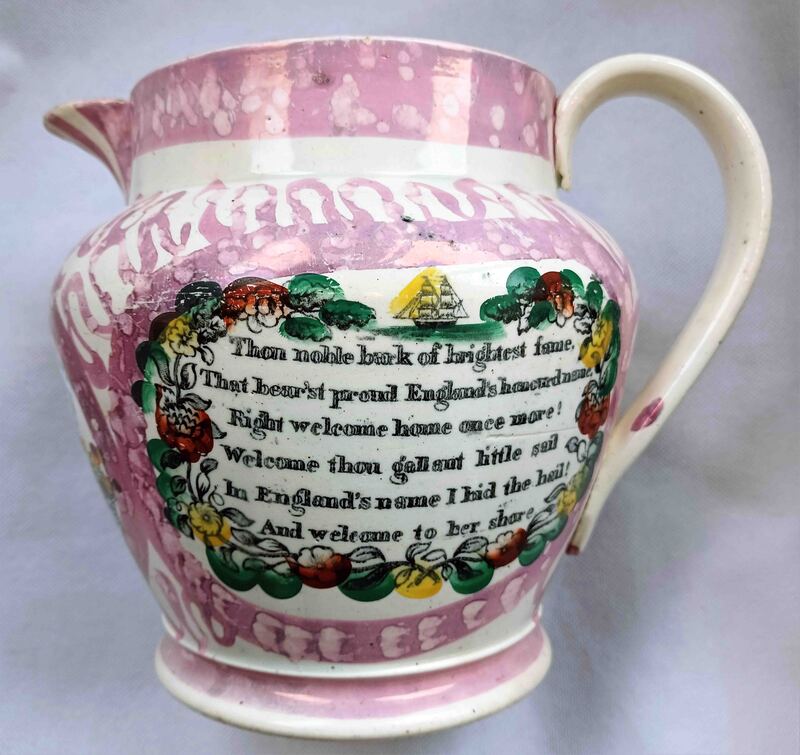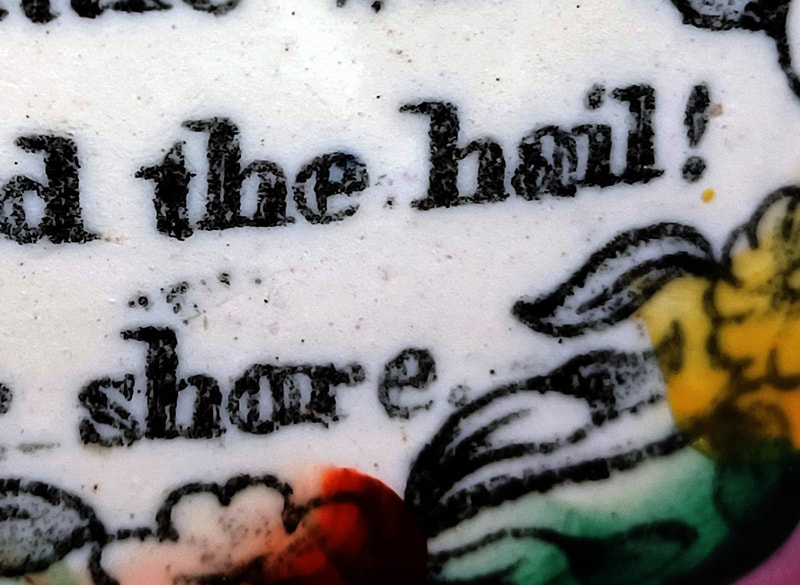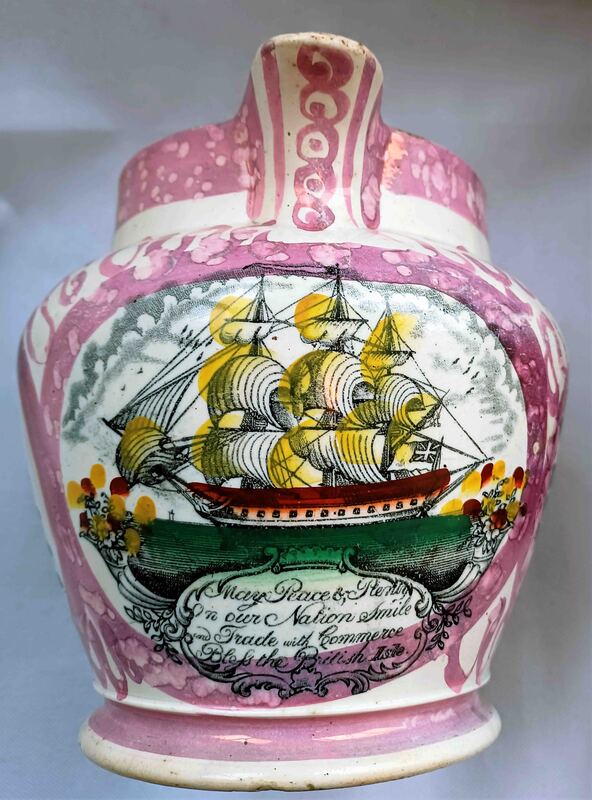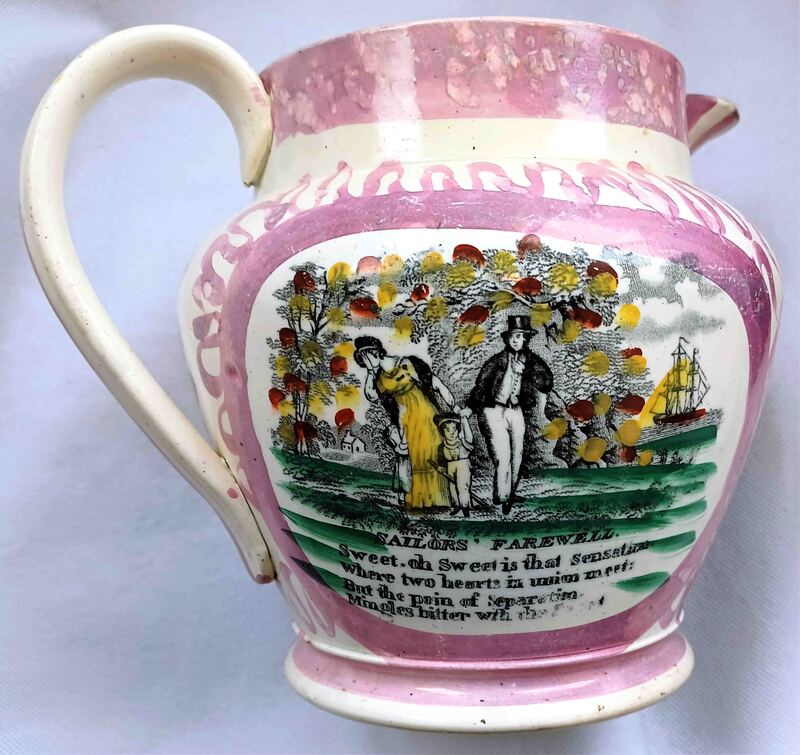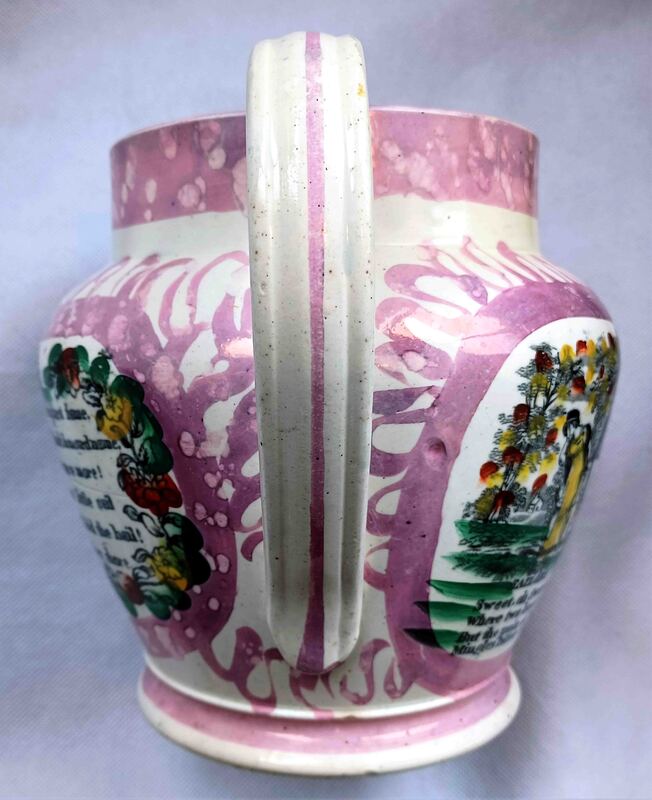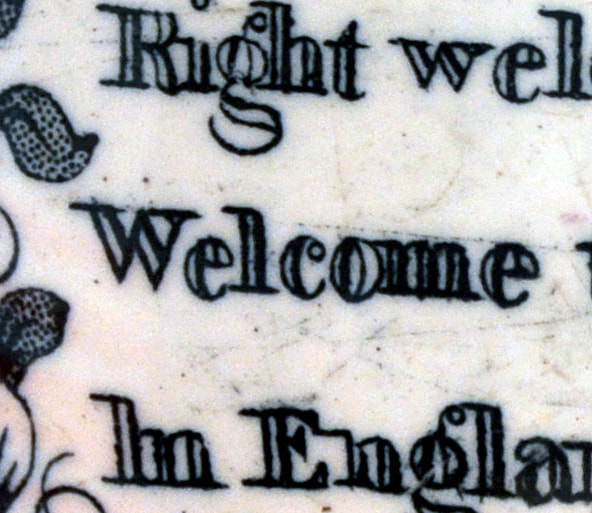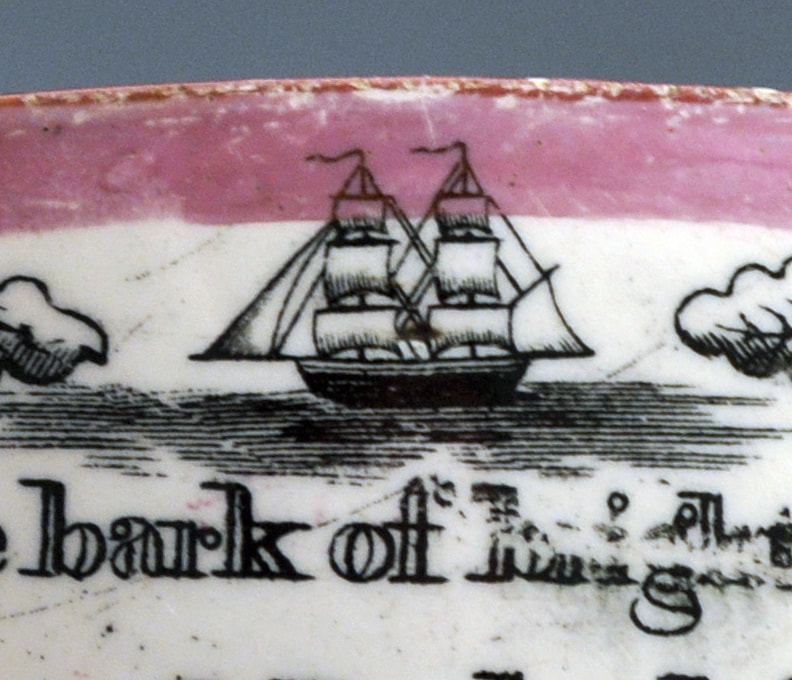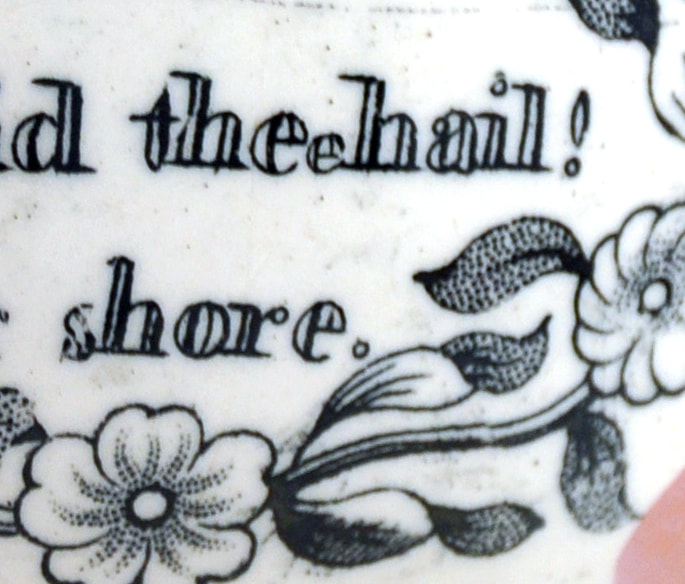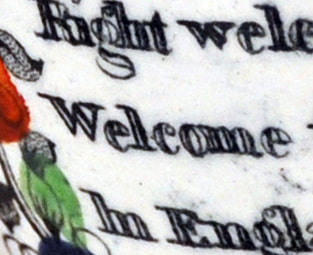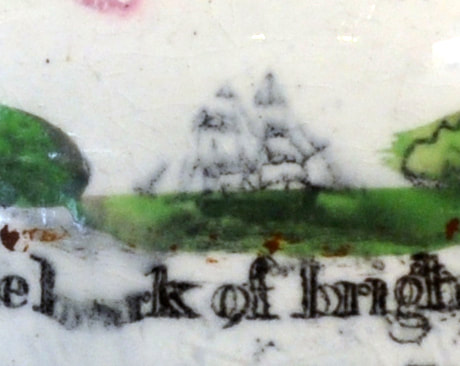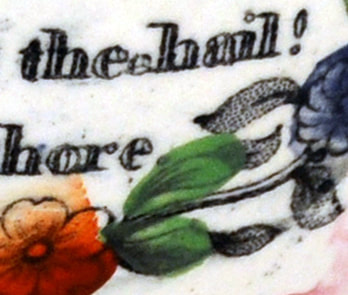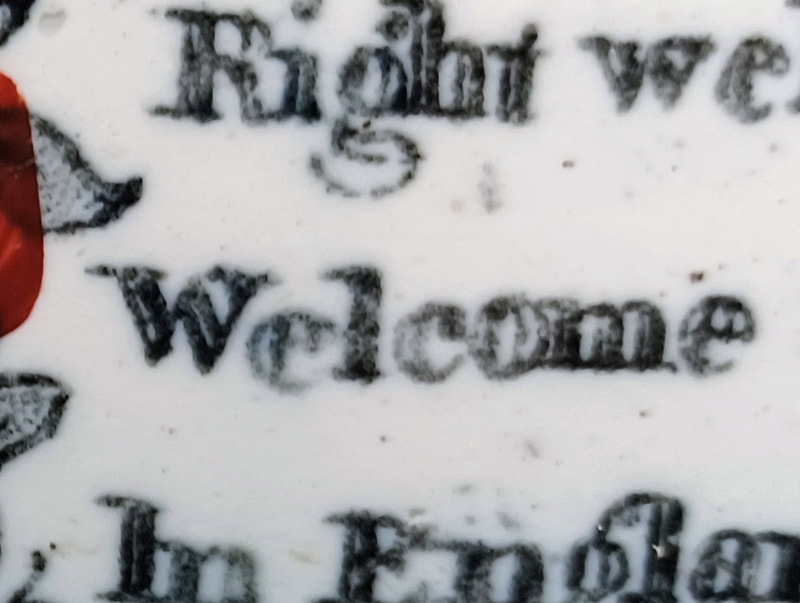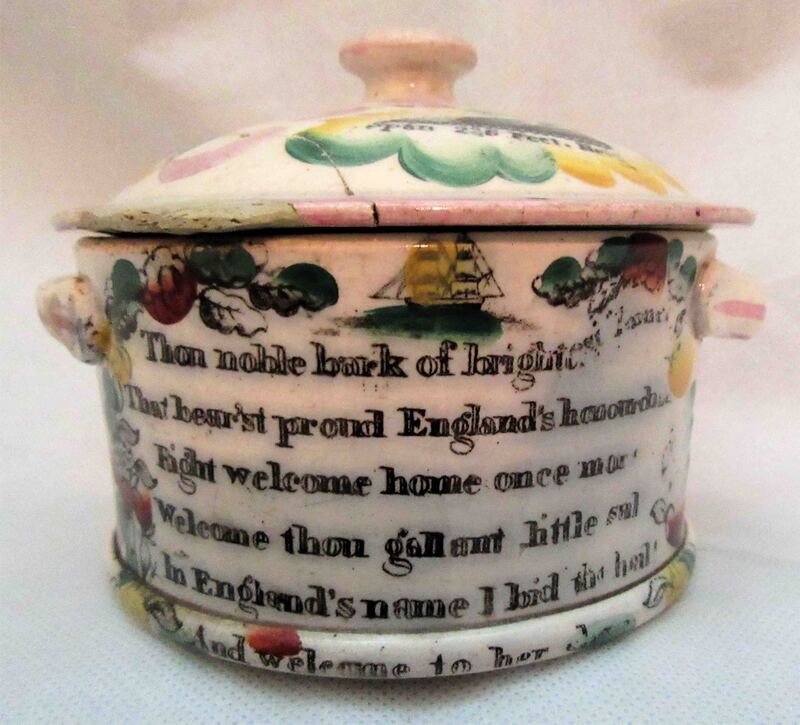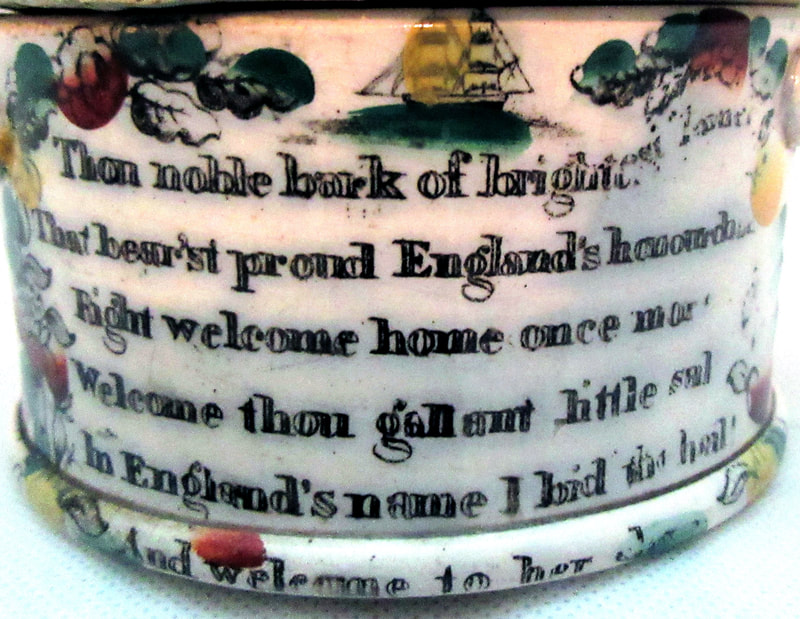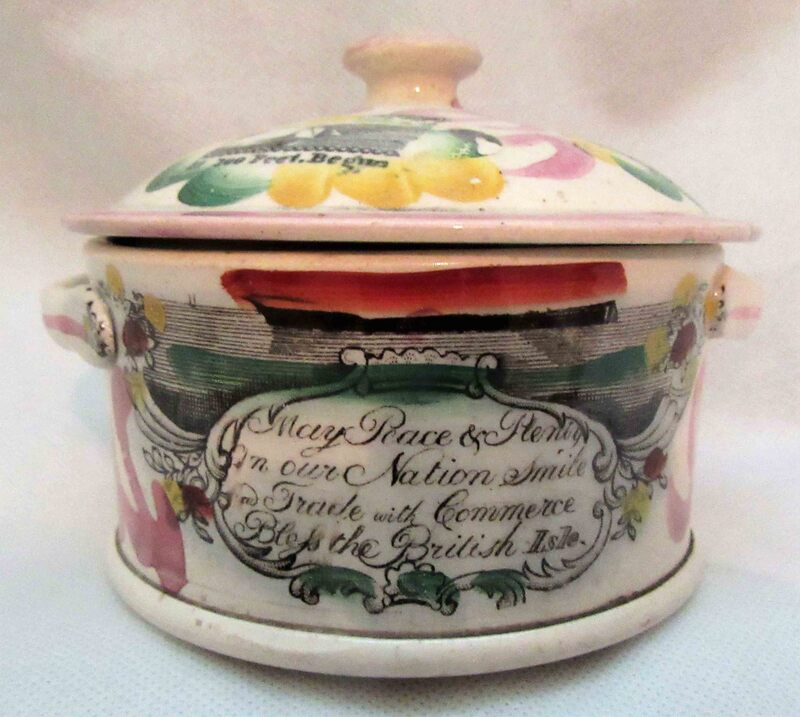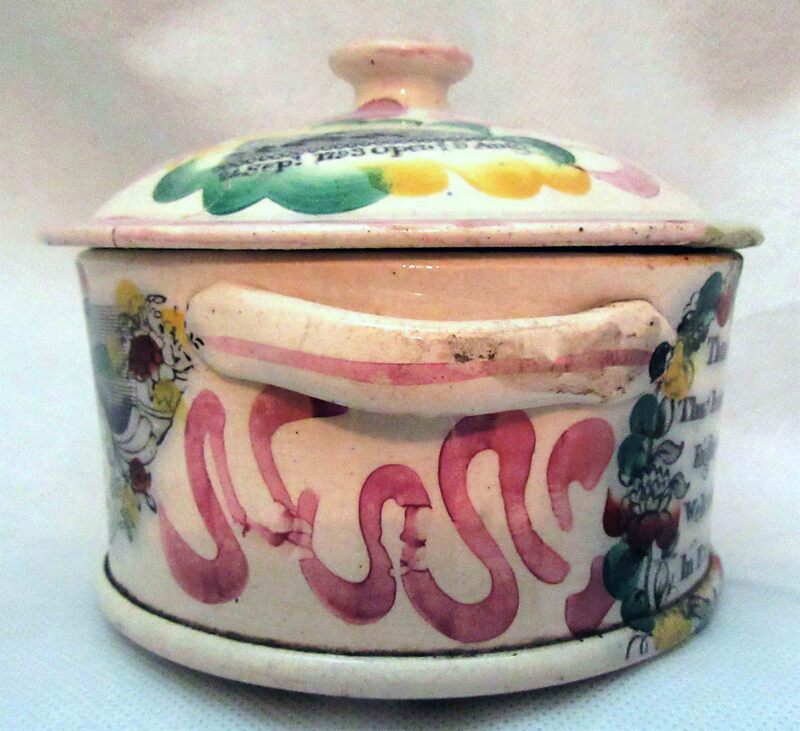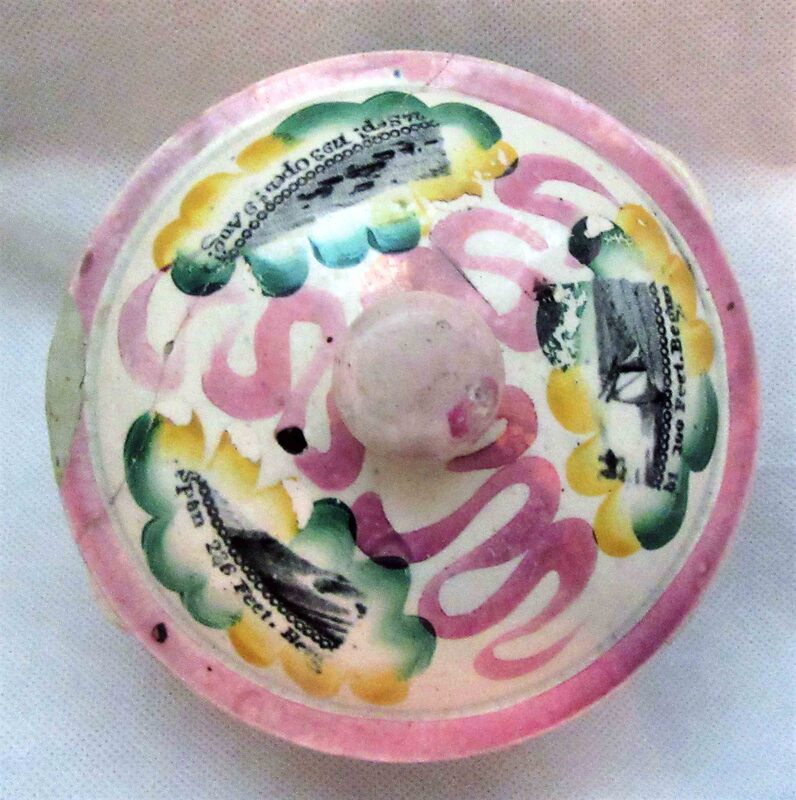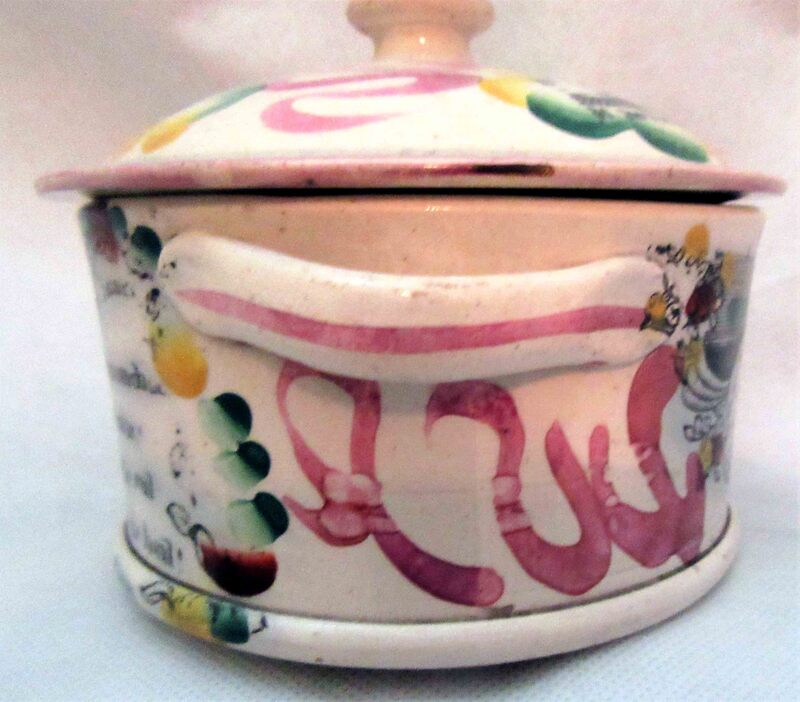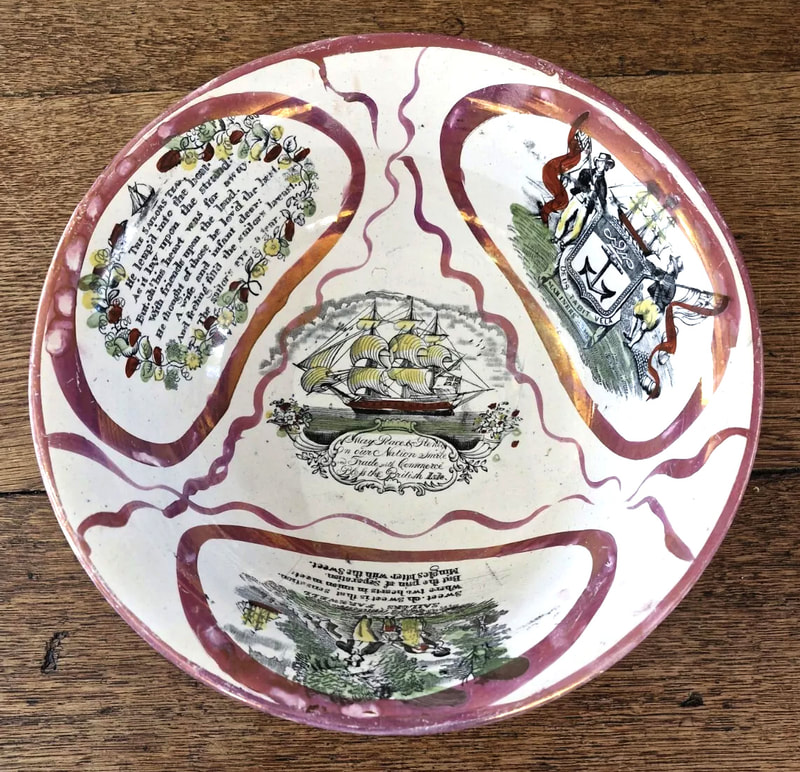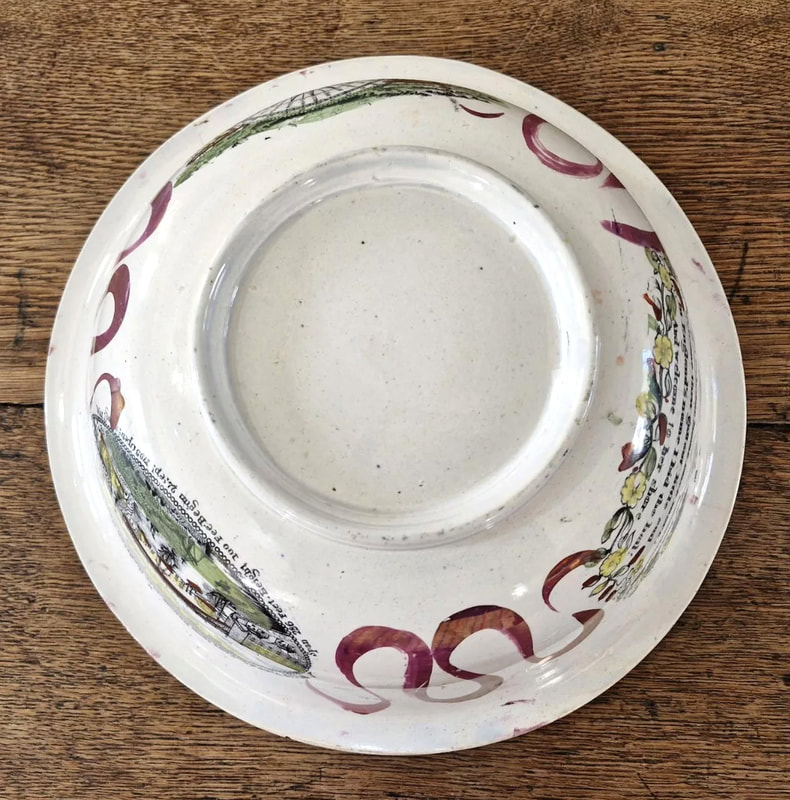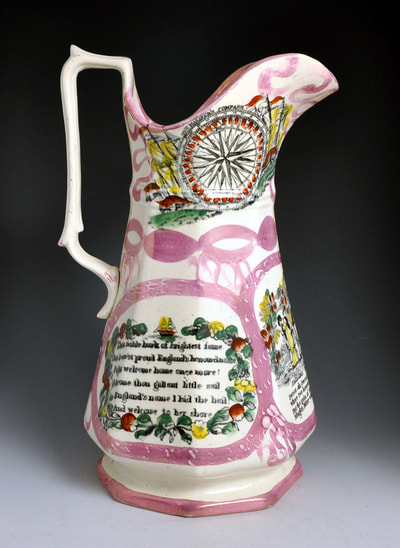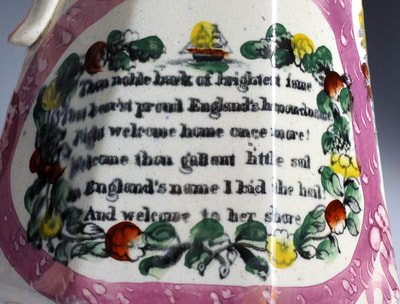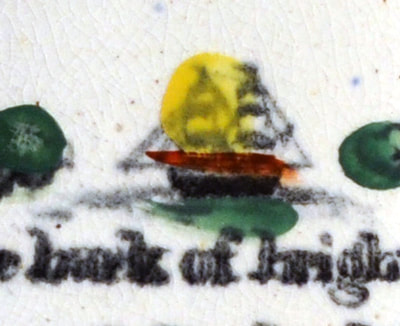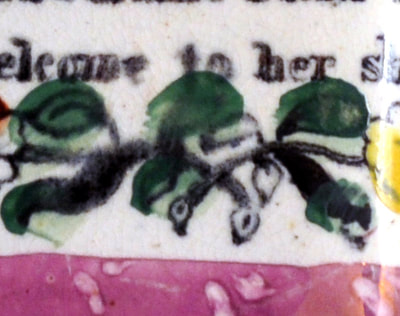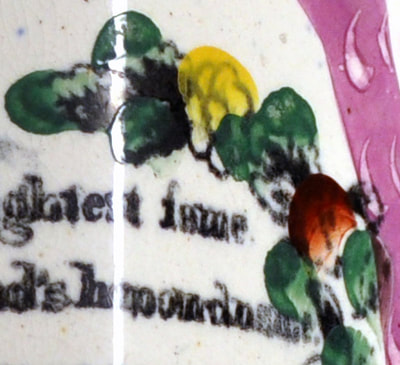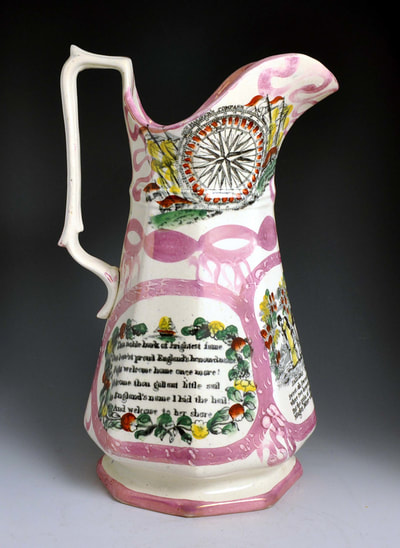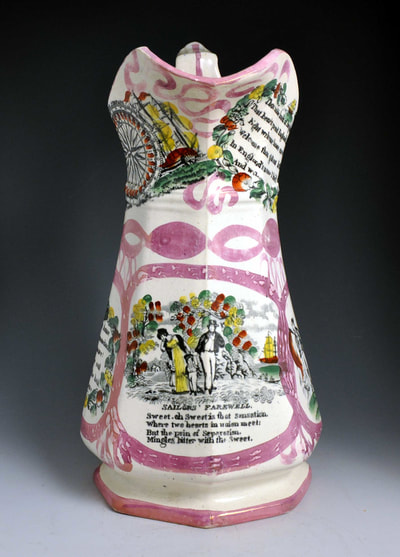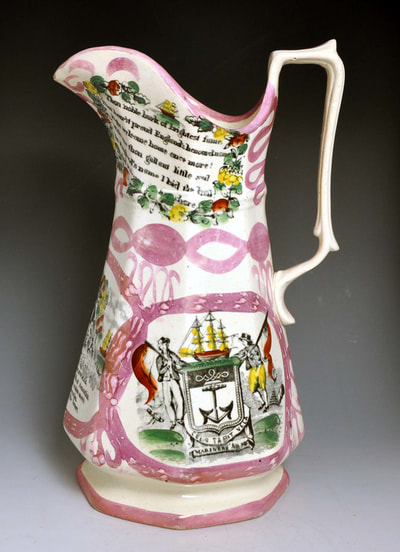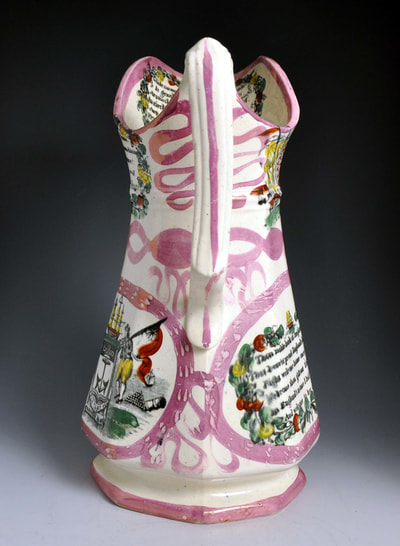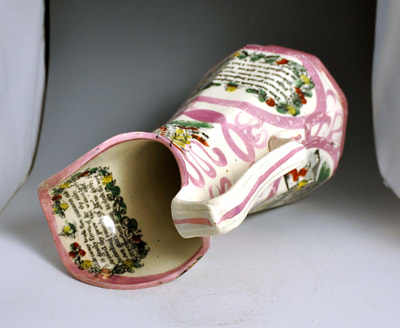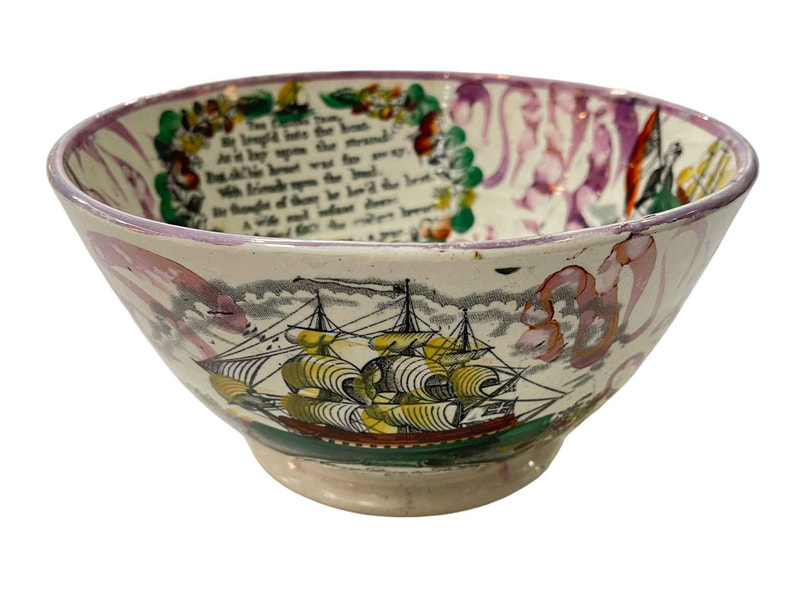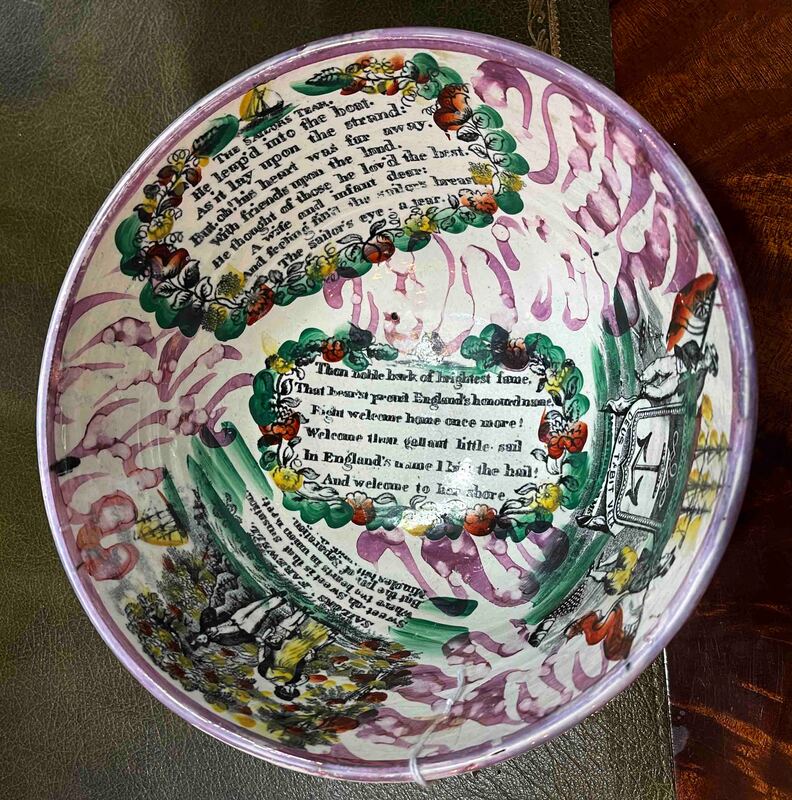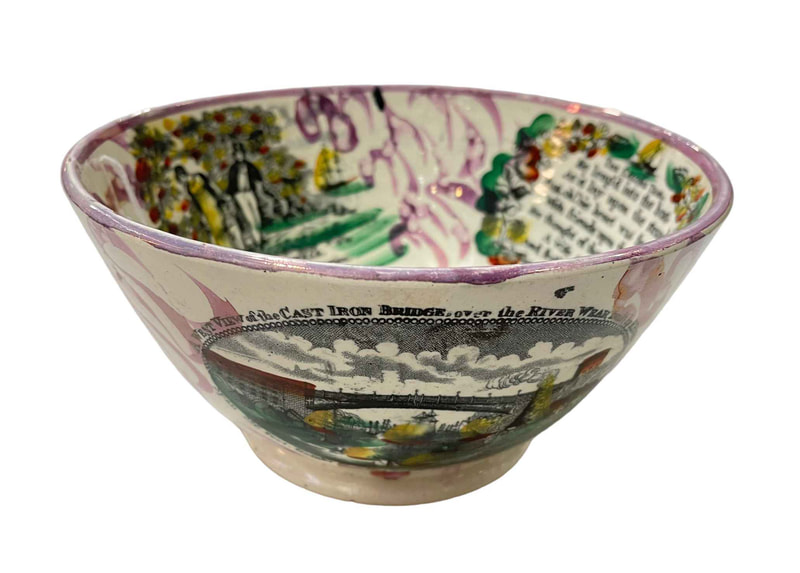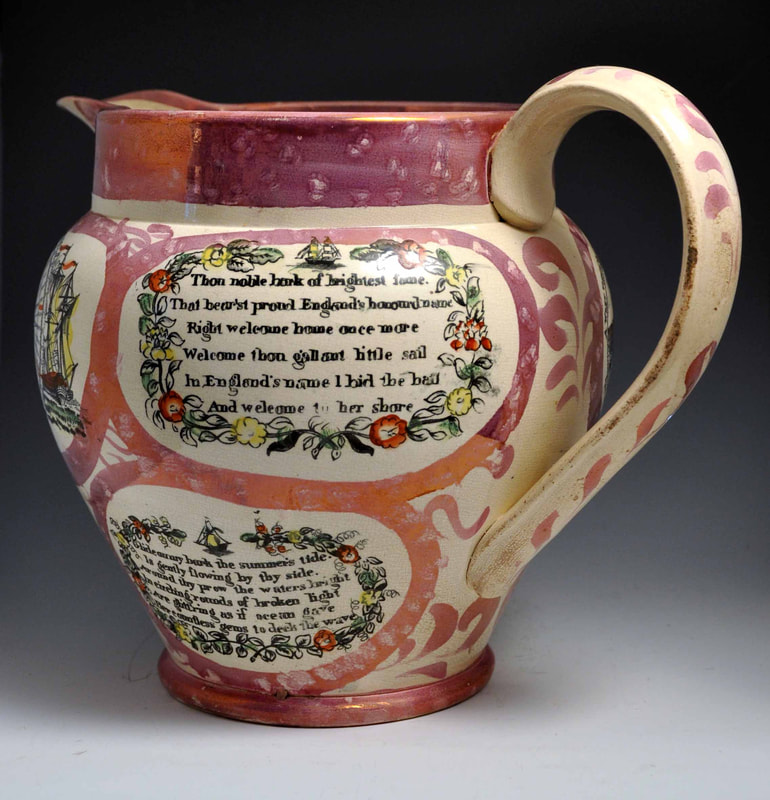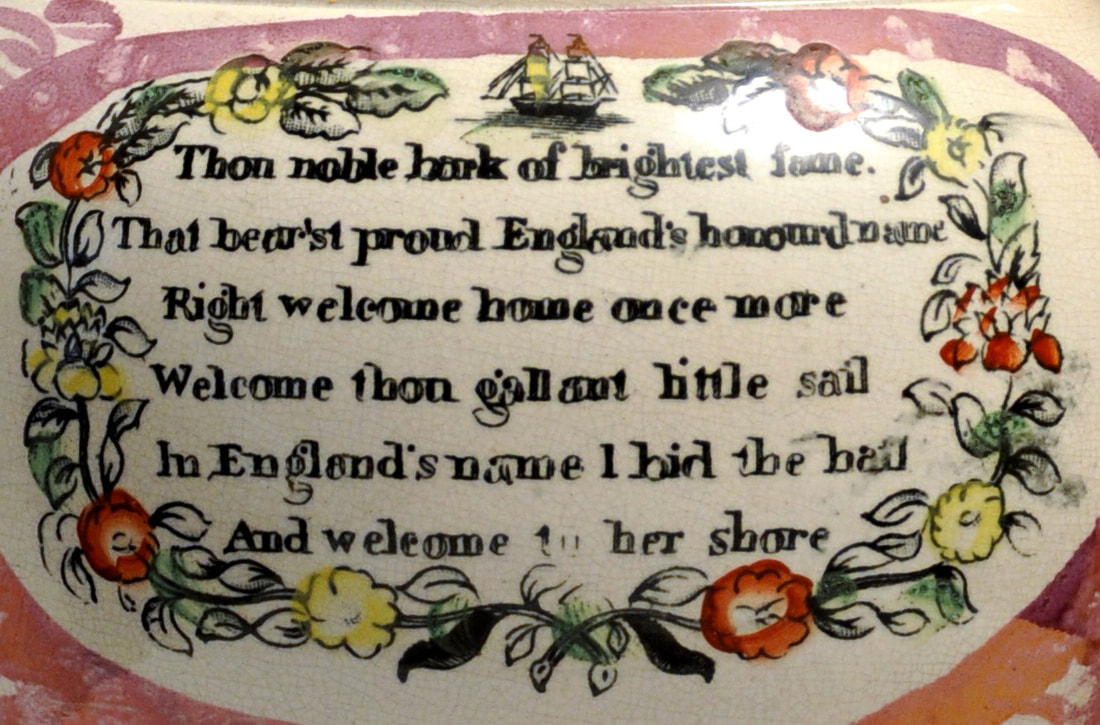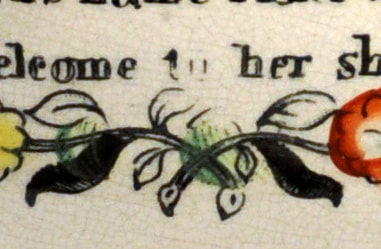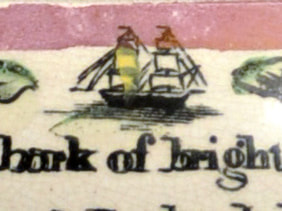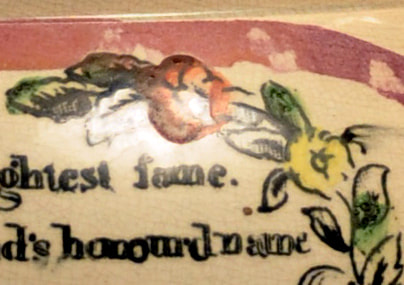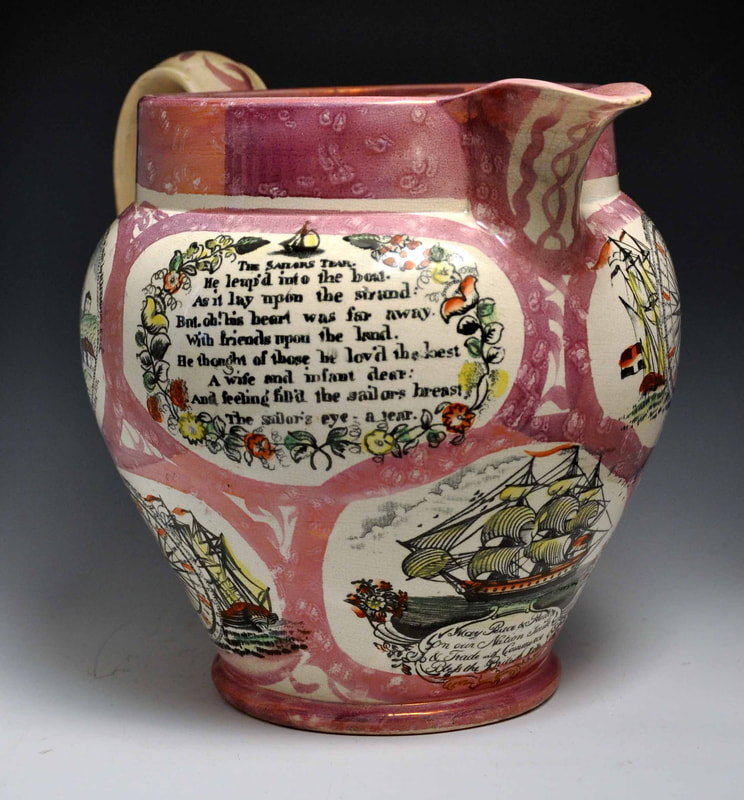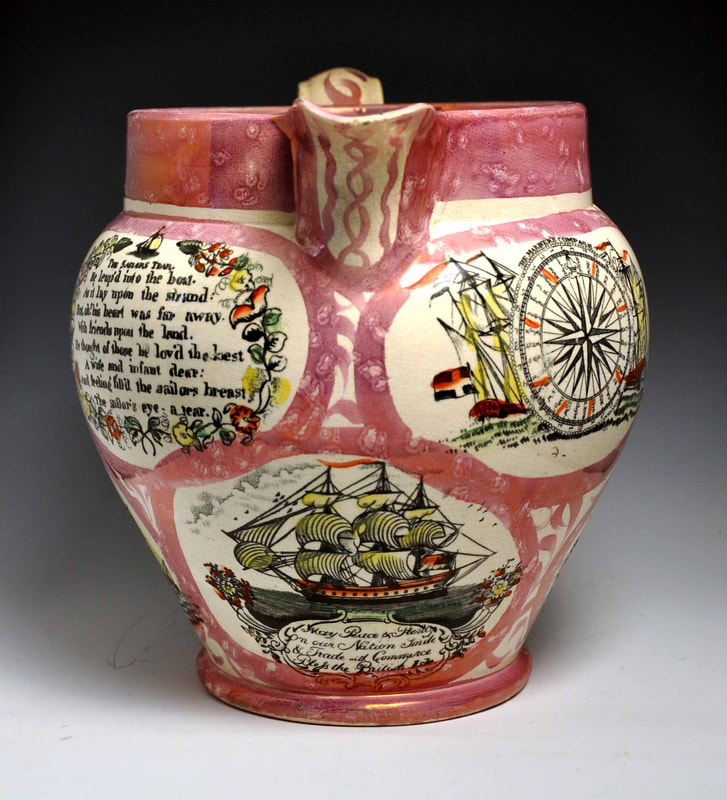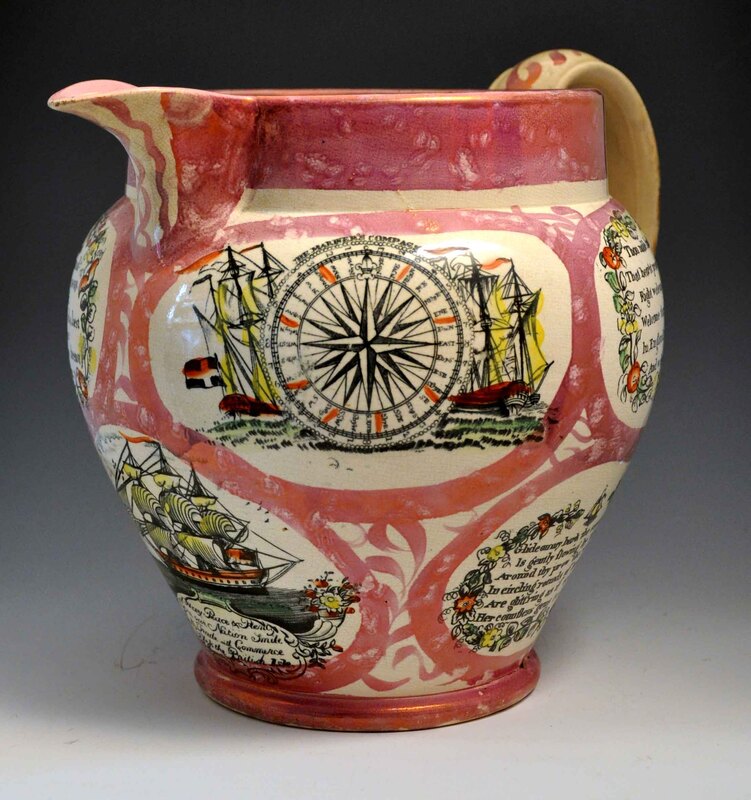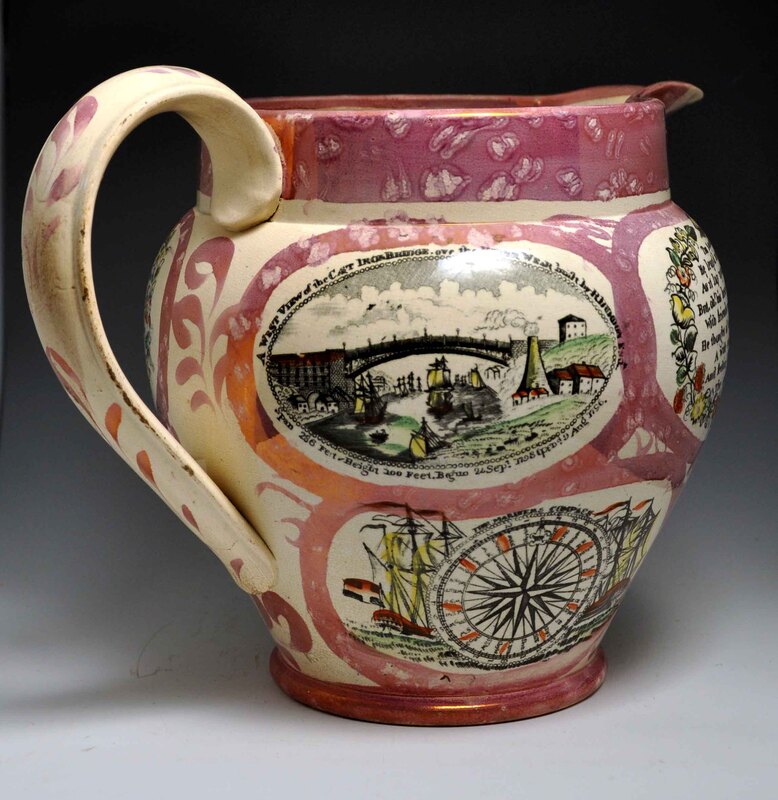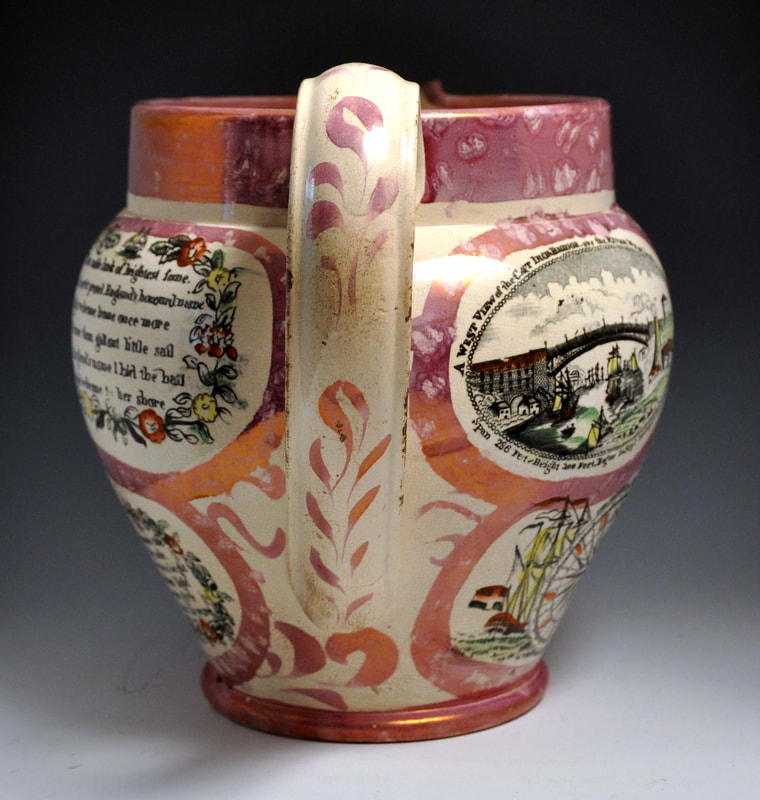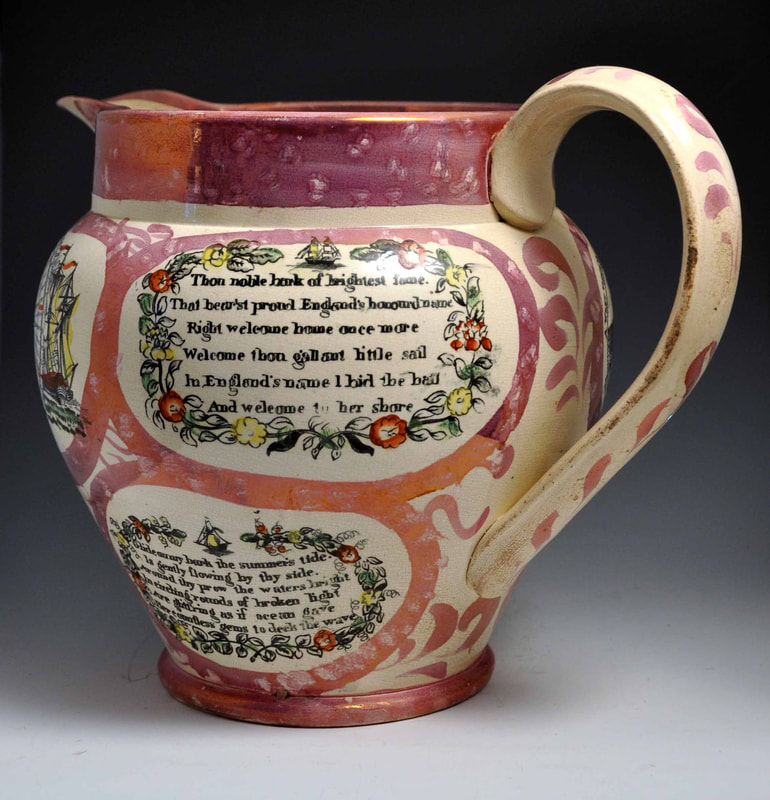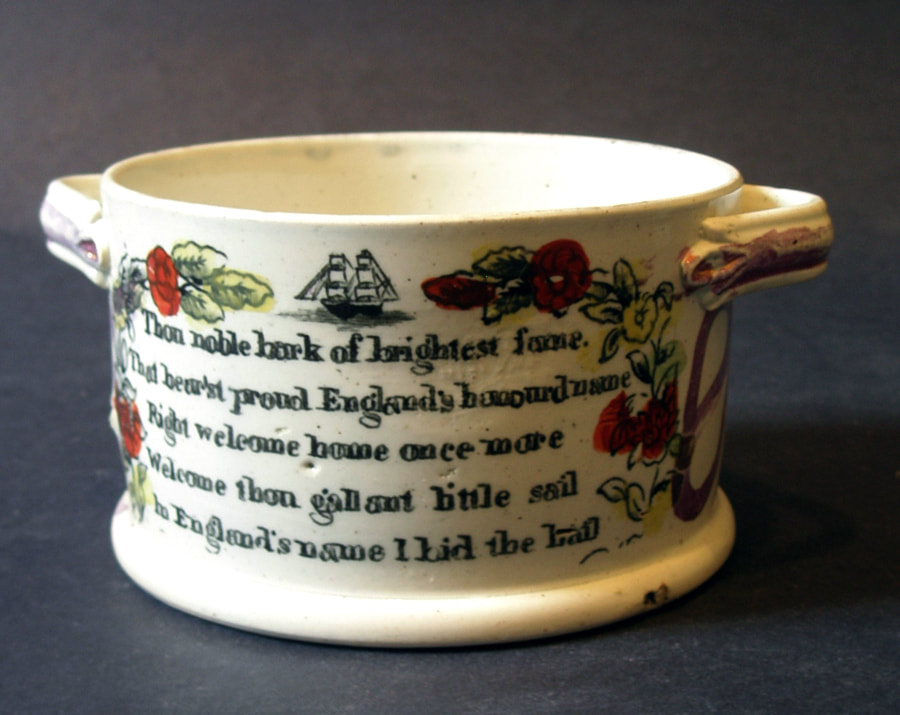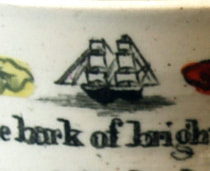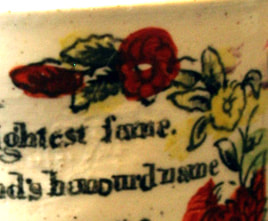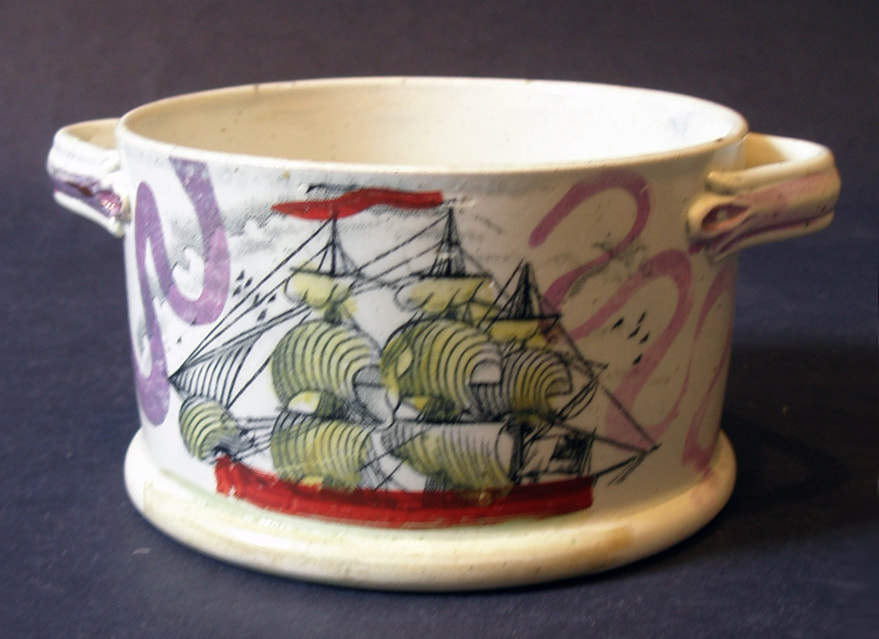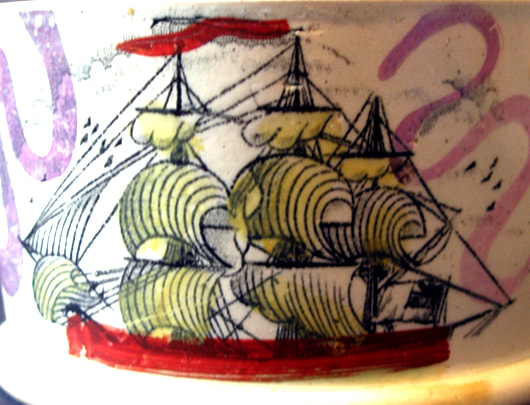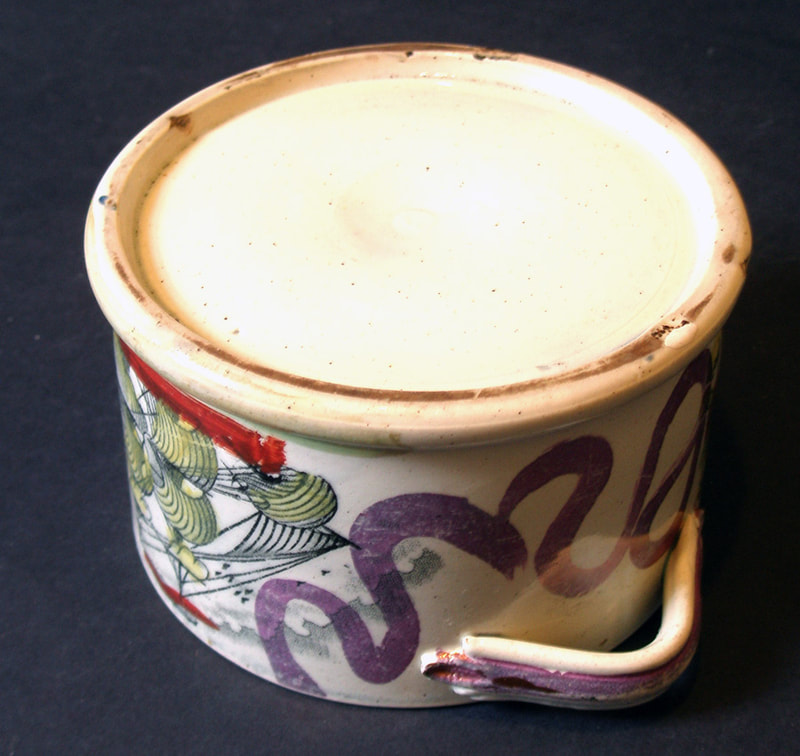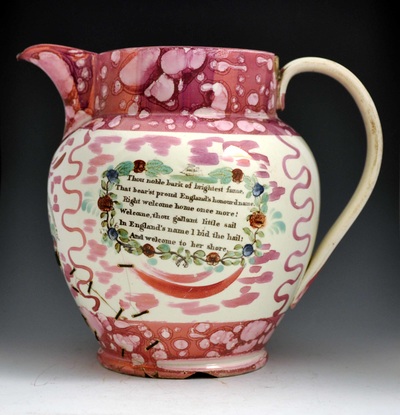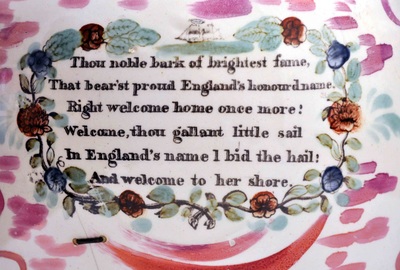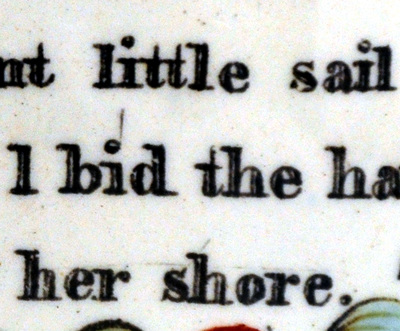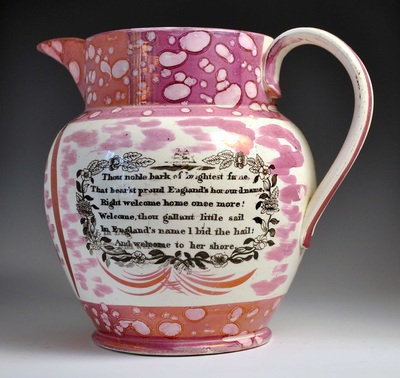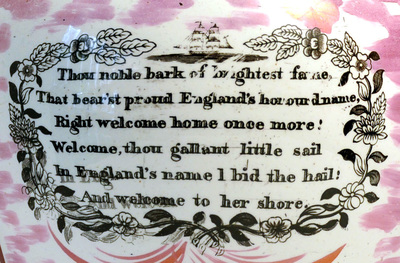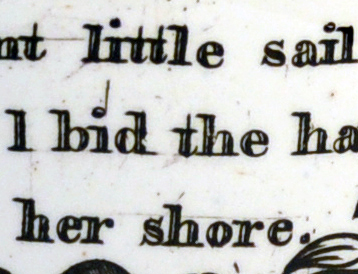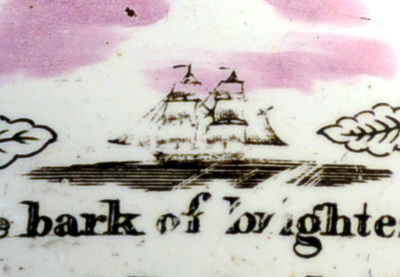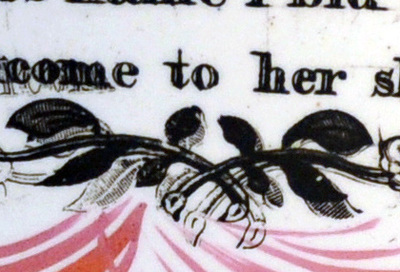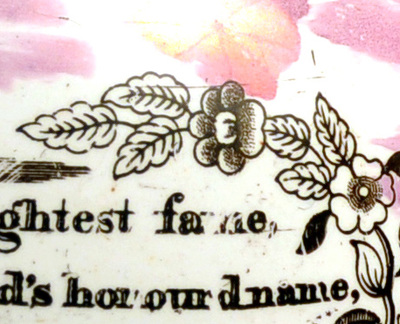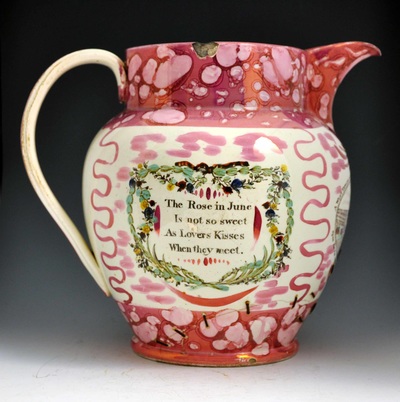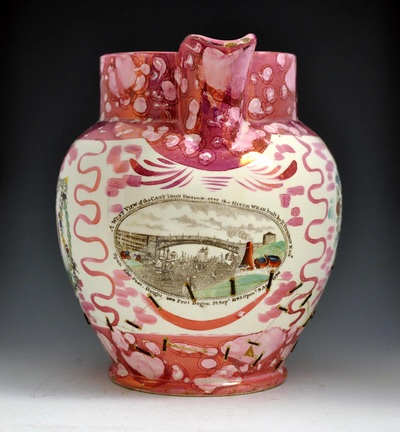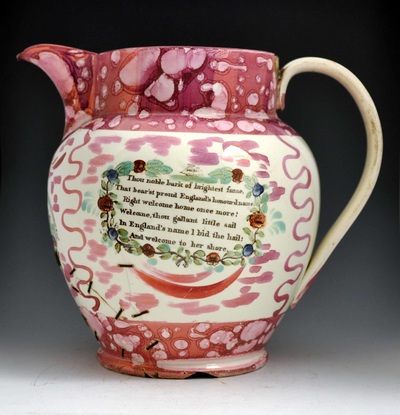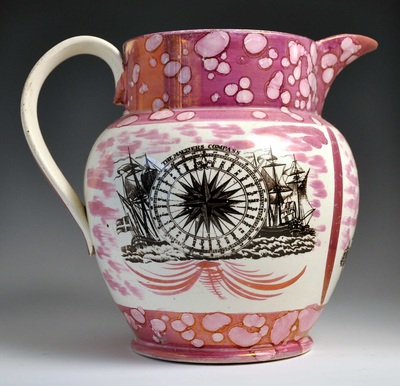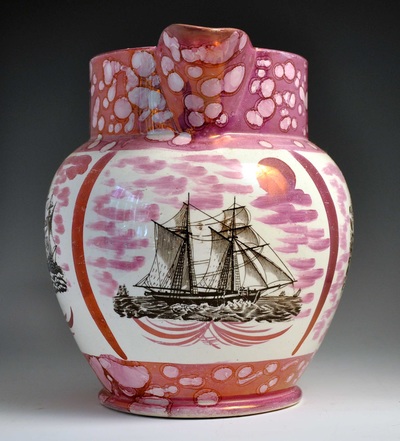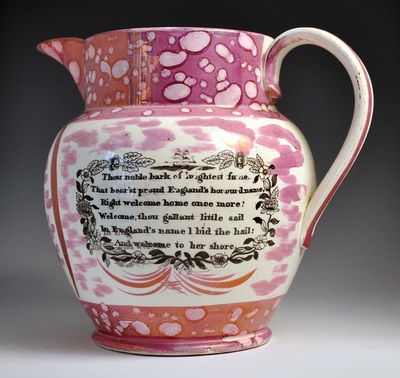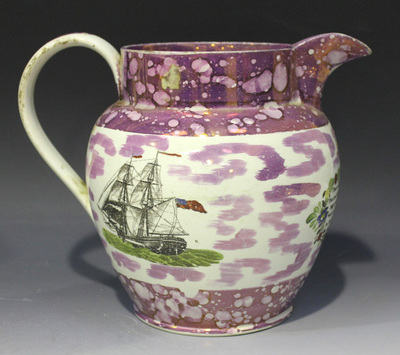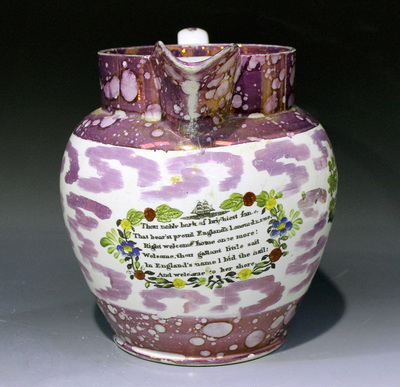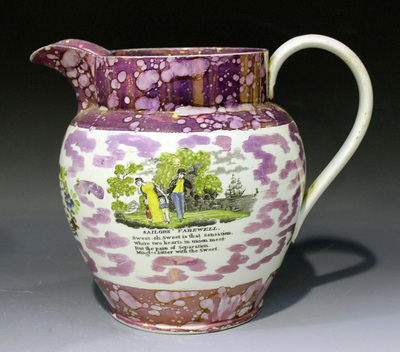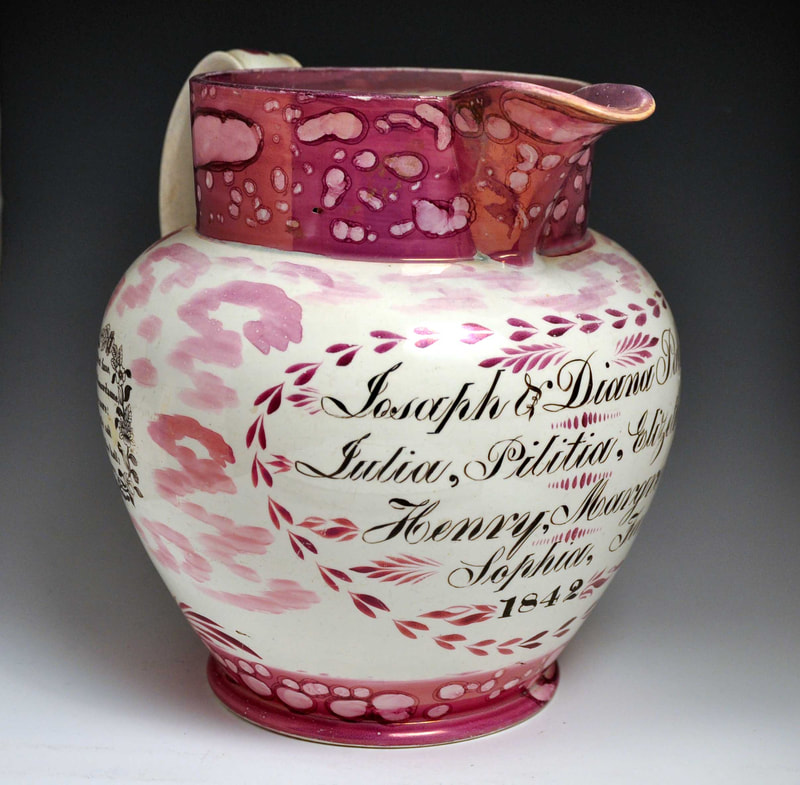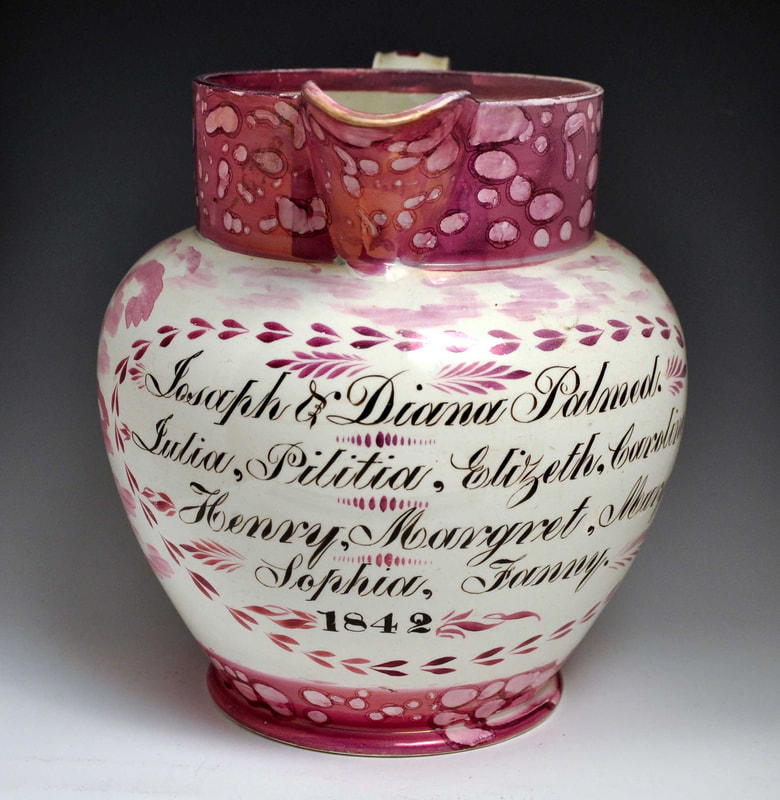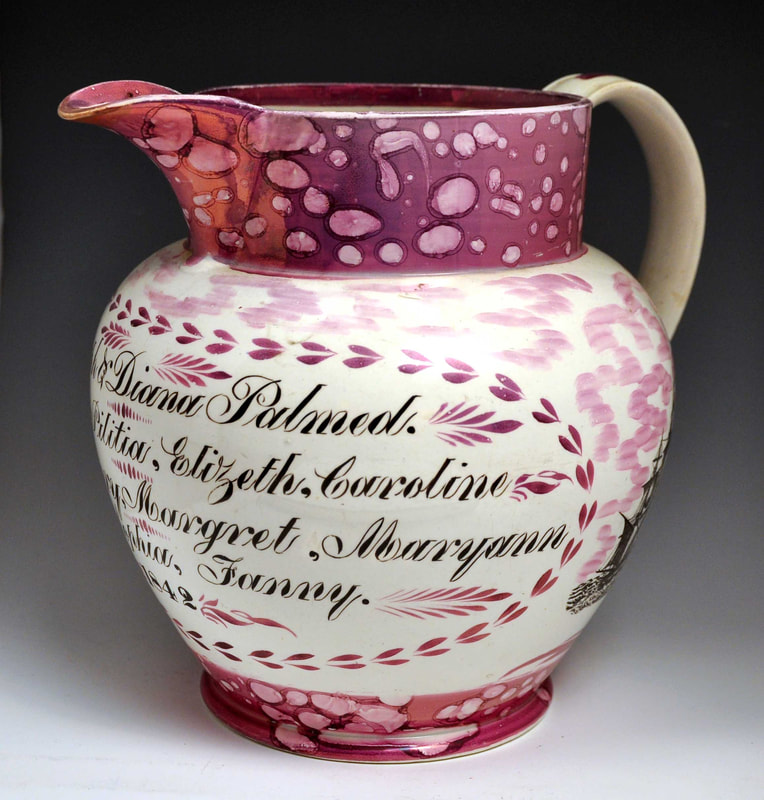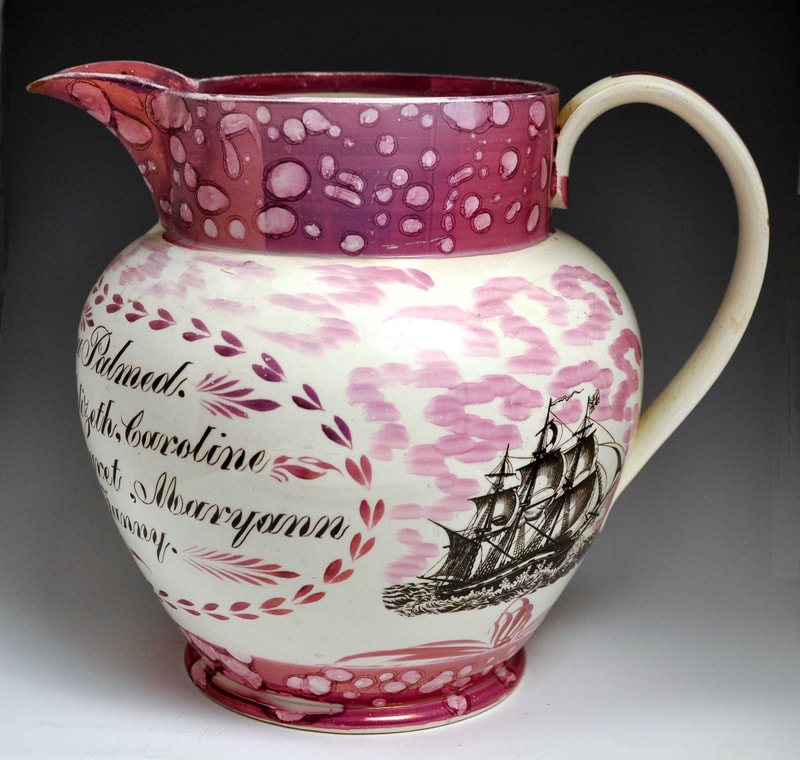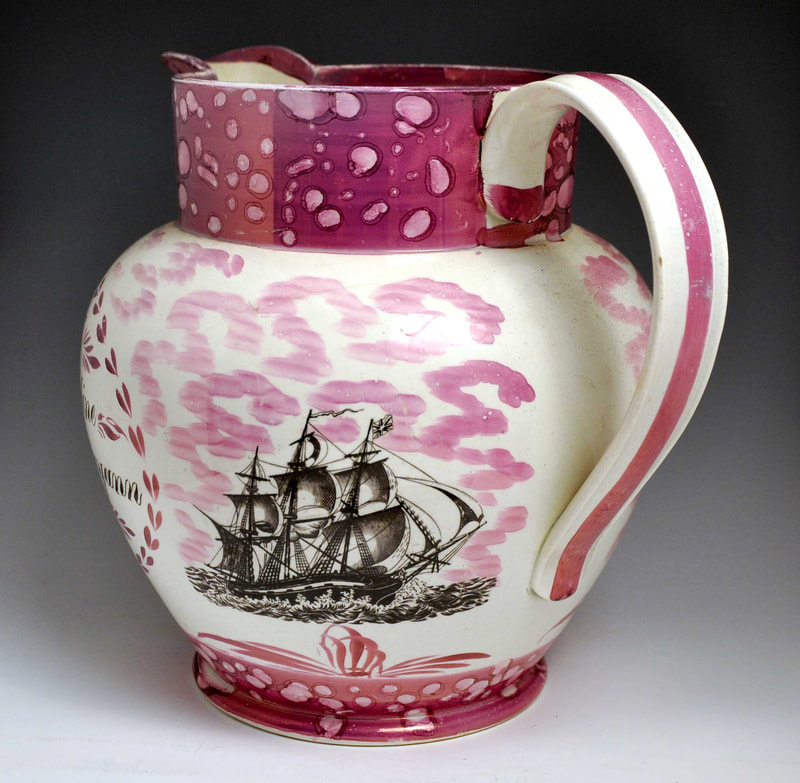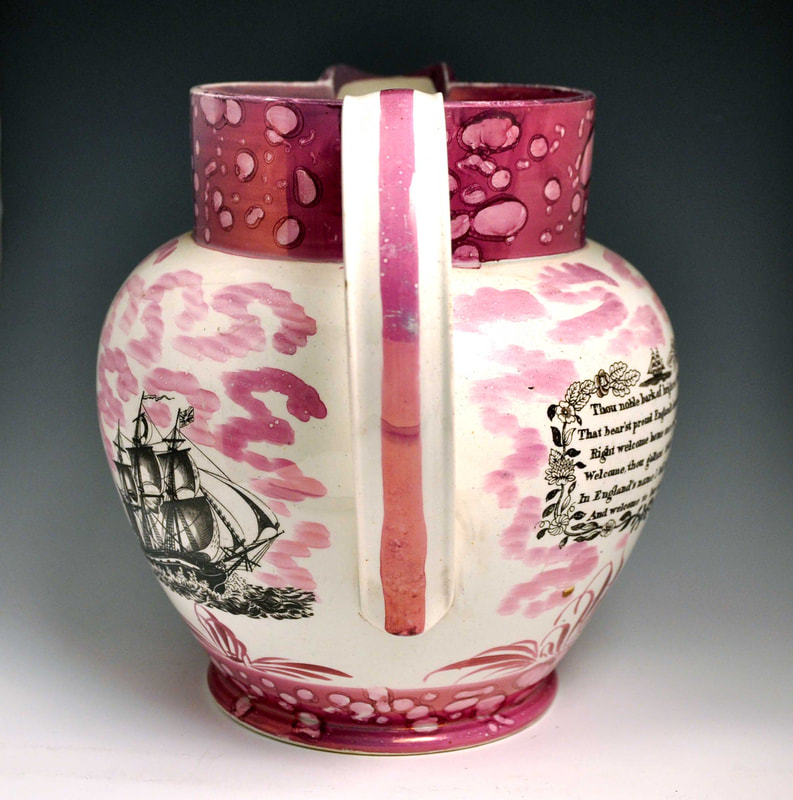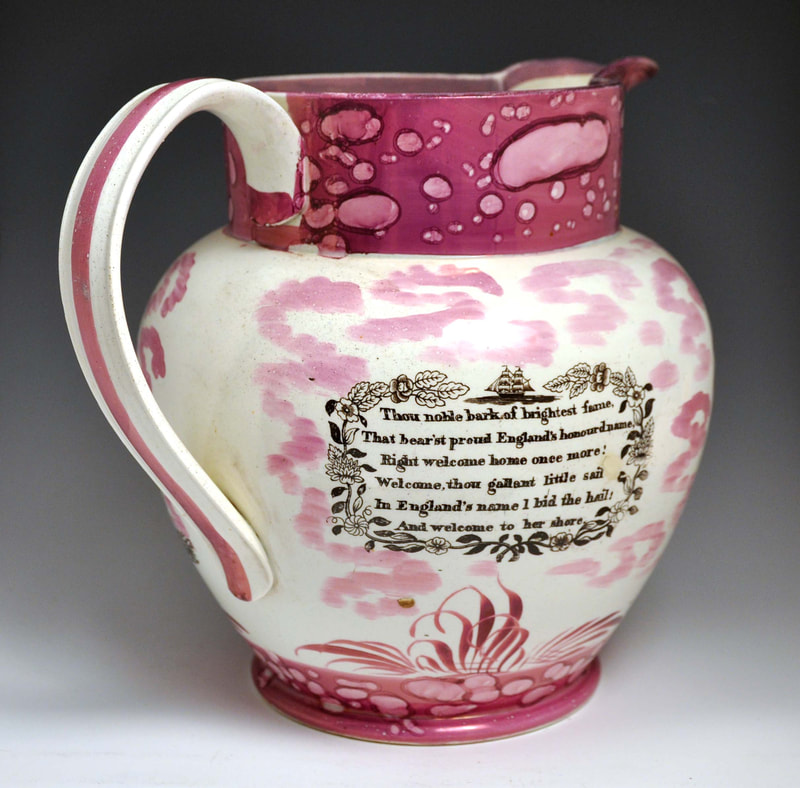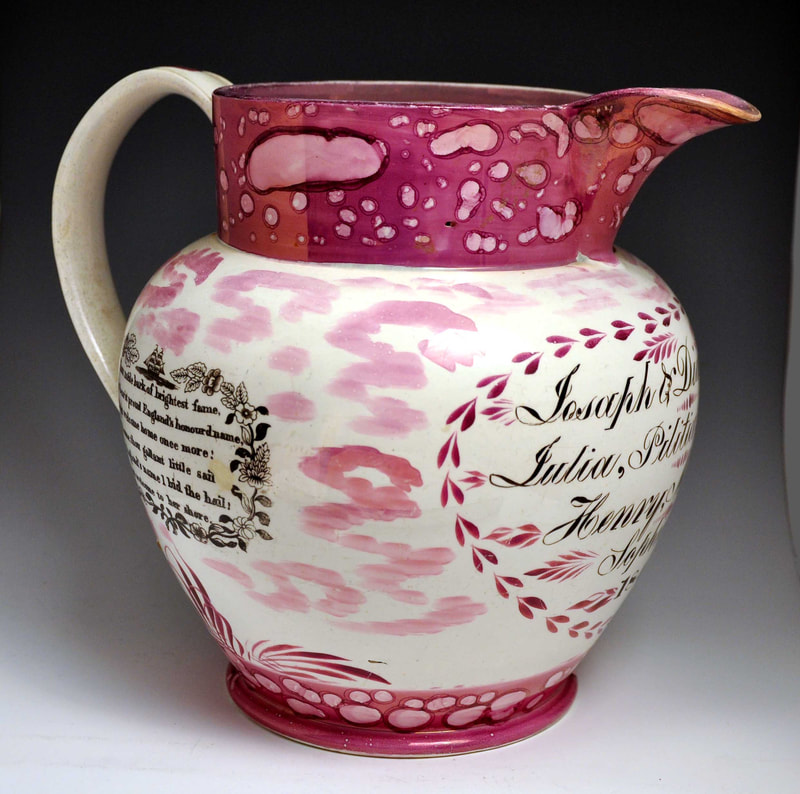Thou noble bark... – Sunderland
Garrison Pottery 1
- Half-shaded oak leaves at the top of the wreath.
- Oak leaves have rounded ends.
- Wavy shadow under the ship.
- Block letters with circles for dots on the letter 'i'.
Early imprints
There are two small nicks and scratches that don't appear on later items. Note the mark to the left of the dotted 'i' in 'bid' (all three details below) and the vertical scratch above the 't' in 'to' (last two details). The first detail is from the plaque above, the second and third from the eel pot and impressed bowl shown below.
The items below, from the mid to late 1840s. The Dixon, Phillips & Co anchor mark was used until about 1850. The last jug has an inscription for 1846.
Later imprints
There is a small nick under the 'b' in 'bear'st' that appears on the plaque above (left detail below) and the jug below with an inscription for 1851 (centre detail below). So the plaque appears to straddle the two groups. The flower-collared jug below (below right detail) has none of the nicks and scratches described here, so it is hard to guess exactly when it was made. Similarly, the bowl beneath it.
Garrison Pottery 2
Dixon appear to have used at least two almost identical copper transfer plates with this verse. The main difference between the two versions is that an additional 'e' squeezed into the penultimate line. The lines on the leaves are also different. The first detail below is from the plaque (Garrison 1) above, the second is from the Crimean bowl below, and third is from the jug with the Mariners' Arms below.
Moore and Co, Wear Pottery, Southwick
The jug has a printed mark 'Moore & Co, Southwick'. It predates Victoria's reign, which began in 1837, because the other verse on the jug begins 'Our King's a British tar'.
Newbottle Pottery
- Unshaded oak leaves at the top of the wreath.
- Oak leaves have pointed ends.
- Pointy ended shadow under the ship.
- Linear letters with single point dots on the letter 'i'.
Below, an unmarked bowl with very similar enamelling over the transfers to the jug above.
Below, a smaller jug with the transfer. The zig-zag decoration on the jug below is similar to that used by Moore's Wear Pottery. Read more here.
A Scott and Sons, Southwick Pottery
Baker dates the A Scott and Sons partnership at Southwick Pottery to 1829–41.
- Unshaded oak leaves at the top of the wreath.
- Oak leaves have pointed ends.
- Small shadow under the ship.
- Block letters with circles for dots on the letter 'i'.
- Printed mark 'S & Sons' 'Southwick'.
The images below show some of the other transfers that appear with this one. The last item is a marriage mug with the date 1837.
The mug below has a different, perhaps earlier, frog with red eyes, which appears to imitate those used by Dixon in the 1820s.
The transfer with a third variation of frog. See more about the different frog moulds here.
|
To the right, an undecorated mug with the transfer. It is likely that this item has firing flaws and was sold as a factory second.
|
|
Scott Brothers & Co, Southwick Pottery
The typical Scott jugs and mugs below have a noble bark transfer with the same attributes as the one above, except that the factory mark has been blacked out. NB the copper plate appears to have been re-engraved all over. It was likely done when the partnership changed to Scott Brothers and Co in 1841.
The final incarnation of this transfer appears on items from c1900, attributed to Ball's Deptford Pottery. Ball's recycled transfers from several of the Sunderland potteries.
Seaham Pottery
Below is the large Seaham jug in the Sunderland Museum, with the painted factory mark, Walker & Co, Seaham Pottery, 1847.
- Unshaded oak leaves at the top of the wreath.
- Oak leaves have rounded ends.
- Pointy ended shadow under the ship.
- Block letters with single point for dots on the letter 'i'.
Earlier imprints of the Seaham transfer with coloured enamels.
Thou noble bark... – Tyneside
Attributed to Redhead, Wilson & Co, Forth Banks, Newcastle Pottery – 1833–1838
|
The mottled quality of the lustre is typical of Newcastle. See the Mariner's Arms page for a note on the enamelling. The green spotted frog is unusual. The 'g' and 'l' in 'England's' overlap in this version of the transfer. See details (right) of the two mugs below. |
Unidentified pottery
I haven't recorded any other items with an inscription in this hand. The bridge view 29 is very similar to that found on Newbottle items.
John Carr and Sons, North Shields – plate 1 (Seaham transfer)
This transfer comes from the same copper plate as the Seaham-attributed items above (note the horizontal scratch above the 'l' in 'little'). However, the bowl below was likely made after the pottery's closure, which appears to be c1852. The London impressed mark was used by several Tyneside potteries when making wares for a London retailer. This particular impress is know to have been used by Carr, so the bowl is likely North Shields, c1860.
This unmarked bowl has a set of Seaham transfers including bridge 29. The bridge on the outside of the bowl (bridge 14), is a Carr version of a transfer usually associated with Dixon.
Various nicks and scratches on the transfer on the pedestal bowl below, show it to be from the same copper plate as the bowls above. The wavy decoration is typical of Carr & Sons in the 1870s, and is often seen on orange lustre items. See a 'plate 2' example below.
John Carr and Sons, North Shields – plate 2
Although this jug has an inscription with a birth date of 1824, Sophie Mahy is the person's married name. The jug was likely made in the 1850s.
|
|
This version of the transfer has no dot on the letter 'i' in 'bid'. (I am reliably informed by my cousin that the dot over a lower case 'i' or 'j' is called a tittle.) Inscriptions of French names are common on these jugs from the 1840s and 50s, as there was a great trade of North East pottery with the Channel Islands. |
A perhaps more familiar looking Carr jug from the 1840s, with a small ship transfer under the spout.
This bowl appears to be a later imprint from the same transfer plate. The bowl has an impressed London mark with fouled anchor, known to have been used by Tyneside potteries when selling items via a particular London distributor, c1860.
John Carr and Sons, North Shields – plate 3
It's always difficult to unravel these transfers as the copper plates were typically re-engraved and restored over decades. However, looking at the other transfers on this bowl, eg Gardeners' Arms, and comparing them to the London-marked bowl above, it appears that Carr had a new copper plate made up sometime in the 1860s. See also the Mariners' Arms page. This bowl, with the John Carr and Sons impressed mark with stag's head, appears to have a later variant of the transfer above. There is still no dot on the 'i' in 'bid'. However, note that the oak leaf to the left of the ship now has a pointed end.
A bowl from c1870s with orange lustre, again with a John Carr and Sons mark with stag's head. The bowl has a degraded and later imprint from the same copper plate as the bowl above.
Another similar bowl with the stag's head impress.
An unmarked orange lustre mug with strap handle.
John Carr and Sons, North Shields – plate 4 (Garrison 2 transfer)
The imprints on this bowl are faint and degraded, but they appear to come from the Garrison Pottery 2 copper plate. The extra 'e' in 'thee' in the penultimate line (last detail) has all but faded. A couple of further points to note. The 'b' and 'r' in 'bright' are pushed in tight together. Unlike the transfers on impressed Carr items, there is a dot over the 'i' in the word 'bid'.
Although the imprint on the jug below is crisper, I believe it is later, and that the copper plate had by this point been re-engraved (read more below).
On the first two rows below are details from the 'Garrison 2' plate (first row, c1855; second row, c1865 ), the third row is from the Carr bowl with the faded imprint, and the fourth row, from the jug above with the reengraved transfer plate. The first point to note is the dropped 'e' in the word 'Welcome' in the left details. That is a feature peculiar to the Garrison copper plates (1 & 2). Secondly, it appears that the afterthought of a second 'e' squeezed into the word 'thee' was superficially engraved, and had already started to fade by the time the copper plate left the Garrison Pottery in 1865 (see second row, right detail). By the time Carr had the plate re-engraved, it was forgotten altogether (see last detail).
Below a lidded pot with an imprint from the reengraved copper plate.
An unmarked bowl with a crisper re-engraved imprint of the transfer.
John Carr and Sons, North Shields – plate 5
The transfer is very similar to the one above. However, the shading of the leaves under the word 'welcome' (centre detail) is obviously different.
The other transfers on this Carr wash ewer, c1870, are shown below. NB the Mariner's Compass on this transfer plate has a misspelt motto 'Deus Tabit Vela' instead of the correct 'Deus Dabit Vela' (God will give sail).
An unmarked bowl with the transfer, again paired with the misspelt Mariner's Compass.
John Carr and Sons, North Shields – plate 6
The eel pot below appears to have the same version of the transfer, but cut short to fit.
Thomas Fell, St Peter's Pottery
- Unshaded oak leaves at the top of the wreath.
- Oak leaves have pointed ends.
- Long curvy shadow under the ship.
- Block letters with circles for dots on the letter 'i'.
Fell pottery is typified by profuse lustre decoration, and sooty black transfers. Note the distinctive squiggle decoration on the first jug below, and the painted lustre sun above the ship on the second jug.
Finally, the transfer on a large jug with an inscription dated 1842.
